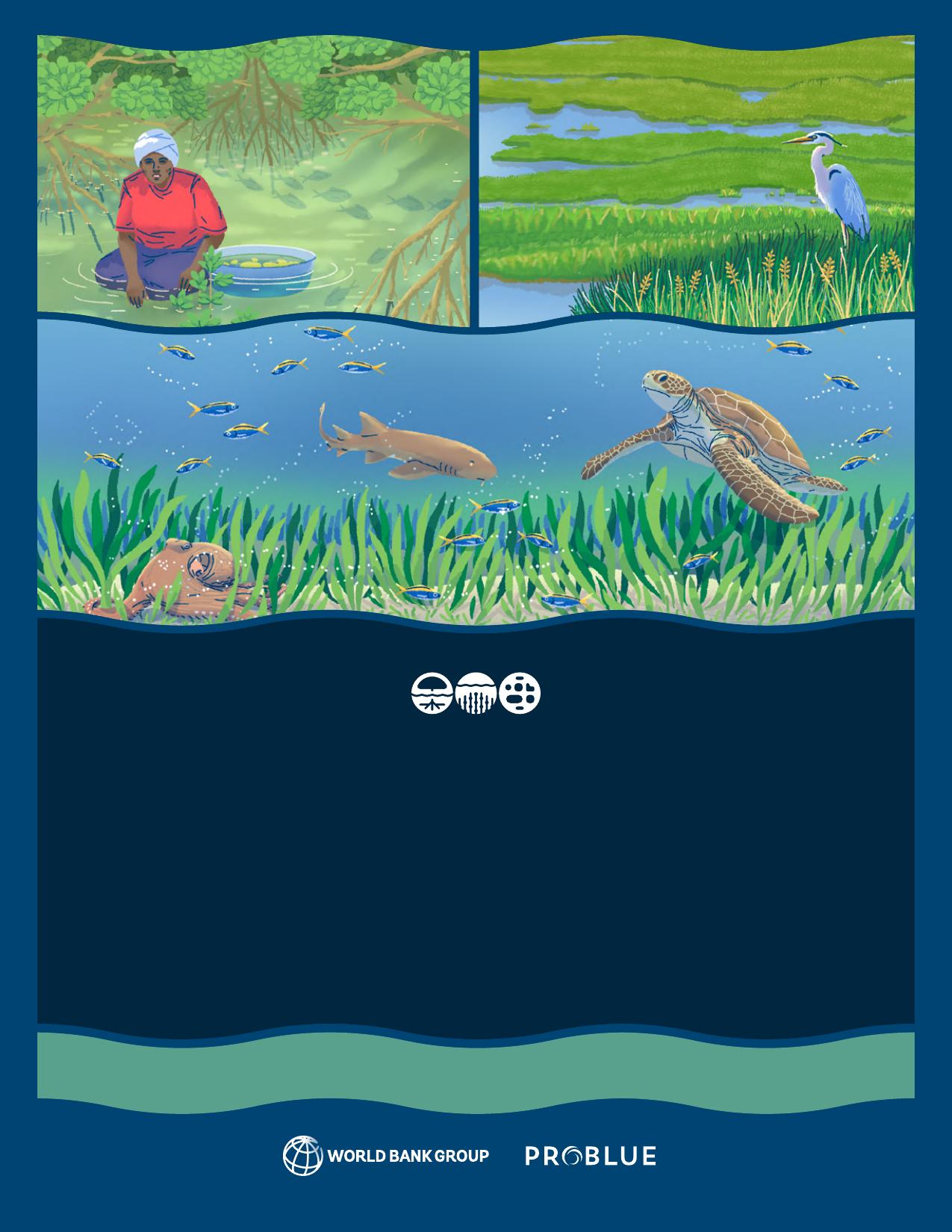UNLOCKINGBLUECARBONDEVELOPMENTINVESTMENTREADINESSFRAMEWORKFORGOVERNMENTSPublicDisclosureAuthorizedPublicDisclosureAuthorizedPublicDisclosureAuthorizedPublicDisclosureAuthorized©2023TheWorldBankGroup1818HStreetNW,WashingtonDC20433Telephone:202-473-1000Internet:www.worldbank.orgThisworkisaproductofthestaffofTheWorldBankGroup,withexternalcontributions.“TheWorldBankGroup”referstothelegallyseparateorganizationsoftheInternationalBankforReconstructionandDevelopment(IBRD),theInternationalDevelopmentAssociation(IDA),theInternationalFinanceCorporation(IFC),andtheMultilateralInvestmentGuaranteeAgency(MIGA).TheWorldBankGroupdoesnotguaranteetheaccuracy,reliabilityorcompletenessofthecontentincludedinthiswork,ortheconclusionsorjudgmentsdescribedherein,andacceptsnoresponsibilityorliabilityforanyomissionsorerrors(including,withoutlimitation,typographicalerrorsandtechnicalerrors)inthecontentwhatsoever,orforreliancethereon.Theboundaries,colors,denominations,andotherinformationshownonanymapinthisworkdonotimplyanyjudgmentonthepartoftheWorldBankGroupconcerningthelegalstatusofanyterritoryortheendorsementoracceptanceofsuchboundaries.Thefindings,interpretations,andconclusionsexpressedinthisvolumedonotnecessarilyreflecttheviewsoftheorganizationsoftheWorldBankGroup,theirrespectiveBoardsofExecutiveDirectors,andthegovernmentstheyrepresent.Thecontentsofthisworkareintendedforgeneralinformationalpurposesonlyandarenotintendedtoconstitutelegal,securities,orinvestmentadvice,anopinionregardingtheappropriatenessofanyinvestment,orasolicitationofanytype.SomeoftheorganizationsoftheWorldBankGrouportheiraffiliatesmayhaveaninvestmentin,provideotheradviceorservicesto,orotherwisehaveafinancialinterestin,certainofthecompaniesandpartiesnamedherein.NothinghereinshallconstituteorbeconstruedorconsideredtobealimitationuponorwaiveroftheprivilegesandimmunitiesofanyoftheorganizationsofTheWorldBankGroup,allofwhicharespecificallyreserved.Unlessotherwiseindicated,“$”referstoUnitedStatesdollars.Pleaseciteworkas:WorldBank.2023.UnlockingBlueCarbonDevelopment:InvestmentReadinessFrameworkforGovernments.Washington,D.C.:WorldBank.RightsandPermissionsThematerialinthisworkissubjecttocopyright.BecausetheWorldBankGroupencouragesdisseminationofitsknowledge,thisworkmaybereproduced,inwholeorinpart,fornoncommercialpurposesaslongasfullattributiontothisworkisgivenandallfurtherpermissionsthatmayberequiredforsuchuse(asnotedherein)areacquired.TheWorldBankGroupdoesnotwarrantthatthecontentcontainedinthisworkwillnotinfringeontherightsofthirdpartiesandacceptsnoresponsibilityorliabilityinthisregard.AllqueriesonrightsandlicensesshouldbeaddressedtoWorldBankPublications,TheWorldBankGroup,1818HStreetNW,Washington,DC20433,USA;email:pubrights@worldbank.org.AcknowledgementsThisreport,UnlockingBlueCarbonDevelopment–InvestmentReadinessFrameworkforGovernments,wasproducedbyacoreteamofTheWorldBankGroup(WBG)andexternalpartnersledbySylviaMicheleDiez,SeniorEnvironmentalSpecialist,andJulianaCastano-Isaza,NaturalResourcesManagementSpecialist.ThereportwaswrittenbyMoritzvonUnger,MackenzieTaggart,ReginaSánchezSasso,RaquelBustamante,andSteveCrooksfromSilvestrumClimateAssociates;andorientedandeditedbySylviaMicheleDiez,JulianaCastaño-Isaza,AndresEspejo,andIrinaLikhachova.TheteamisgratefulforthevaluableinsightsandtechnicalcontributionsofJacquelineAlder,MercyAmaiEmojong,JosinaGermaineEleonoraMellink,StefanieOnderandMorganGraham.TheteamrecognizestheoperationalassistanceprovidedbyShaneFerdinandus,andthecopy-editingsupportprovidedbyJenniferStastny.TheteamalsoacknowledgesvaluableinputsofbackgroundresearchfromCeraselaMagdalenaStancuandNigelBradly.ThevisualsandlayoutofthisreportweredevelopedbyPabloPorta,LauraHidalgo,andNataliaFernandezfromEstudioRelativo.Thefollowingpeerreviewersprovidedvaluableadvice:PeterKristensen,PabloCesarBenitez,JulianGonzaloJimenez,LorenAtkins,IsabelleBlouin,FabianodeAndradeCorrea,MarkusPohlmann,NeetaHooda,ErikWinterReed,RodrigoMartinezFernandez,BrendenJongman,AndreRodriguesAquino,EllysarBaroudy,andRahatJabeen.GuidanceandstrategicdirectionwereprovidedbyJuergenVoegele,ValerieHickey,andChristianPeter.TheteamisthankfulforthefundingsupportfromPROBLUE.Thefinding,interpretations,andconclusionsexpressedinthisdocumentarethoseoftheauthorsanddonotnecessarilyreflecttheviewoftheExecutiveDirectoroftheWorldBank,thegovernmentstheyrepresent,orthecounterpartsconsultedduringthestudyprocess.Anyfactualerrorsaretheresponsibilityoftheteam.TableofContentsAbbreviations.....................................................................................................................VIIIPreface:BlueCarbonasanOpportunity............................................................................IXExecutiveSummary.............................................................................................................XI1.TheScientificBasisforActiononBlueCarbonEcosystems(Pillar1)................................................................11.1EstablishedBlueCarbonEcosystems....................................................................51.2EmergingBlueCarbonEcosystems.....................................................................131.3DriversofDegradation..........................................................................................161.4AssociatedCostsofAddressingDegradation......................................................211.5OpportunitiesfromBlueCarbonProtectionandRestoration.............................231.6KnowledgeGaps...................................................................................................272.BuildingaPolicyandInstitutionalEnvironmentforBlueCarbon(Pillar2)............................................................322.1UnitedNationsFrameworkConventiononClimate............................................332.2CommitmentsundertheParisAgreement..........................................................342.3ConventiononBiologicalDiversity’sCOP15andUNFCCC’sCOP27..................392.4StackingthePlatforms:SynergiesofClimateAction,GBF,andtheSendaiFramework.........................................................................................413.MobilizingFinanceforBlueCarbon(Pillar3).....................473.1MultilateralFunding..............................................................................................483.2Results-BasedCarbonFinance............................................................................503.3CarbonMarkets.....................................................................................................523.4EmergingFinancingApproaches..........................................................................61UnlockingBlueCarbonDevelopmentUnlockingBlueCarbonDevelopmentAppendix1:Checklist(BlueCarbonReadinessFramework).....................................101Appendix2:BlueCarbonHabitats..............................................................................112Appendix3:ExamplesofMultilateralFundingforOceans........................................118Appendix4:BlueCarbonProjects(Global)................................................................120Appendix5:MethodologicalDetails(BlueCarbon)....................................................126ReferencesandBibliography.....................................................1314.ScalingBlueCarbonOpportunities:CreatingaBlueCarbonReadinessFramework....................................684.1BlueCarbonDataRequirementsforNationallyDeterminedContributions.......754.2InstitutionalandLegalFrameworkforBlueCarbon............................................804.3BlueCarbonandREDD+.......................................................................................864.4FinancingApproaches..........................................................................................895.RecommendationsforAction...............................................96PillarOne:DataandAnalytics.......................................................................................97PillarTwo:PoliciesandInstitutions...............................................................................98PillarThree:Finance.......................................................................................................99UnlockingBlueCarbonDevelopmentListofBoxesBOX1Commodity-drivenmangrovelossesinSoutheastAsia.......................................................................17BOX2Definingrestorationandconservation...................................................................................................18BOX3Successesinreversingdegradation.......................................................................................................20BOX4CASESTUDYJamaica’sForcesofNaturereport:Anintegralassessmentofthecontributionsofmangrovestocoastaldisasterriskreduction,adaptation,andclimatemitigation.....................................................26BOX5Addressinggapsexamples:Mappingseagrasstosupportclimateaction...........................................28BOX6Keyprioritiestoaddressknowledgegaps.............................................................................................31BOX7Bluecarbonecosystemsandadaptationmeasures:GlobalNDCpractice...........................................35BOX8NDCimplementation:CostaRica’s2023BlueCarbonStrategy...........................................................36BOX9Reducingemissionsfromdeforestationandforestdegradation(REDD+)...........................................37BOX10ImprovingbluecarbonaccountingthroughREDD+,Indonesia............................................................38BOX11Jurisdictionalreach:DeltaBlue(Mangrove)Project,Pakistan.............................................................39BOX12Nature-basedsolutions..........................................................................................................................42BOX13Paymentforecosystemservicesschemesonmangroves....................................................................45BOX14CASESTUDYMikokoPamoja,Kenya...................................................................................................46BOX15Scalingclimateactionbyloweringemissionspartnershipcreditingframework.................................51BOX16Stackingco-benefits...............................................................................................................................57BOX17CreditingapproachesunderArticle6oftheParisAgreement..............................................................58BOX18Examplesofpaymentsforecosystemservicesschemesonmangroves............................................65BOX19Emergingbluefinancingtools:Bondsanddebt-for-natureswaps.......................................................67BOX20Valuatingblueecosystemservices........................................................................................................76BOX21Planningforthe2013WetlandsSupplement........................................................................................78BOX22Action-specificbluecarbontargets.......................................................................................................78BOX23Marinespatialplanningandbluecarbon:ExamplesfromIndonesiaandMozambique......................84BOX24Designingandmanagingmarineprotectedareas.................................................................................85BOX25MangrovesREDD+frameworks..............................................................................................................87BOX26Communityparticipation,andlandandmarinetenure.........................................................................88BOX27Strategicdeploymentofconcessionalresources:PROBLUE................................................................91BOX28Bluecarbonopportunitiesforfinancialinstitutions:InternationalFinanceCorporation....................92BOX29Conceptofadditionality.......................................................................................................................127BOX30Conceptofleakage.............................................................................................................................128BOX31Ensuringpermanence..........................................................................................................................129UnlockingBlueCarbonDevelopmentUnlockingBlueCarbonDevelopmentListofFiguresListofTablesFigure1TheBlueCarbonReadinessFrameworkconsistsofthreepillars........................................................XIIFigure2SummaryofBlueCarbonReadinessFrameworkpillarsandrecommendations...............................XVIFigure3Globaldistributionofestablishedbluecarbonecosystems...................................................................2Figure4Comparisonofthepotentialforsequesteringcarbon,betweencoastalandterrestrialforests...........3Figure5Bluecarbonwealthredistribution(inUS$billionperyear)....................................................................4Figure6ActionableBlueCarbonEcosystems(ClimateChangeMitigationPolicy)..............................................6Figure7Abatementcostcurve,nature-basedsolutions,US$permetrictonofCO2e......................................22Figure8AverageGHGmitigationdensityofbluecarboninterventions,comparedwithaveragefiguresforterrestrialforests...........................................................................24Figure9VoluntaryCarbonMarketcreditsissuedbyactivitytype(2022)..........................................................54Figure10BlueCarbonReadinessFramework.......................................................................................................70Figure11MSPandICZMinformingnewpoliciesandregulationsforthesustainableuseofmarineresources,andjobgeneration..............................................................82Figure12FigurerepresentingbudgetaryallocationsfortheBlueEconomydevelopment.................................90Table1Primarydriversofdegradationforbluecarbonecosystems.................................................................16Table2Non-exhaustivelistofactionstorestorebluecarbonecosystems......................................................19Table3Totalcarbonstockandchangeinstock(value,percent)inMMTforthetop20countries,1996–2020....................................................................................................30Table4Comparisonofthesizeofcomplianceandvoluntarycarbonmarkets.................................................53Table5Carbonstandardsandmethodologiesforbluecarboncreditsinthevoluntarymarket......................56Table6REDD+buildingblocksandreferenceresources..................................................................................93Table7Examplesofblue/coastalprojectsfrominternationalfundingagencies(topfiveineachcase)..........................................................................................................................118Table8Existingwetlandcarbonprojects(VerifiedCarbonStandard)...........................................................120Table9Existingwetlandcarbonprojects(PlanVivo)......................................................................................123Table10Existingwetlandcarbonprojects(AmericanCarbonRegistry)..........................................................124Table11Existingwetlandcarbonprojects(ClimateActionReserve)..............................................................125Table12Existingwetlandcarbonprojects(Japan)...........................................................................................125UnlockingBlueCarbonDevelopmentAbbreviationsACMIAfricaCarbonMarketsInitiativeACRAmericanCarbonRegistryAFOLUagriculture,forestry,andlanduseARRafforestation,reforestation,andrevegetationBCAFBlueCarbonAcceleratorFundBCBlueCarbonBCEBlueCarbonecosystemBNCFFBlueNaturalCapitalFinancingFacilityCARClimateActionReserveCBDConventiononBiologicalDiversityCCBClimate,Community,andBiodiversityStandardCDMCleanDevelopmentMechanismCO2carbondioxideCOPConferenceofthePartiesCORSIACarbonOffsettingandReductionSchemeforInternationalAviationCPFCountryPartnershipFrameworkCPIClimatePolicyInstituteCSAclimatesmartagricultureCVFClimateVulnerableForumCWONChangingWealthofNationsCZMAICoastalZoneManagementAuthorityandInstituteDOEdesignatedoperationalentityEAFMecosystemsapproachtofisheriesmanagementEEZexclusiveeconomiczoneEIAenvironmentalimpactassessmentEnABLEEnhancingAccesstoBenefitswhileLoweringEmissionsENACTEnhancingNature-basedSolutionsforClimateTransformationInitiativeERPAemissionsreductionpurchaseagreementESLextremesea-levelEUETSEuropeanEmissionsTradingSchemeFAOFoodandAgricultureOrganizationFCLPForestandClimateLeaders’PartnershipFCPFForestCarbonPartnershipFacilityFRELforestreferenceemissionslevelsG7InternationalGroupofSevenGBFKunming-MontrealGlobalBiodiversityFrameworkGCFGreenClimateFundGEFGlobalEnvironmentFacilityGHGgreenhousegasGIZGermanAgencyforInternationalCooperationGMAGlobalMangroveAllianceGMWGlobalMangroveWatchGS4GGGoldStandardfortheGlobalGoalsIBRDInternationalBankforReconstructionandDevelopmentICAOInternationalCivilAviationOrganizationICZMintegratedcoastalzonemanagementIPCCIntergovernmentalPanelonClimateChangeIPLCindigenouspeoplesandlocalcommunitiesIUCNInternationalUnionforConservationofNatureLEAFLoweringEmissionsbyAcceleratingForestFinanceLOIlettersofintentLULUCFlanduse,land-usechange,andforestryha-1perhectarekm2squarekilometersMOAmemorandumofagreementMPAmarineprotectedareaMRVmeasuring,reportingandverificationNBSAPNationalBiodiversityStrategyandActionPlanNDCNationallyDeterminedContributionNGOnon-governmentalorganizationODAofficialdevelopmentassistanceOECDOrganizationforEconomicCo-operationandDevelopmentPgpetagram(1015g)PESpaymentforecosystemservicesPFPprojectfinanceforpermanenceRBCFresults-basedcarbonfinanceREDD+ReducingEmissionsfromDeforestationandForestDegradationSBTiScience-BasedTargetInitiativeSCALEScalingClimateActionbyLoweringEmissionsSDVIStaSustainableDevelopmentVerifiedImpactStandardSDGSustainableDevelopmentGoalsSIDSsmallislanddevelopingstatesTASATurneffeAtollSustainabilityAssociationtCO2e/tCO2eqtonsofcarbondioxideequivalentTgteragrams(1012g)UNREDDUnitedNationsCollaborativeInitiativeonReducingEmissionsfromDeforestationandForestDegradationUNEAUnitedNationsEnvironmentAssemblyUNDPUnitedNationsDevelopmentProgrammeUNEPUnitedNationsEnvironmentProgrammeUNESCOUnitedNationsEducational,ScientificandCulturalOrganizationUNFCCCUnitedNationsFrameworkConventiononClimateChangeUSAIDUnitedStatesAgencyforInternationalDevelopmentVCMIVoluntaryCarbonMarketIntegrityInitiativeVCSVerifiedCarbonStandardVM0007REDD+MethodologyFrameworkVM0033MethodologyforTidalWetlandandSeagrassRestorationWMBWeMeanBusinessCoalitionWWFWorldWildlifeFundUnlockingBlueCarbonDevelopmentVIIIPreface:BlueCarbonasanOpportunityTheroleofcoastalecosystemsinclimatechangemitigationhasinspiredtheconceptofBlueCarbonmarkets,whereprojectsrestoringorconservingtheseecosystemsgenerate“credits”basedonthetonnesofcarboncapturedandstored.Thecreditsarethensoldtoglobalbuyerssuchasbusinessesthatwanttooffsettheirowncarbonemissionsor,alternatively,seekacontributiontoclimatemitigationbeyondaclaimofclimateneutrality,resultinginavariationofthecarboncreditframework-BlueCarbonfinance.Itestablishesmarketstobuyandsellemissioncredits,generatingfinancialincentivesforpreservingandrestoringtheunderlyingcoastalnaturalassets.Theseprojectsarehelpingcountriesandcompaniesmeetclimatechangecommitments,byreducinggreenhousegasemissionswhilesafeguardingthemarineenvironment.PropellingBlueCarbontoitsfullpotentialinsupportofcountries’blueeconomyefforts,however,willrequirefurtherstepstofosterinvestmentreadinessandattractthepublicandprivatecapitalthattheprojectsneed.Theserequireacomprehensiveframeworkofconditionsthatenablesuccessfulcarboninvesting,includingmorepreciseandreliablemeasuring,aswellasreportingandverifyingofcarbondioxideequivalentsandbetteraccounting.RecentclimateCOPshavehighlightedtheurgencyofacceleratingclimatechangemitigationeffortswhichincludesexpandingclimatecreditfinance.ThisurgencyhasbeenrecognizedbytheWBGthroughvariousupstreamanalyticsandcapacitybuilding,includingtherecentcomplementaryIFCreport“DeepBlue”,whichfocusesontherolethatprivateinvestmentplaysinfacilitatingmitigationefforts.ThroughtheBlueCarbonReadinessreport,theWBGissupportingthedevelopmentofapracticalframeworktoguideBankclientcountriesandtheirgovernmentsincatalyzingandscalinguppublicandprivatesectorinvestmentincoastalBlueCarbon.TheWBGinsupportingclientreadinesstocatalyzeandbringcoastalBlueCarbontothescaleneededrecognizesmanychallengesstillexist.ManyoftheUnlockingBlueCarbonDevelopmentIXworld’snaturalcoastalassets,especiallymangrove,seagrasses,andsaltandtidalmarshesareveryefficientatsequesteringcarboninthebiomassandinthesoilandhaveavitalroleinmitigatingclimatechange.Yettherearemanyareaswherethesecriticalecosystemsarebeingdegradedordestroyedbydevelopment,logging,andpollution,globallyaveragecoverageisdeclining1to3percentannually.Theselossesalsoresultinmorecarbonreleasedintotheatmosphere,drivingtemperatureriseandclimatechange.Thedegradationandlossofmangroves,seagrasses,andtidalmarshesisalsopreventingtheseecosystemsfromcontinuingtoabsorbandstorecarbon.Enhancingthesecoastalecosystemshasbenefitsbeyondthesequesteringofcarbon,includingreductioninfloodinganderosion,stormprotection,increasedfoodsecurity,improvedlivelihoodsforwomenandindigenousgroups,andbiodiversitymaintenanceandimprovement.Themanyco-benefitsmeanthatBlueCarbonfinancinginitiativescanbolstermultiplesectors,includingtourism,fisheries,andenergy,andthereforereducepovertyinemergingeconomies.TheWBG’sexperienceindevelopinginnovativeandemergingfinanceinstruments,makesittheidealinstitutiontodescribetheconditionsneededtocatalyzeandscaleupBlueCarbon.TheWBG’sexperienceindeployingconcessionalandnon-concessionalfinanceandstructuringblendedmechanismsfornatureandclimatechange,providesmanylessonslearnedforclientcountrieswantingtogeneratefinancefortheBlueEconomy.Theparametricinsuranceschemetoprotectsmall-scalefishersfromclimateeventsintheCaribbeancanbeamodelfordevelopingnovelinsurancemodelsthatbenefitfromthenaturalcoastalprotectionprovidedbyBCEs.TheWBGanticipatesthroughthisreporttogenerategreateruptakeofBlueCarboninvestments,whichwillenhanceglobalpublicgoodsrelatedtoclimate,andbiodiversitybenefits.Thereportisintendedforgovernmentservicesandforcross-sectoralattentionwithingovernmentstructures.WhileitsfocusisonpromotingBlueCarbonreadinessandidentifyingpathwaysforactionandfundingfromallsources,especiallytheprivatesector,itisnotaninvestmentguidefortheprivatesector,oranassessmentoftheexactplaceBlueCarboninterventionsholdwithinthefieldofprivateinvestmentfornature.Instead,theauthorshopethatthisreportencouragesgovernmentstoidentifywiththeBlueCarboncauseandpromoteitinkeyareasofknowledge,policy,andfinance.ThisreportwascommissionedbytheWorldBankwithfinancialsupportfromPROBLUE,anumbrellamulti-donortrustfundadministeredbytheWorldBankthatsupportsthesustainableandintegrateddevelopmentofmarineandcoastalresourcesinhealthyoceans.XUnlockingBlueCarbonDevelopmentExecutiveSummaryUnlockingBlueCarbonDevelopmentCHAPTERXI3524APToC1EXECUTIVESUMMARYEX.SCO₂BlueCarbonReadinessFrameworkBLUEECONOMY2PILLARPOLICY&INSTITUTIONSNDCCOMMITMENTS&IMPLEMENTATION3PILLARFINANCELEVERAGEBLUECARBONFINANCE1PILLARDATA&ANALYTICSASSESSGHGINVENTORIESBEVALUATEBLUECARBONACTIONSAFigure1TheBlueCarbonReadinessFrameworkconsistsofthreepillarsThepurposeofthispaperistoprovideapracticalframeworktoguidegovernmentsincatalyzingandscalinguppublicandprivateinvestmentinBlueCarbonaspartoftheirblueeconomydevelopment.ItdoesthisbydescribingindetailaBlueCarbonReadinessFramework,astep-by-step,well-illustratedguidewithsimplechecklists.Clientcountriescanusetheillustrationsandcheckliststodeterminetheirreadinesstocatalyzeandscaleupinvestmentinbluecarboncreditfinance.TheBlueCarbonReadinessFrameworkconsistsofthreepillars:Pillar1:DataandAnalyticsPillar2:PolicyandInstitutionsPillar3:FinanceUnlockingBlueCarbonDevelopmentCHAPTEREXECUTIVESUMMARYXIIEX.S13524APToCCO₂“Thefirstchapter,ScientificBasisforActiononBlueCarbonEcosystems(Pillar1)”focusesonthelatestscientificknowledgeprovidingtheimpetusforaction.ItincludesacomprehensivedescriptionoftheecosystemservicesprovidedbyBCEsandtherationalefortheactionablestatusofestablishedBCEs(mangroves,seagrassbeds,andwetlands)aswellasemergingBCEs.Thefirstsectiondescribestheecological,economic,andsocialimportanceofBCEservices,especiallyforsequesteringcarbon.Italsohighlightsthethreatsanddriversofdegradationanddiscussesrecenttrendstoaddressdegradationandrestoretheseecosystems.ThissectionalsoprovidesthebasisforevaluatingbluecarbonactionsandforassessingGHGinventorieswithinthereadinessframework.Mangroves,seagrassbeds,andcoastalwetlandsarepartoftheestablishedwetlandsinventorycategoryforreportingrequirementstotheUnitedNationsFrameworkConventiononClimateChange(UNFCCC)andareeligibleforbluecarboncreditschemes.Somemarineecosystems,suchaskelpbedsandmudflats,areprogressingtowardsbecomingactionableforreportingtotheUNFCCC,ultimatelywithinacarboncreditscheme.Others,suchascoralreefs,oysterreefs,andmarinefaunaarecurrentlyconsiderednon-actionable.AlackofscientificinformationontheseBCEsislimitingandconstrainingtheiractionabilityandinclusion.Bluecarboninvestmentsareamongthemosteffectiveclimatesolutionsavailable.Restoringonehectareofmangroveforesthas,onaverage,amitigationoutputmorethanfivetimeshigherthanthatofasimilarareaofrestoredterrestrialforest.Seagrassrestorationcomparestoterrestrialrestorationatafactorof3:1,andseagrassconservationatafactorofalmost2:1.Forsaltmarshinterventions(restorationandconservation),theratioisalmost2:1.Restorationandconservationaretwowidelyusedpracticestocapitalizeonthepotentialofbluecarbonasameansofaddressingandpreventingdegradation.TheestablishedandemergingBCEsprovideamultitudeofecosystemservices,fromfloodprotectiontofishnurseries,whichaddtothecarbonsequestrationvalue.Expressedinmonetaryterms,carbonsequestrationandstoragebymangrove,saltmarsh,andseagrassecosystemshasbeenvaluedatroughlyUS$190billionperyear(about$580perpersonintheUS)intermsofglobalbluecarbonwealth.UnlockingBlueCarbonDevelopmentCHAPTEREXECUTIVESUMMARYXIIIEX.S13524APToCThesecondchapter,“BuildingaPolicyandInstitutionalEnvironmentforBlueCarbon(Pillar2),”providespolicyanchorpointsforclientcountriestosetobjectivesandpathwaystocatalyzeandscaleupbluecarboninvestments.Eachcountry’scommitmentstomitigateclimatechangearedifferent.Thischaptercaninformdecisionmakersonthebestinternationalpolicycommitments,especiallytheNationallyDeterminedContributions(NDCs)thatgroundmanybluecarboninvestments.Anumberofinternationalinstruments,suchastheUNFCCCandParisAgreement,includeNDCsascorecommitmentstoaddressingclimatechange.ManyinternationalcommitmentshaveresultedingreaterinclusionofBCEsinGHGaccounting.TheIPCC“2013WetlandSupplement”anditsupdatesisanexample.ThesupplementprovidesguidancetoaccountforGHGemissionsandremovalofestablishedBCEs.Conversely,italsoinformsorguidesclientcountriesontheGHGmitigationactionsthatcanbeincludedinGHGaccounting.ThischapterandtheReadinessFrameworkhelptoshowclientcountrieshowtheycanensuretheirBCEsareincludedinGHGinventoriesandarepartoftheaccountingprocess.TheParisAgreementcommitmentscapitalizeonpotentialopportunitiestogenerateco-benefits,suchasmeetingSustainableDevelopmentGoals(SDGs)frombluecarbonactions.Co-benefits-generationisanadditionalincentivetoinvestinbluecarbon.Currently,manyoftheco-benefitsgeneratedarefromBCEprojectsorprojectsthatreducefueluse.EmergingBCEs,aswellascarbonfluxesbetweencomponentsofmarineecosystems,arecurrentlynoteligibleforsuchbenefits.GovernmentsareincreasinglydesigningREDD+(ReducingEmissionsfromDeforestationandForestDegradation)projectsandtoolkitstoincludemangroves.However,byrestrictingtheirREDD+accountingtoabove-groundbiomassonly,theenormousbelow-groundcarbonsinkunderlyingmangrovesismissed.Includingmangrovesinforestryagenciescancontributetothismissedopportunity.Nevertheless,theglobalREDD+infrastructureprovidesrichmodelsandtemplatesforinterventionthatarehelpfulfortheplanninganddesignofbluecarboninterventions.CoastalecosystemdegradationthreatenstheprospectsofrealizingthesignificantpotentialofthethreekeyBCEs.Over50percentoftheworld’soriginalsaltmarsheswerelostduringthetwentiethcentury.Asmuchas35percentofmangroveswerelostduedeforestationinthe1980sand1990s,andresearchersestimatethat25percentoftotalglobalseagrassbedshavebeenlost.Oftenuplandandseawarddriversofdegradationarelinked,compoundingtheintensityandeffectsofBCEslosses.Effortsoverrecentdecadesdemonstratethatdegradationcanbeaddressedandpreventedthroughrestorationandconservationeffortsinemergingandindustrializedcountries.Theseeffortsrequiresubstantialfinancialresourcesthatdependonthescale,scope,andnatureoftheneededefforts.Inmanycases,however,BCErestorationisrelativelylessexpensivethanengineeringworks.Fundingtheseeffortsrequirespublicandprivatesectorfinancing,withbluecarboncreditmarketsasonesourceoffinance.UnlockingBlueCarbonDevelopmentCHAPTEREXECUTIVESUMMARYXIVEX.S13524APToCThethirdchapter,“MobilizingFinanceforBlueCarbon(Pillar3),”providestheentrypointsforclientcountriestopursuethepublicandprivatefinancingneededforbluecarboninvestments.TheConventiononBiologicalDiversity(CBD)COP15’sKunming-MontrealGlobalBiodiversityFramework(GBF)vastlyincreasedconservationandrestorationtargets,includingforcoastalandmarineecosystems,andnotablyforBCEs.TheFramework’sSpecialTrustFundtosupportdevelopingcountriesinachievingtheirconservationtargetsisanadditionalanchorpointforclientcountriestoinvestinbluecarbon.Togetherwithotherclimate-change-relatedpolicycommitmentsanddisaster-relatedpoliciessuchastheSendaiFramework,synergiesarepossible.Thischapterreviewsthedifferentformsoffinancing:multilateralfunding,results-basedcarbonfinance,privatephilanthropy,andprivatefinance(projectdevelopment,andcarbonmarkets).Itdescribesthedifferentformsoffundswithineachofthesefinancetypes,theconditionstoaccesssuchfunds,broadeligibleactivities,andmonitoringandreportingobligations.ThisPillardescribesstableinvestmentparametersfortheprivatesector,includingwithrespecttocarbonfinancesuchasdefiningandallocatingcarbonrights,creatingmandatesforcarbontrading,andpresentingmodelsforcommunityinvolvementandbenefitsharing.Thechapterendswithaninterestingdiscussionontrendsinbluecarbonpricing,opportunitiesforemissionstradingundertheParisAgreement,andemergingfinancingapproaches.Chapter4,“TheBlueCarbonReadinessFramework,”providesaharmonizedresponseforgovernmentstotaptheirfullbluecarbonpotentialbycombiningtechnical,institutional,regulatory,andfinancialaspects.AdoptingsuchacomprehensiveresponsewillhelpcountriesshifttoamoreproductiveandresilientBlueEconomythatgivesstabilitytonaturalhabitatsandpredictabilitytotheprivatesector.Thischapterconsistsofeffectiveillustrations,supplementedbychecklists,toguidethereaderthroughtheprocessofassessingbluecarbonreadiness.Theprocessfollowsapillar-by-pillarapproach,withaseriesofquestionsthatguidegovernmentsonnextstepsorareasonwhichtofocusactionsandinvestments.Practicalandactionablerecommendationsforgovernmentsareproposedtoimprovereadinessandtohelpacceleratebluecarboninvestments.UnlockingBlueCarbonDevelopmentCHAPTEREXECUTIVESUMMARYXVEX.S13524APToCCO₂PILLAR1DataandAnalyticsRecommendation1:StrengthencountrycapacitytodevelopGHGinventoriesforaboveandbelow-groundcarbon.Recommendation2:Promotetheuseofecosystemvaluationindecisionmaking.PILLAR2PoliciesandInstitutionsRecommendation3:Strengthenexistingnationalinstitutionalstructures,anddesignspecificpoliciesthatfacilitatetheimplementationofbluecarboncommitments.Recommendation4:Adoptintegratedplanningandabluecarbonstrategytoenhancelocalbenefits.Recommendation5:Leveragepartnershipsbetweengovernments,theprivatesector,internationalfinancinginstitutions,andphilanthropicorganizationstohelpaddressthesystemicrisksstemmingfromBCElossandinfluenceglobalagendas.PILLAR3FinanceRecommendation6:Adoptaholisticapproachtomobilizingfinance.Recommendation7:Accessinternationalgrantfundingforbluecarbonreadiness.Recommendation8:Promotepublic-privatepartnerships(PPPs)forbluecarbonmarketdevelopment.Figure2SummaryofBlueCarbonReadinessFrameworkpillarsandrecommendationsUnlockingBlueCarbonDevelopmentCHAPTEREXECUTIVESUMMARYXVIEX.S13524APToCCHAPTER1TheScientificBasisforActiononBlueCarbonEcosystemsThoughtheirgeographicextentdoesnotrivalterrestrialcounterparts,coastalecosystemsstorecarbonatthehighestratesperunitarea(McLeodetal.2011;Pendletonetal.2012).Theyarecapableofcapturingandburyingcarbonatafasterpacethantropicalforests(Duarteetal.2021;Donatoetal.2011).Coined“blue”duetotheocean’sproximity,BlueCarbonreferstotheatmosphericcarbondioxide(CO2)capturedbycoastalecosystemsduringgrowthandstoredindeepsoilsandlivingplantmaterial.Whenthetermwasintroducedsome15yearsago,theaimwastoraiseawarenessaboutlimitingandreversingongoingdegradationofBCEs—primarilymangroves,saltmarshes,andseagrassbeds.Today,thetermiswidelyusedinmanagement,scientific,andpolicysettingsalike,toreferenceecosystemservicesandSDGssuchasclimatemitigationandresilientcommunities(LaffoleyandGrimsditch2009;Murdiyarsoetal.2009).BlueCarbonisaglobalphenomenon,withallcontinentsandclimateregionsboastingBlueCarbonhabitats(seeFigure3).(Pillar1)UnlockingBlueCarbonDevelopmentCHAPTER113524APToCEX.STHESCIENTIFICBASISFORACTIONONBLUECARBONECOSYSTEMS(PILLAR1)1MangrovesSeagrassSaltmarshSource:UNEPWorldConservationMonitoringCenter(UNEP-WCMC13)(2021)Figure3GlobaldistributionofestablishedBlueCarbonecosystemsThebulkofBCEcarbon(50percentto99percent)isstoredinthesoils.Thesecarbonstorescanbeupto6metersdeepandhundredstothousandsofyearsold.Ifundisturbed,theyareconsideredlong-termcarbonsinks(McLeodetal.2011).Accordingtoestimates(Pendletonetal.2012),carbonstorageinthetopmeterofsoilisequivalentto1,030megagrams(Mg)ofCO2equivalentperhectare(MgCO2eqha−1)forestuarinemangroves,920MgCO2eqha−1fortidalmarshes,and520MgCO2eqha−1forseagrassmeadows.Addingthecarbonintheplants,themeancarbonstorageisintherangeof1,500;950;and600MgCO2eqha−1formangroves,tidalmarshes,andseagrassmeadows,respectively(seeFigure4).UnlockingBlueCarbonDevelopmentCHAPTERTHESCIENTIFICBASISFORACTIONONBLUECARBONECOSYSTEMS(PILLAR1)13524APToCEX.S2Onalocalandglobalscale,BCEsareofcriticalimportanceforbiodiversityandhumanity,andthemanagementandprotectionofBCEshasadisproportionatelylargeimpactonvulnerablecommunities,aswellasonclimatechangemitigationandadaptationmeasures(McLeodetal.2011;LealandSpalding2022;LovelockandDuarte2019;Goldbergetal.2020).Expressedinmonetaryterms,carbonsequestrationandstoragebymangrove,saltmarsh,andseagrassecosystemshasbeenvaluedatroughlyUS$190billionperyear(aboutUS$580perpersonintheUS)intermsofglobalBlueCarbonwealth.ThisisbasedonaglobalmeansocialcostofcarbonofUS$640.30pertonofCO2emitted(Bertrametal.2021).InananalysisoftheeconomicdamagecausedbyeachadditionaltonofCO2emissionsreleasedintotheatmosphere,andtheeconomicbenefitofremovingatonofCO2,Australia(US$22billion),Indonesia(US$12billion),Figure4Comparisonofthepotentialforsequesteringcarbon,betweencoastalandterrestrialforestsSource:BlueCarbonInitiativeSoilOrganicCarbonTerrestrialCoastalBoralForestTropicalForestMangrovesTidalMarshSeagrassMeadowsLivingBiomass0200400600800MgCO2ha-11000120014001600UnlockingBlueCarbonDevelopmentCHAPTERTHESCIENTIFICBASISFORACTIONONBLUECARBONECOSYSTEMS(PILLAR1)13524APToCEX.S3Figure5BlueCarbonwealthredistribution(inUS$billionperyear).Source:BlueCarbonInitiativePositiveandnegativenetwealthredistributions(inUS$bnyr–1)–27to–10Nodataavailable–10to–0.5–0.5to00–0.5–0.5–1010–23andCuba(US$6billion)emergedasthethreecountriesthatgeneratethelargestpositivenetbluewealthcontributionforothercountries.Myanmar,the1ThevaluationfocusesoncarbonanddoesnotaccountforadditionalecosystemservicesprovidedbyBlueCarbonhabitats.TheanalysisisalsolimitedtotheestablishedBlueCarbonhabitats(thatis,mangroves,saltmarshes,andseagrassbeds)leavingemergingBlueCarbonhabitatsforfuturestudy.Philippines,Mexico,PapuaNewGuinea,GuineaBissau,andRussiafollow,witheachcontributingaboutUS$4billiontoUS$6billionnet(seeFigure5).1UnlockingBlueCarbonDevelopmentCHAPTERTHESCIENTIFICBASISFORACTIONONBLUECARBONECOSYSTEMS(PILLAR1)13524APToCEX.S4SCALE:ThescaleofGHGremovalsoremissionsissignificant;LONGEVITY:TheecosystemscanstoretheCO2sequesteredlong-term;THREAT:AnthropogenicimpactsontheecosystemsareleadingtoCO2emissions;1.1EstablishedBlueCarbonEcosystemsWhentheterm“BlueCarbon”wasfirstintroduced,itwasintendedtoincludeallcarbon-richcoastalandmarineecosystemtypes,notjustestablishedBCEs(Nellemanetal.2009;LaffoleyandGrimsditch2009).Thesciencearoundothercoastalandoceansystemsandtheirrelevanceforclimatechangemitigationandadaptationhasimprovedconsiderablyinrecentyears,andsomeoftheseecosystemsmaybeontheirwaytoactionabilityandinclusionasBCEs(seeFigure6).Actionabilityiswidelyunderstoodtoinvolvethefollowing(Pidgeonetal.2021):VIABILITY:SustainablemanagementoftheecosystemstoreduceCO2emissionsorenhanceexistingcarbonstocksisviableandpractical;andKNOWLEDGE:Thesciencebehindthesefindingsissufficientlyrobust.Theactionabilityconditionsmakevariouscoastalecosystems—coralreefs,oysterreefs,andmarinefauna—non-actionable.Itisnotedthat“actionability”inthiscontextreferstoclimatemitigationinterventionsanddoesnotextendtowhatareprimarilyclimateadaptation,biodiversity,orotherinterventions.Forseveralecosystems,scienceisnotestablishedenoughtodecideonactionability.Thisisparticularlytrueforbenthicsediments,butalsoformudflatsandphytoplankton.Nonetheless,expertsareincreasinglyoptimisticthatmacroalgae(notablykelpandseaweed),benthicsediments,andmudflatsareonthepathtoactionabilityasemergingBCEs.Mangroves,saltmarshes,andseagrassbedsareconsideredestablishedor“actionable”BCEs,meaningthattheyfallintoanestablishedinventorycategoryofwetlandsunderthereportingrequirementsoftheUNFCCC.EstablishedBlueCarbonecosystemsarealsoeligibleforBlueCarboncreditinginstruments(seeFigure6).UnlockingBlueCarbonDevelopmentCHAPTERTHESCIENTIFICBASISFORACTIONONBLUECARBONECOSYSTEMS(PILLAR1)13524APToCEX.S5Figure6ActionableBlueCarbonEcosystems(ClimateChangeMitigationPolicy).Source:AdaptedfromLovelockandDuarte(2010)andPidgeonetal.(2021).FiguresonannualGHGmitigationpotentialfromClaesetal.(2022)SignificantGHGscaleLong-termCO2storageGains/lossesfromanthropogenicimpactsManageability(losscontrol,enhancement)ActionabilityAnnualMitigationPotential(inGtCO2)EstablishedBlueCarbonecosystems(IPCCrecognized)MangrovesYes0.06-0.73SaltmarshesYes0.0–0.1SeagrassYes0.28–0.37EmergingBlueCarbonecosystems(notyetrecognizedbyIPCC)Macroalgae(Kelpforests&seaweeds)Likely0.34BenthicsedimentsLikely0.4–1.1MudflatsLikely0.02Othersystems(nomitigationpotential)CoralreefsNoN.A.OysterreefsNoN.A.Phyto-planktonNoN.A.MarinefaunaNoN.A.UnlockingBlueCarbonDevelopmentCHAPTERTHESCIENTIFICBASISFORACTIONONBLUECARBONECOSYSTEMS(PILLAR1)13524APToCEX.S6MangrovesSeagrassesSaltmarshes1.1.1MangrovesMangrovesareamongthemostcarbon-richtropicalforests.Someestimatessuggestmangrovesandsaltmarshescanstoreonaveragebetween6to8megagrams(abouttheweightofaschoolbus)CO2equivalentperhectare(MgCO2eha-1)annually—roughlytwotofourtimesasmuchasmaturetropicalforests.Oftenoccurringattheboundarybetweenlandandsea,mangrovesaresalt-toleranttreeswhichthriveworldwideincoastalzoneswithintropicalandsubtropicallatitudes.ThisguidanceisnotcompulsoryforpartiestotheUNFCCC,butitsuseisencouragedbytheParisRulebook.ThisisthesetofimplementingprovisionsfortheParisAgreement,adoptedaspartofthe24thsessionoftheUNFCCCConferenceoftheParties(COP24)heldinKatowice,Poland,andre-endorsed2TherelevantdecisionshavebeenformallyadoptedbytheConferenceofthePartiesservingasthemeetingofthePartiestotheParisAgreement(CMA).ThebodymirrorstheConferenceofthePartiestotheUNFCCCbutislegallyseparate.atCOP25(Madrid,Spain),andCOP26(Glasgow,UK).2TheestablishedBCEshavealsobeenfoundeligibleforBlueCarboncreditinginstruments,andtheyarecentraltovariousinitiativesthatkickedoffatthemostrecentUNFCCCandCBDnegotiationsessions—COP27andCOP15,respectively(seebelow,Chapter2).UnlockingBlueCarbonDevelopmentCHAPTERTHESCIENTIFICBASISFORACTIONONBLUECARBONECOSYSTEMS(PILLAR1)13524APToCEX.S742%ofmangrovesexistwithinprotectedareasRestore400,000hectaresofmangrovesby2030DistributionandtrendsJust15countriesrepresentroughly75percentoftheglobalmangrovearea(Friessetal.2019).Aglobalstudyassessingchangesinmangroveareaandcarbonstocksbetween2000and2012,calculatedaglobalmangrovecarbonstockof4.19petagramsofcarbon(PgC)in2012,withIndonesia,Brazil,Malaysia,andPapuaNewGuineaaccountingfor50percentofthestock(HamiltonandFreiss2018).Deforestationtrendshaveseeminglydecreasedsincetheearly1900s,fromamighty2percentormoreinannuallossestoa—stillsubstantial—0.4percent.Mostoftoday’semissionsoccurinSoutheastAsia,thoughhotspotsindeforestationoccurinLatinAmericaandAfrica.ConservationopportunitiesBetween50millionand130milliontonsofCO2(tCO2)annuallymayberemovedfromtheatmosphere.isequivalenttotakingbetween11millionand28millioncarsofftheroadforanentireyear.RestorationopportunitiesBetween10millionand600milliontonsofCO2(tCO2)annuallymayberemovedfromtheatmosphere.Thatisequivalenttotakingbetween2millionand130millioncarsofftheroadforanentireyear.GlobalmitigationopportunitiesGlobally,42percentofmangrovesexistwithinprotectedareasrecognizedbytheInternationalUnionforConservationofNature(IUCN).GlobalMangroveWatch(GMW)haspublisheditsgoalstohaltfurtherlossandrestore400thousandhectaresofmangrovesby2030(LealandSpalding2022).Strengtheningengagementwithlocalgovernmentsandcommunities,andintegratingpolicyaction,willbekeystepsinensuringfurthermangroveprotections.UnlockingBlueCarbonDevelopmentCHAPTERTHESCIENTIFICBASISFORACTIONONBLUECARBONECOSYSTEMS(PILLAR1)13524APToCEX.S81.1.2SeagrassesSeagrassescanstoreuptotwiceasmuchcarbonperhectareasterrestrialforests.Seagrassesareunderwaterplantsthataccumulatecarbon,themajorityofwhichisstoredinsoilsthatcanmeasureupto4metersdeep.Withmeadowsfoundfromsubpolartotropicalclimaticzones(Duarteetal.2005),seagrassesrepresentasignificantcarbonsinkintheglobalcarboncycle,socombatingclimatechange.Theyalsoplayaroleinsupportingfoodsecurity;enrichingbiodiversity;purifyingwater;protectingcoastlines;andbattlingdisease.Seagrassmeadowsareoftenthelargestinestuariesandbayswhereharborsandcitiesareconjoined.DistributionandtrendsSeagrassmeadowscoveranestimatedareaofbetween30millionto60millionha(Oreskaetal.2019),thoughmodelingstudiesofpotentialseagrassareahintthatthismaybeasubstantialunderestimation(JayathilakeandCostello2018).TheWorldAtlasofSeagrass(Greenetal.2003)highlightsAustraliaashavingthemostextensiveareas(9.63millionha),followedbyIndonesia(3millionha)andtheGulfofMexico(1.94millionha).SeagrassesarespreadacrosstheCoralSeacountries,alongEastAfricaandelsewhere.Onaglobalscale,seagrassesareestimatedtostore15.4to72billiontonsCO2equivalent—anamountroughlyequaltotheannualemissionsof900millionto16billioncarsontheroad.Theestimatedannualemissionsfromseagrassdegradationare150milliontonsCO2(Duarteetal.2005;Pendletonetal.2012).Inmanycases,globalmapsofseagrassareaandareachangeareincompleteorpoorlyresolved,whichinturnlimitsaccurateestimatesofglobalseagrasscarbonstocks(Oreskaetal.2019).Lackofdetailedbaselinedata—suchasmapsofhistoriccoverage—andgloballypatchycarbonstockdataareotherkeyobstaclestoovercome(Fourqureanetal.2012).UnlockingBlueCarbonDevelopmentCHAPTERTHESCIENTIFICBASISFORACTIONONBLUECARBONECOSYSTEMS(PILLAR1)13524APToCEX.S9Days1365650millionGlobalmitigationopportunitiesGloballossofseagrassisproceedingatarapidpace.Theselossesrepresentpotentialemissionof650milliontonsCO2peryear(Hoegh-Guldbergetal.2019).AccordingtotheUnitedNationsEnvironmentProgramme(UNEP),thisisanamountroughlyequivalenttotheannualemissionsoftheentireglobalshippingindustry(UNEP2020).ConservationopportunitiesBetween130millionand160milliontCO2annuallymayberemovedfromtheatmosphere.Thatisequivalenttotakingbetween28millionand35millioncarsofftheroadforanentireyear.RestorationopportunitiesBetween150millionand210milliontCO2annuallymayberemovedfromtheatmosphere.Thatisequivalenttotakingbetween32millionand46millioncarsofftheroadforanentireyear.annualemissionsoftheentireglobalshippingindustrytonsCO2peryearUnlockingBlueCarbonDevelopmentCHAPTERTHESCIENTIFICBASISFORACTIONONBLUECARBONECOSYSTEMS(PILLAR1)13524APToCEX.S101.1.3SaltmarshesSaltmarshesaretidalecosystemsformedbyaccumulationofmineralsedimentsandorganicmaterial,andareregularlyfloodedwithsaltwaterathightide.Thesoil,whichcanbeseveralmetersdeep,containsalmostallthecarboninsaltmarshesecosystems.DistributionandtrendsTidalmarsheshavenotbeensystematicallymappedglobally,thoughtechnologyexiststodoso.Atotalestimateoftheextentof5,495,089haisprovidedbyByrdetal.(2019).Tidalmarshesarefoundlargelyoutsideofthetropics,withthoseintheUnitedStates(1,723,410ha),Canada(111,274ha),Europe(356,947ha)andAustralia(1,325,854ha)enjoyingarelativelyhighlevelofregulatoryprotection.Forthesecountries,inventoriesofchangeexist.Argentina(118,870ha),Mexico(272,527ha),andRussia(700,719ha)hostmajorextentsoftidalmarsh,withlesserdegreesofprotection.SouthernBrazilandUruguay(37,858ha)holdextentsofmarsheswithinestuaries.Chinaoncehadextensiveareasoftidalmarsh;however,over95percentofthesemarsheshavebeenconvertedforricecultivation,aquaculture,anddevelopment.UnlockingBlueCarbonDevelopmentCHAPTERTHESCIENTIFICBASISFORACTIONONBLUECARBONECOSYSTEMS(PILLAR1)13524APToCEX.S11Between2000-201964%ofglobalsaltmarshlossGlobalmitigationopportunitiesBetween2000and2019,anareaofsaltmarshequivalenttotwosoccerfieldswaslosteveryhour,totalingroughly1,453squarekilometers(km2)globally.TheUnitedStatesandRussiaaccountedfor64percentofglobalsaltmarshlossduringthisperiod.Thenetlossofsaltmarshduringthisperiodreleased16.3teragramsofCO2—anamountequivalenttotheannualemissionsofapproximately3.5millionmotorvehicles.ConservationopportunitiesBetween40millionand60milliontCO2annuallymayberemovedfromtheatmosphere.Thatisequivalenttotakingbetween9millionand13millioncarsofftheroadforanentireyear.RestorationopportunitiesBetween30millionand40milliontCO2annuallymayberemovedfromtheatmosphere.Thatisequivalenttotakingbetween6.5millionand9millioncarsofftheroadforanentireyear.UnlockingBlueCarbonDevelopmentCHAPTERTHESCIENTIFICBASISFORACTIONONBLUECARBONECOSYSTEMS(PILLAR1)13524APToCEX.S121.2EmergingBlueCarbonEcosystems1.2.1BenthicsedimentsIfleftundisturbed,benthicsedimentsholdvastamountsofcarbonongeologictimescales—fromthousandstomillionsofyears(Estesetal.2019).Globally,seafloorsedimentsarebelievedtostorenearlytwiceasmuchcarbonasthetopmeterofterrestrialsoils(Atwoodetal.2020).Infact,theamountofcarbonstoredbybenthicsedimentswithinexclusiveeconomiczones(EEZ)—the200nauticalmilearea(fromthecoast)forwhichcoastalnationsholdspecialrights—isroughlythesameastheamountstoredinthehighseas(Atwoodetal.2020).DistributionandtrendsTodate,nomapshavebeenproducedontheglobaldistributionofbenthicsedimentextentorchangeinextentovertime.However,a2019studyusedmachinelearningtopredictandmapglobalseafloorcarbonstocks(Leeetal.2019),anda2020studyquantifiedglobalbenthicsedimentarycarbonstocksataresolutionofonekilometer(Atwoodetal.2020).DespitetheuptickinresearchintothisemergingBCE,directobservationsofbenthicsedimentsaresparse,andspatiallyexplicitestimatesofglobalbenthicsedimentcarbonstocksarelacking(Atwoodetal.2020;Leeetal.2019).GlobalmitigationopportunitiesThewidespreadpracticeofbottomtrawlingdisturbstheoceanfloor,releasingstoredcarbonanddisruptingthecapacityforfuturestorage.WhileuncertaintiesremainonhowtoquantifytheimpactofbottomtrawlinganddredgingonatmosphericCO2contributions(Pidgeonetal.2021),recentassessmentshavebeenforthcoming.Currently,onlyaround2percentofbenthicsedimentcarbonstocksareinhighlyorfullyprotectedareas(Atwoodetal.2020).Yetstudiessuggestthatprotectingroughly4percentoftheoceanfloor,primarilywithinnationalwaters,couldeliminate90percentoftheriskofcarbondisturbancefrombottomtrawling(Salaetal.2021).Prioritizationframeworksarebeingdeveloped,withseveralcallingforagloballycoordinatedefforttowardsmarineconservationforclimatemitigation(Salaetal.2021;Huttoetal.2021).Noinformationonemissionreductionsthroughconservationorrestorationiscurrentlyavailableforthisecosystem.UnlockingBlueCarbonDevelopmentCHAPTERTHESCIENTIFICBASISFORACTIONONBLUECARBONECOSYSTEMS(PILLAR1)13524APToCEX.S131.2.2CoastalmudflatsCoastalmudflats—alsoknownastidalflats—generallyhavehighercarbonsequestrationcapacitywhencomparedtovegetatedcoastalecosystems.Coastalmudflatsareformedbytheslowaccumulationofsedimentleftbehindbyriversandtides.Theycommonlyoccurinshelteredareasalongcoastlines,suchaslagoons,estuaries,andbays.DistributionandtrendsResearchsuggeststhattidalflatsacrosstheglobeoccupyanareaofroughly127thousandkm2.Forcomparison,thisisanarearoughlyequaltothatofmangroves(81to137thousandkm2),lessthantheknownareaofseagrasses(160thousandkm2),butfargreaterthanthatofsaltmarshes(41thousandkm2)(ChenandLee2022).Coastalmudflatsarefoundacrosswidelatitudinalranges,butnearly70percentoccurinAsia,NorthAmerica,andSouthAmerica(Murrayetal.2019).Natural-andhuman-drivenstressorshaveresultedina16.02percentreduction(>20thousandkm2)intheextentofglobaltidalflatssince1984(Murrayetal.2019).RatesoflossareparticularlyhighinEastAsia,whereincreasedurbandevelopmentisatahigh(ChenandLee2022).GlobalmitigationopportunitiesOntheassumptionthattherateoftidal-flatlossoverthepastthreedecadespersists,andthatalldisturbedcarbonisre-mineralized,theannuallossofcarbonfrommudflatsedimentswouldbe4.8teragramsofcarbon(TgC),whichisequivalenttoemissionsof17.6TgCO2tothewatercolumnandatmosphere(ChenandLee2022).Noinformationonemissionreductionsthroughconservationorrestorationiscurrentlyavailableforthisecosystem.UnlockingBlueCarbonDevelopmentCHAPTERTHESCIENTIFICBASISFORACTIONONBLUECARBONECOSYSTEMS(PILLAR1)13524APToCEX.S141.2.3Macroalgae:kelpforestsandseaweedsMacroalgaehaveawidereach.Theycanbefoundfromtheintertidalzoneacrossmostcoastlines,outtothedeepestdepthoftheworld’soceans.Macroalgaesuchaskelpforestsandseaweedrelyontheprocessofphotosynthesistostorecarbonintheirlivingtissues.Upondeath,macroalgaecansinktotheoceanfloor,wherecoldtemperaturesandlackofoxygenpromotepotentiallylong-termcarbonsequestration(Duarteetal.2022).DistributionandtrendsGlobalestimatesofmacroalgaedistributionandareacarryhighlevelsofuncertainty.However,hugegrowthinresearchsurroundingmacroalgaehasrefinedregionalunderstandingofmacroalgalextent(Duarteetal.2022).Refineddistributionmodels(whichpredicttheoccurrenceofmacroalgalextent)havebeenusedtopredictregionalextentbutarenotyeteffectiveatglobalscales.Refinementatregionalscaleshasmadeitpossibletoestimatecarbonstocksofmacroalgaeinseveralregions.ImprovedunderstandingoftheareaandchangesintheglobalextentofmacroalgaeareimportantmeansofestimatingtheroleandimpactthisecosystemhasonglobalcarboncyclingandCO2emissionsorremovals.Forexample,arecentstudyfoundthatthekelpforestofAustralia’sGreatSouthernReefsequesters30percentofnationalBlueCarbonsequestrationandaround3percentoftheglobalBlueCarbonbudgetannually(Filbee-DexterandWernberg2020).GlobalmitigationopportunitiesTechnologiessurroundingthecultivationandsinkingofseaweedasameansofsequesteringcarbonarestillintheirearlydevelopmentaspotentialCO2removalstrategies(CDR)(OceanVisionsandMBARI2022).Noinformationonemissionreductionsthroughconservationorrestorationiscurrentlyavailableforthisecosystem.However,inlate2022OceanVisionsandtheMontereyBayAquariumResearchInstitutereleasedaframeworkintendedtoguideandacceleratethecomprehensivescienceneededtodeterminetheactionabilityofseaweed(OceanVisionsandMBARI2022).UnlockingBlueCarbonDevelopmentCHAPTERTHESCIENTIFICBASISFORACTIONONBLUECARBONECOSYSTEMS(PILLAR1)13524APToCEX.S15Source:CompiledusingdatafromCampbell(2022),GlobalMangroveWatch(GMW)(2022).Table1PrimarydriversofdegradationforBlueCarbonecosystemsLoggingUplandMangrovesCoastalDevelopmentUplandMangrovesSaltmarshesSeagrassesCommodities(agriculture,aquaculture)SeawardMangrovesSaltmarshesSeagrassesPollutionSeawardUplandMangrovesSaltmarshesSeagrassesFisheries(small&large)SeawardSeagrassesClimaticChanges(tropicalstroms,sea-levelrise)SeawardMangrovesSaltmarshesSeagrassesDriverPrimaryLocationBCEsImpacted(Established)1.3DriversofDegradationCoastalecosystemshavesufferedfromexceptionaldegradationinthepast.Morethan50percentoftheworld’soriginalsaltmarsheswerelostduringthetwentiethcentury(Barbieretal.2008;Duarteetal.2009;Xinetal.2022)andestimatesforlossofmangrovesduetodeforestationbythe1980sto1990sarereportedtobeashighas35percent(Friessetal.2019).Globalseagrassdataremainsincomplete,butresearchershaveestimatedthat—inrelationtothehistoricalbaseline—25percentoftotalglobalseagrassbedshavebeenlost(Waycottetal.2009).Driversofdegradationfortheseandothercoastalecosystemscanoccurinland(knownasuplanddegradation),oralongcoastlinesattheseawardboundary(knownasseawarddegradation).Oftendriversofdegradationarelinked,compoundingtheintensity—andeffects—BCEsexperience(seeTable1).UnlockingBlueCarbonDevelopmentCHAPTERTHESCIENTIFICBASISFORACTIONONBLUECARBONECOSYSTEMS(PILLAR1)13524APToCEX.S16Commodity-dependenteconomiescandrivethelossofecosystems.Coastaldevelopmentincludesbuildingsandinfrastructureonland(thisencompassesdrainageofwetlandstoreclaimland),andthebuild-outofportfacilitiessuchasshippinglanesandofterminalsforoffshoremining.Commoditiesvaryregionallybutbroadlyencompassagriculture,aquaculture,andtimber.Commoditiescanfurtherdrivecoastaldevelopmentandleadtocontaminationofsoilsandwater,bothuplandandseaward(seeBox1).BOX1Commodity-drivenmangrovelossesinSoutheastAsiaCoveringsome3.3millionhectaresinareasize,thelargestandmostdiversemangroveecosystemsintheworldareinIndonesia.Since1985,however,thecountryhaslostsome40percentofitsmangroveforests,creatingGHGemissionsintherangeofbetween70and210mtCO2eeachyear(Murdiyarsoetal.2018).Here,andacrosstheSoutheastAsianregion,anthropogeniclossesremainhigh(eventhoughtheyhaverecentlydeclined,mirroringglobaltrends).Thisisprimarilyduetowidespreadmangroveconversiontoaquacultureandagriculture(Goldbergetal.2020).Approximately92percentofallglobalcommodity-drivenlosses(duetoshrimpfarming,aswellasricefarmingandpalmoilcultivation)occurredinSoutheastAsia.Justsixnations—Indonesia,Myanmar,Malaysia,thePhilippines,Thailand,andVietnam—accountforsome80percentoflossesintheregion.Commodity-drivenlossesinIndonesiahavebeendecreasing.Ithasbeennotedthatofallanthropogenicdrivers,commodity-drivenlossesdeclinedmostsubstantiallyfrom2000to2016,witha77percentdecreaseintotallossarea.Thereasonsarenotfullyunderstoodbutthistrendhasbeenattributedtosuccessfulconservationefforts,aswellastemporarymarketsaturation(Goldbergetal.2020)..Theslowingofthetrendtowardmangrovedeforestationbecauseofloggingandtimberextractionoverrecentdecades(FAO2020),hasbeencautiouslyattributedtosuccessfulconservationeffortsinvarious—thoughnotall—regionsoftheworld(Friessetal.2020).Thefindingiscorroboratedbythefactthatcontinuousdeforestationishighestwhereprotectionisthelowest;anditremainselevated,withagriculture,aquaculture,infrastructure,andurbandevelopmentputtingimmensepressureontheecosystems(Murrayetal.2022).Climaticchanges—whichbroadlyincludehurricaneintensityandfrequency,aswellasclimate-changeeffectssuchassea-levelrise—havebeenoneoftheprimarydriversofBCElossinrecentdecades(Campbelletal.2022;LealandSpaldingetal.2022).Comparedtosaltmarshesandmangroves,seagrasses’sensitivitytodriversofdegradationcanbeacute.Heatwaves,aswellaspoorwaterqualityduetopollutionorsedimentation,havecausedwidespreaddie-offsincertainregions.Inaddition,destructivefishingpractices—includinguseofnetsandanchorsinshallowwaters—canripupanddamageseagrassbeds(Unsworthetal.2022).Whentheseecosystemsaredegradedandconverted,thecarbontheystorecanbelost(Stuchteyetal.2020).StudiesestimateeconomicdamagesofUS$6billiontoUS$42billionannuallyduetodegradationofBCEs(Pendletonetal.2012).UnlockingBlueCarbonDevelopmentCHAPTERTHESCIENTIFICBASISFORACTIONONBLUECARBONECOSYSTEMS(PILLAR1)13524APToCEX.S171.3.1AddressingdegradationRestorationandconservationaretwowidelyutilizedpracticesinaddressingandpreventingdegradation.Theapplicationofonepracticeoveranotherdependsonthestatusoftheecosysteminquestion.Iftheecosystemiscurrentlyexperiencingdegradation,restorationisthemostappropriatepracticetoemploy.Iftheecosystemisnotexperiencinganydegradationbutiscurrentlythreatenedorcouldbecomeendangered,conservationwouldbetheprimarypracticetoemploy(seeBox2).BOX2DefiningrestorationandconservationRestorationisthepracticeofmanipulatingthephysical,chemical,andorbiologicalcharacteristicofadegradedecosystem.Thegoalofrestorationistorestorethenatural,orhistoric,functionsoftheecosystem.Conservationsthepracticeofprotectingandpreservingcharacteristicsandecologicalfunctionsofanecosystem.Thegoalofconservationistomaintaintheservicesandvaluestheecosystemcurrentlyprovides.Restorationisacommonlyusedtechniqueandmethodofconservation.Inrecentdecades,regionaleffortstocombatdegradationhaveseenincreasedsuccess.Policyapproachessuchasmarinespatialplanning(MSP);governmentconservationeffortsthroughthecreationofprotectedareas;community-basedrestorationwithafocusonfishingcommunities;andadvancesinsciencehavebeenutilizedinanincreasingnumberofprojects,launchedinbothindustrializedanddevelopingcountries(seeBox3).RestorationofBlueCarbonhabitatsisanimportantpartofthisgrowingtrend.Increasinglysophisticatedrestorationtechniquesinclude:Restoringhydrologicalconditions;Alteringsedimentsupply;Changingsalinitycharacteristics;Reintroducingorreforestingwithnativeanddiverseplantspecies;Improvingwaterquality;andImprovingmanagementpractices(seeTable2).UnlockingBlueCarbonDevelopmentCHAPTERTHESCIENTIFICBASISFORACTIONONBLUECARBONECOSYSTEMS(PILLAR1)13524APToCEX.S18Table2Non-exhaustivelistofactionstorestoreBlueCarbonecosystemsRestoringhydrologicalconditionsAlteringsedimentsupplyRemovetidalbarriersImprovehydrologicalconnectivityRestoretidalflowtowetlandsLowerwaterlevelsonimpoundedwetlandsUsedredgematerialbeneficiallyDivertriversedimentstosediment-starvedareasChangingsalinitycharacteristicsImprovingwaterqualityRestoretidalflowtotidallyrestrictedareasReducenutrientloadsandimprovewaterclaritytoexpandseagrassmeadowsRecovertidalandotherhydrologicalflushingandexchangeReducenutrientresidencetimeReintroducingnativeplantcommunitiesImprovedmanagementpracticesRe-seedorre-plantRepopulatewithnativespeciesareasthatwerepreviouslydestroyedordegradedRemoveinvasivespeciesReducegrazingShifttosustainableaquaculturepractices(e.g.mangrove-shrimp,mangrove-oyster)Source:DevelopedforthisproductUnlockingBlueCarbonDevelopmentCHAPTERTHESCIENTIFICBASISFORACTIONONBLUECARBONECOSYSTEMS(PILLAR1)13524APToCEX.S19BOX3SuccessesinreversingdegradationMANGROVE3https://livelihoods.eu/portfolio/oceanium-senegal/InSenegal,roughlyaquarterofthetotalsurfaceareaofmangrovesinthecountryhasbeenlostsincethe1970s,asaresultofdroughtanddeforestationfortimber(LivelihoodsFund,N.D.).Aspartofthelargestmangroverestorationprojectintheworld,theLivelihoodsFund33restored7,920hectaresofmangrovesinSenegal,withanestimated500,000tonsofcarbonoffsetsavailablebythetimetheprojecthasreachedcompletion.InanotherWestAfricanproject,MangroveForestManagementfromSenegaltoBeninisworkingacrossninecoastalcountries,providinglocalpartnerswithsmallgrantsformangroverestorationaswellasalternativelivelihoodstraining.LedbytheInternationalUnionforConservationofNature(IUCN),withWetlandsInternationaland5Deltas,theprojectfocusesonadvancingmangroverestorationandthesharingofscienceinWestAfrica(MariceandSpaldingetal.2022).AsmalltownincentralPhilippineshascompletedasuccessfulfour-yearmangroverestorationof9.5haofabandonedfishponds.Involvingthousandsofcommunitymembers,students,andgovernmentemployees,theprojectshowcasedadvancesinrestorationtechniques,aswellasthepowerofeffectivecommunityengagement(MariceandSpaldingetal.2022).Oneofthebiggestmangroverestorationcampaignsintheworld,Pakistan’sDeltaBlueisaprojectlocatedonthesouth-easterncoastofSindh.Throughapublic-privatepartnershipbetweentheregionalgovernmentofSindhandaprivateinvestor,restorationandsustainablemanagementof350,000hamangrovesisunderway.Morerecently,theWorldBankapprovedtheMangrovesforCoastalResilienceProjectinIndonesia,whichisdesignedtosupportthegovernment’sNationalMangroveRehabilitationProgram.Thisprogramaimstorehabilitate600,000hectaresofmangrovesby2024.SALTMARSHESThenumberofsaltmarshrestorationprojectshasincreasedinrecentyears,thoughmostprojectsaresmall.Forexample,theIndianGovernmenthasmadeeffortstorestoremarshlandinChilikaLake,India,andaprojectinthePeruvianParacasBayAreahasundertakensaltmarshrestoration.Thereisgrowingawarenessofrestorationopportunities,notleastbecauseoftheprotectivefunctionsofhealthysaltmarshesinthefaceofincreasingrisksofsea-levelrise.TheMississippiRiverDeltaRestorationProject(USA)aimstorestoretheDelta’swetlandsandrebuilditsbarrierislandstoprotectagainststormsurges,andisimplementedonsome300,000hectares.TheHumberEstuaryPartnershipProject(UK),whichseekstorestorenaturalhabitatlostduetodredgingandlandreclamation,hasanimplementationscopeof10,000hectares.SEAGRASSESSeagrassrestorationisnotyetwidelypracticed,eventhoughresearchersandexpertsatGulfofMannarMarineBiosphereReserveinIndiahaverestored14acresofdegradedseagrassontheseabedoftheGulfofMannarregionfrom2011to2020,withasuccessrateif85-90percent.Whiletheseagrassrehabilitationaimedatconservingtheendangereddugong,italsoenhancescarbonstorageinthesoilandlivingbiomass.Theecologicalfunctionsoftherehabilitationsiteswereattainedwithintwoyearsastherehabilitationsiteslooksimilartonaturalseagrassareasintermsofseagrasscoverandthedensityofassociatedbiodiversity.ItcostsaboutRs8toRs10lakhperacreforplanting,monitoringandmaintaining.UnlockingBlueCarbonDevelopmentCHAPTERTHESCIENTIFICBASISFORACTIONONBLUECARBONECOSYSTEMS(PILLAR1)13524APToCEX.S201.4AssociatedCostsofAddressingDegradation4MarinecoastalhabitatisacategorythatincludesBlueCarbonhabitatbutiswiderinscope.5Thisisat2010costfigures.ItisdifficulttoprovideaveragepricesforBlueCarboninterventions.Thisisbecauseofhighvariabilitiesinfactorssuchashabitat,location,driversofdegradation,restorationneeds,economicandlogisticalconditions,andsoon.Thisistrueevenatthenationallevel.Forexample,aseagrassrestorationprojectinWestPapuawillhavedifferentcostfactorsfromaseagrassrestorationprojectinSumatra.AsthenumberofBlueCarbonprojectsgrows,andscientificexperienceaccumulates,weareabletogenerateincreasinglyreliable(hard),project-specificdata,primarilyintheareaofrestoration.Real-costassessmentsforcoastalwetlandrestoration—includingforrestorationofmangrovesandseagrassbeds—showinterestingtrends.Reviewinghundredsofrestorationprojectsin2015,Bayraktarovetal.(2015)foundthattheoverallreportedmedianandaveragecostsforrestorationof1-hectaremarinecoastalhabitat4wereintherangeofUS$80,000toUS$1,600,000,respectively(2010costfigures).Ifbothcapitalandoperatingcostsareincluded,therealtotalcostsarelikelyfourtimeshigher,increasingmediancoststobetweenUS$150,000andUS$400,000/ha(Bayraktarovetal.2015).5However,mostmarineandcoastalrestorationprojectshavefocusedondevelopedcountries—inparticularAustralia,Europe,andUSA.Theauthorsestimatethat,whenaccountingforthelocalvalueoftheUSdollarindevelopingnations,thecostincurredforrestorationisupto200timeslower.Furthermore,restorationcostsformangroveswerefoundtobeconsiderablylower(US$3,000perha).Conservationinterventions,ontheotherhand,areregularlycalculatedatmuchlowerrates.Bryanetal.(2020)—whobasetheiranalysisonresearchbyMcCrea-Strubetal.(2011),Vasconcelosetal.(2014)andPendletonetal.(2014)—assumeinitialprotectioncostsofbetweenUS$25andUS$232perhectare,withannualmaintenancecostsofUS$1(notaccountingforlawenforcementandremedialactions).Thelargespreadpointstosite-specificdifferentiationandthehard-to-controlopportunitycostsofprotectionasopposedtoconflictinglanduse.Thecostofprotectionofmangroveforestwithinamarineprotectedareathatdoesnotpermitlandconversion,isverydifferentfromthecostofprotectionofareasthatmaybe(legally)convertedtoagriculturaloraquaculturaluse.AccordingtoarecentreportbyMcKinsey(Claesetal.2022),aboutone-thirdoftotalabatementopportunitiesworldwidewouldbeviablebelowUS$18pertCO2e.Thereporttranslatesthesecosts(withcaveats)intocostspercarboncredit(US$permetrictonofCO2e)(seeFigure7).UnlockingBlueCarbonDevelopmentCHAPTERTHESCIENTIFICBASISFORACTIONONBLUECARBONECOSYSTEMS(PILLAR1)13524APToCEX.S21Figure7Abatementcostcurve,nature-basedsolutions,US$permetrictonofCO2e0020406080100120140160180~250~300~6,000MangroveprotectionSalt-marshprotectionSeagrassprotectionKelpprotectionBottomtrawling3(Denmark,France,Germany,Italy,Netherlands)0.20.40.60.81.01.21.41.61.82.02.22.42.62.83.03.23.43.63.84.04.24.44.64.85.05.25.45.67.5$metrictonofCO2EstablishedBlueCarbon(sequestration)1/3oftotalpotentialabatementwouldbeviablebelow$18pertCO2EstablishedBlueCarbon(avoidedemissions)AvoideddeforestationReforestationEmergingBlueCarbon(sequestration)Cropland(treesandcovercrops)EmergingBlueCarbon(avoidedemissions)PeatlandrestorationBottomtrawling3(China)Bottomtrawling3(othernation’sexclusiveeconomiczones)MangroverestorationKelprestorationSeagrassrestorationSeagrassrestoration4Salt-marshrestorationNotcosted2Source:McKenzieandCompany,2022UnlockingBlueCarbonDevelopmentCHAPTERTHESCIENTIFICBASISFORACTIONONBLUECARBONECOSYSTEMS(PILLAR1)13524APToCEX.S22Thesefiguresbroadlyreflectstudiesforcountriesandregionsdeemedhighopportunityfor,firstly,theoutstandingsizeofBCEsand,secondly,highlevelsofongoingdegradation.Forinstance,Jakovacetal.(2020)foundthatconservingremainingmangroveswouldpreventthereleaseofupto15.51billiontCO2eq.totheatmosphereandcouldbeachievedatcarbonpricesbetweenUS$3andUS$13pertCO2for90percentofremainingmangroves.Restoringmangrovescansequesterupto320milliontCO2eglobally.CarbonpricesbetweenUS$4.5andUS$18pertCO2couldsupporttherestorationof90percentofdeforestedmangroves—thoughthesefiguresdonotincludeopportunitycostsfromalternativelanduse(foraquacultureandinfrastructure,forexample).1.5OpportunitiesfromBlueCarbonProtectionandRestorationDespitetheirpotentialcomplexitiesandhighcosts,BlueCarboninvestmentsareamongthemosteffectiveclimatesolutionsavailable.Mangroveinterventionsspecificallystandunrivalledfortheirclimatemitigationdensity—thatis,theaveragemitigationopportunityperhectare(seeFigure8).3:12:12:1RC4:1Restoring1hectareofmangroveforestoffers,onaverage,amitigationoutputmorethanfivetimeshigherthanthemitigationoutputgeneratedbyrestorationofacomparableareainterrestrialforests.Forconservation,theratiois4:1.Seagrassrestorationcomparestoterrestrialrestorationatafactorof3:1,andseagrassconservationatafactorofalmost2:1.Forsaltmarshinterventions(restorationandconservation),theratioisalmost2:1.UnlockingBlueCarbonDevelopmentCHAPTERTHESCIENTIFICBASISFORACTIONONBLUECARBONECOSYSTEMS(PILLAR1)13524APToCEX.S23Figure8AverageGHGmitigationdensityofBlueCarboninterventions,comparedwithaveragefiguresforterrestrialforestsRestorationProtection1,400Ecosystemx107053752345221233045221,287tCO2equivalent/haMagrovesSeagrassesSaltmarshesTerrestrialforestsCostalTerrestrialSource:UnderlyingdataissourcedfromClaesetal.2022;Roeetal.2021;andGriscometal.2017.AdaptedforthisreportLookingbeyondcarbon,protectionandrestorationofBCEsbenefitscoastalcommunitiesinnumerousways—especiallybystrengtheningclimateresilienceinthefaceofawarmingplanetandrisingsea-levels.BlueCarbonecosystemservicesinclude:Provisioningcleanwater,timber,fisheries;Supportingbreedingandnurseryhabitats,biodiversityhotspots;Regulatingprotectionfromstormsandfloods,erosioncontrol,carbonsequestration;andLivelihoodsupportoflocalcommunities.BlueCarbonhabitatsforfishstocksandforfloodandstormprotectionholdsignificantvalue.Inthecaseofmangroves,anestimated4.1millionsmall-scalefishersgloballyrelyonmangrovesforfishing.Insomecountries(forinstanceBangladeshandNigeria),upto90percentoffishersfishpredominantlyinmangroves(Spaldingetal.2022).Mangroves’valuewithregardtothecommercialfishingindustryderivesfromtheirroleasnurseryhabitatsformanycommerciallyimportantfishandshellfish.UnlockingBlueCarbonDevelopmentCHAPTERTHESCIENTIFICBASISFORACTIONONBLUECARBONECOSYSTEMS(PILLAR1)13524APToCEX.S24BlueCarbonecosystemshaveimmenseimportanceforclimatechangeadaptationanddisasterriskreductionplans.Coastalareashavebeencentersofpopulationgrowthandeconomicdevelopmentforcenturies.Coastalhazardsaffecthundredsofmillionsofvulnerablepeople,importantinfrastructure,andeconomicactivity,andcausesignificantlossestonationaleconomies.Risksareexpectedtoincreaseasaresultofpopulationgrowth,sea-levelrise,andotherclimate-changeimpacts(GlobalRisksReport2019).6Overthelasttwodecades,climate-relateddisastershaveaccountedfor91percentofrecordeddisasterevents(UnitedNationsOfficeforDisasterRiskReduction2017).7Asclimatechangeislikelytoincreasetheintensityofcoastalstorms,mangroves,coralreefs,andcoastalwetlandswillincreaseinvalue,astheysubstantiallyreduceriskstocriticaleconomicinfrastructureandhelppreventlossoflife(WorldBank2022)8.Unsustainablenaturalresourcemanagementanduse,aswellaslanddegradation,areunderlyingdriversofrisk.Concurrently,disasterscauseenvironmentalimpacts.Despitethesechallenges,natureisasolution—reducingriskasthesustainableuseandmanagementofecosystemsbuildsresilience.Investinginnaturethroughtherestorationorconservationofecosystemsisincreasinglyunderstoodtocontributetoclimateriskreduction6GlobalRisksReport.2019.https://www3.weforum.org/docs/WEF_Global_Risks_Report_2019.pdf.7UNISDR(UnitedNationsOfficeforDisasterRiskReduction).2017.“EconomicLosses,PovertyandDisasters1998-2017.”https://www.undrr.org/publication/economic-losses-poverty-disasters-1998-2017.8https://thedocs.worldbank.org/en/doc/111a397e3cdec79a7f1ee6db6b329fb4-0020012022/original/WB-Nature-Based-221102-1838.pdf.9Losada,J.etal.2018.“Theglobalvalueofmangrovesforriskreductionmangrovesprotectcoastlinesbydecreasingtheriskoffloodinganderosion.”44.doi:10.7291/V9DV1H2S.10WorldBank2021.TheChangingWealthofNations2021:ManagingAssetsfortheFuture.Washington,DC:WorldBank.11Ondiviela,B.etal.2014.“Theroleofseagrassesincoastalprotectioninachangingclimate”.Coast.Eng.87:158–168.doi:http://dx.doi.org/10.1016/j.coastaleng.2013.11.005.andadaptation.Nature-basedapproachestoadaptation,anddisasterriskmanagement,areconsideredtobemoresustainable,cost-effective,andecologicallysoundalternativesforcoastaladaptation(Losadaetal.2018).9InadditiontoBCEs’mitigationbenefits,researchonnaturalcapitalanditscontributiontocoastalprotectionhasshown,forinstance,thatmangrovesprotectmorethansixmillionpeoplefromannualfloodingandpreventadditionalannuallossesofUS$24billionofproductiveassets(WorldBank2021).10Similarly,seagrassescontributetocoastalprotectionthroughtheaccumulationofsedimentintheirrootsystems(Ondivielaetal.2014).11Climatechangeadaptationanddisasterriskreductionhavesimilaraimsandmutualbenefits.GovernmentscantapintothemultiplebenefitsthatBCEsprovidetoachievenationalpolicycommitmentsrelatedtoclimatechangeadaptationanddisasterriskreduction(seeBox4).ThedifferentservicesprovidedbyBlueCarbonhabitatsaretypicallyrenderedcumulatively—thatis,successfulconservationandrestorationactivitiestypicallydeliveronallthebenefitsoutlined,oftenatsignificantandincrementalscale.InthePhilippines,astudyfoundthatmangrovescanreducethedamagefromtyphoonsby25to75percent,dependingonthedensityofthemangroveforest.IntheMississippiRiverDelta,astudyfoundthatmarshescanreducestormsurgebyupto90percent.UnlockingBlueCarbonDevelopmentCHAPTERTHESCIENTIFICBASISFORACTIONONBLUECARBONECOSYSTEMS(PILLAR1)13524APToCEX.S25CASESTUDYBOX4Jamaica’sForcesofNaturereport:Anintegralassessmentofthecontributionsofmangrovestocoastaldisasterriskreduction,adaptation,andclimatemitigation1212WorldBank.2019.ForcesofNature:AssessmentandEconomicValuationofCoastalProtectionServicesProvidedbyMangrovesinJamaica(English).https://documents.worldbank.org/en/publication/documents-reports/documentdetail/357921613108097096/forces-of-natureThisreportsupportsthedevelopmentagenda’sgrowinginterestintheinclusionofnature-basedsolutions(NbS)fordisasterriskmanagement.Italsoprovidesvitalinformationfordiscussiononclimatechangeadaptationandmitigation,insurance,anddisaster-recoverydecisions.MangrovesplayakeyroleinprotectingJamaicafromfloodrisks,andriskwouldbesignificantlyincreasedifmangrovesarelost.•Ifthecurrentmangroveswerelost,theproportionoftheJamaicanpopulationfacingannualfloodingwouldincreasebyover10percent.Thisrepresentsanadditional1,458people,manyofwhomliveinpoverty.•Damagestoresidentialandindustrialpropertywouldincreasebynearly24percent,orbymorethanUS$32.6millionannually,ifmangroveswerelost.•OnehectareofmangrovesinJamaicaprovidesonaveragemorethanUS$2,500peryearofdirectfloodreductionbenefitsfromtropicalcyclones.•Ifconsideredovera30-yearperiod,theaveragebenefitsperhectareforamangroveconservationorrestorationprojectwouldexceedUS$43,000incoastalprotectionbenefitsalone.•Duringa200-yearstorm,mangrovesreducethenumberofpeoplefloodedandavoiddamagesbynearly50percentthroughoutJamaica.•Morethan770hectaresofmangroveshavebeenlostinJamaicaoverthepasttwodecades,butmorethan70percentofthesecouldbepotentiallyrestorable.•IfJamaicakeepsitsmangrovesaliveandhealthy,theywillcontinuetokeeppacewithtectonicsubsidenceandsea-levelrise,andthereforecontinuetoprotectcoastlinesfromstorms/tsunamis.•Soilcarbonstockswerehigherthantheglobalaverageatallsites.•Mangroveswerefoundtoreducewaveheightbetween36percentand55percent,andtoreducewindspeedbetween64percentand80percent.MangrovebenefitsforJamaicagobeyondfloodreduction.•Usingglobalaverages,3.7milliontonsofcarbonaresequesteredannuallybyJamaica’smangroves.•MangrovescontributebetweenUS$5,218(atSaltMarsh)andUS$54,145(atPortlandCottage)inmixedfisheriesperhectareperyear.•Othercurrentlyuntappedbenefitsincludepotentialforhigh-endrecreationalfishing,lowimpactmariculture,andecotourism.UnlockingBlueCarbonDevelopmentCHAPTERTHESCIENTIFICBASISFORACTIONONBLUECARBONECOSYSTEMS(PILLAR1)13524APToCEX.S26Casestudiesonrestorationofmangroveshaveprovedthatrestorationworks.Mangrovedestructionleadstoalossofnurseryhabitat,lossoffoodsources,lossofbreedinggroundand—often—increasedsedimentation,whichnegativelyimpactsfishproductivitybysmotheringfisheggsandreducingwaterclarity.InacasestudyfromthePhilippines,thelossoffishproductivitywasastartling90percent13Primavera,J.H.etal.1997.“Mangrovesasnurseries:shrimppopulationsinmangroveandnon-mangrovehabitats.”BulletinofMarineScience.(Primaveraetal.1997).13Ifwell-managed,restorationisfeasiblewithinarelativelyshorttimeframe.Fishpopulationandcatchratesoftenimprovesignificantly.Forexample,astudyconductedinIndonesiafoundthatactivelyrestoredmangrovesprovidedimportanthabitatforjuvenilefish,andthattheabundanceanddiversityoffishintherestoredareaswassimilartothatinnearbynaturalmangroves.1.6KnowledgeGapsOverrecentyears,considerablescientificprogresshasbeenmadetoconsolidateourunderstandingoftheplanet’sBlueCarbonecosystems.However,importantsciencegapsremain.TheyincluderesearchintohabitatsbeyondtherecognizedcoastalBCEs(mangroves,seagrasses,andsaltmarshes)toincludemacroalgae,benthicsediments,mudflats,andphytoplankton.TherearealsosciencegapsrelatingtothescopeofBlueCarbonemissionfluxes—includingmethaneandnitrousoxideemissions—andthelongevityofstorage(permanence),aswellasinter-connectivityacrossmarineecosystems(Williamsonetal.2022).Moreover,thesegapsconcerncoreinformationongeographyandsocio-economicfactors.Many,ifnotmost,countrieslackrobustinformation,especiallyonmappingandmonitoringofseagrassbedsandotherBCEs(includingtheirhealth)intheirexclusiveeconomiczones(EEZ).Nevertheless,countriesaremakingprogressinthecollectionofscientificdatatoinformnationalpolicies(seeBox5).UnlockingBlueCarbonDevelopmentCHAPTERTHESCIENTIFICBASISFORACTIONONBLUECARBONECOSYSTEMS(PILLAR1)13524APToCEX.S27Therearealsoconsiderablegapsconcerningpracticalknowledgeandexpertise(Macreadieetal.2022).Mangroverestorationspecificallyisoftendonewithoutproperplantingplansanddesigns,causingunnecessaryplantingfailures.Awarmingocean,extremeweatherevents,andsea-levelrisehaveanever-growingimpactonthehealthofBlueCarbonhabitats.Vastlylackingarepracticaldatasetsonhowtorespondtothesefactors,andhowtomakeBlueCarbonhabitats—andinturncoastalcommunities,coastalinfrastructure,andthebroaderBlueEconomy—moreresilient.Furthermore,thereareknowledgegapsatthelevelofgovernmentsandpolicymakers.Thisisoftentheresultofaconspicuousabsenceofinstitutionalstructures,knowledgereservoirs,andgovernancecontinuityfortheenhancementofBlueCarbonscience,improvedpolicydesign,andthescaling-upofBlueCarboninterventions.Severalexamples—includingfromtheforestry(REDD+)sector,suchastheForestCarbonPartnershipFacility(FCPF)andtheLoweringEmissionsbyAcceleratingForestFinance(LEAF)—provideinterestingtemplatesfordeepandlastinginternationalinstitutionalcooperation.Someoftheseinitiatives(includingtheFCPFwithitscountryprogramsinIndonesia,Madagascarandelsewhere)evengiveattentiontoBlueCarbon—albeitrestrictedtomangrovesandthereforemarginal,sincetheportionofmangroveforestsinacountry’soverallforestinventoryisusuallyminimal.ExistinginternationalinitiativesmaydeepentheirfocusonBlueCarbon,andsomeofthemmaybereplicatedspecificallyforBlueCarbon.BOX5Addressinggapsexamples:MappingseagrasstosupportclimateactionAlthoughseagrassmeadowsarefoundalongthecoastsofallcontinentsexceptAntarctica(Serranoetal.2021),robustglobalestimatesofseagrasscarbonstoragearelimitedbygapsinregionaldata.EstimatesofcarbonstorageforseagrassmeadowsarescarceinportionsofNorthandSouthAmerica(Serranoetal.2021),precludingseagrassincorporationintonationalcarbonaccountingandimplementationofBlueCarbonstrategieswithinNDCs.Despitealimitedextentofjust661km2withintheColombianCaribbean,a2021studymeasuredanannualcarbonsequestrationequivalenttoroughly0.4percentofCO2emissionsfromfossilfuelsinColombia(Serranoetal.2021).Theadditionofdatafromadata-scarceregionbolsteredagrowingglobaldatasetonseagrasscarbonstorage.Onanothercontinent,aninitiativecurrentlyunderwaythroughPewCharitableTrustsfocusesonmappingtheextentofseagrassbedsinSeychelles—generatingthefirstcountrywideestimatesoftheBlueCarbonecosystem’scarbonstocks.Thedatagatheredthroughthestudywillprovideascientificbaselinethatpolicymakerswillusetosupportthecountry’sclimateactionplan,andtoincludeseagrassprotectioninSeychelles’NationallyDeterminedContributions(NDCs)totheParisClimateAgreement.UnlockingBlueCarbonDevelopmentCHAPTERTHESCIENTIFICBASISFORACTIONONBLUECARBONECOSYSTEMS(PILLAR1)13524APToCEX.S28TherearealsovariousglobalinitiativesdedicatedtoBlueCarbonknowledgesharingthatlinkgovernmentsandnon-stateactors,including:TheBlueCarbonInitiative(launchedin2011,ongoing).ThisisapartnershipbetweentheIntergovernmentalOceanographicCommissionofUNESCO(UnitedNationsEducational,Scientific,andCulturalOrganization),theIUCN,andtheFoodandAgricultureOrganization(FAO)oftheUnitedNations.Itworkstoraiseawarenessabouttheroleofcoastalandmarineecosystemsinmitigatingclimatechangeandtodeveloppoliciesandstrategiestopromotetheconservationandrestorationoftheseecosystems.BlueForestsProject(2014–2021).Thisprojectwasapartnershipbetweenseveralnon-governmentalorganizations(NGOs)andthegovernmentsofIndonesia,Ecuador,andMozambique.Theprojectaimedtodemonstratethevalueofmangroveandothercoastalecosystemsforcarbonsequestration,andtopromotetheirconservationandrestorationasaclimatechangemitigationstrategy.IthasgeneratedimportantplatformsforBlueCarbonengagementbetweengovernmentsandnon-stateactorsintheparticipatingcountries,andgivenrisetoarobustsetofknowledgeresources.GlobalMangroveAlliance(launchedin2018,ongoing).Thisisyetanothersuccessfulpartnershipbetweengovernmentsandnon-stateactors.TheGMAbringstogethergovernments,NGOs,andprivatesectoractorstopromotetheconservationandrestorationofmangroveecosystems,giventheirimportanceforBlueCarbonstorageandotherecosystemservices.TheAlliancehasalreadyachievedsignificantprogressinprotectingandrestoringmangrovesinseveralcountries,includingIndonesia,Madagascar,andtheDominicanRepublic.TheChangingWealthofNations(CWON)(launchedin1995,ongoing).CWONisadatabaseontheworld’swealth,whichrecentlypresenteditsfirstvaluationof“bluenaturalcapital,”withafocusonmangrovesandfisheries(WorldBank2021d).TheinitiativeisamilestonefortheuniversalrecognitionoftheeconomicvalueofBlueCarbonhabitats.Itisonlyabeginning,however,andotherBCEsoutsidemangrovesshouldbeaddedinthenearfuture.TheCWON2.0(forthcoming),willpresentthetechnicalresultsoftheEstimatedGlobalCarbonStorageinMangroveEcosystems(seeTable3).CWONBFPUnlockingBlueCarbonDevelopmentCHAPTERTHESCIENTIFICBASISFORACTIONONBLUECARBONECOSYSTEMS(PILLAR1)13524APToCEX.S29Table3Totalcarbonstockandchangeinstock(value,percent)inMMTforthetop20countries,1996–2020Country19962010201520201996-2020%ChangeIndonesia2,036.061,910.221,894.961,892.07-143.997%Brazil491.03482.69480.26487.30-3.731%Nigeria446.27439.77438.37435.49-10.782%Australia431.47410.86406.57405.95-25.526%Mexico352.62333.90331.93334.06-18.565%Malaysia324.28321.54319.77318.65-5.632%PapaNewGuinea277.86277.47276.35274.11-3.751%Myanmar223.27207.41203.41206.44-16.838%Cuba214.25199.03193.94194.42-19.839%Colombia162.05156.83156.23157.21-4.843%Philippines161.38153.24153.35155.53-5.854%Venezuela148.03147.06147.31148.360.330%UnitedStates139.93135.56133.07134.75-5.184%Bangladesh120.54121.48120.94121.450.911%India117.37113.79114.90114.61-2.762%Gabon107.81107.54107.32106.87-0.941%Cameroon106.98107.51107.71107.220.240%Thailand105.1699.0999.17101.53-3.633%Madagascar103.16100.43100.32100.66-2.502%GuineaBissau102.01100.66100.8299.72-2.292%GrandTotal6,171.535,926.095,886.695,896.41Source:WorldBank,andSilvestrumClimateAssociates2023.CWON2.0(forthcoming,2024)UnlockingBlueCarbonDevelopmentCHAPTERTHESCIENTIFICBASISFORACTIONONBLUECARBONECOSYSTEMS(PILLAR1)13524APToCEX.S30Theseinstancesofinstitutionalizationhelpensurethatknowledgeisbuilt,archived,updated,andsharedasneededamongparticipatingcountries.Ultimately,thiswillprovideamultilateral,results-basedfinanceframeworkdedicatedtoBlueCarbonand/oractingasaconduitfornationalresults-basedframeworks.Multilateralinitiativescouldpromoteandsupportscienceprojects,includingthoseconcerningthedevelopmentofuser-friendlyandpubliclyavailableonlinetoolsonBlueCarbondata,withawidevarietyofformatscustomizedforspecificend-usercommunities.Suchinitiativescouldalsoenableidentificationofsuitablepartners—notjustphilanthropicdonorsbutalsoBlueCarbondeliveryinstitutions—withtheaimofcreatingregionalBlueCarbonclustersor“hubs”(regionalBlueCarbonhubsorRBCHs).KeyprioritiestoaddressknowledgegapsarepresentedinBox6.BOX6KeyprioritiestoaddressknowledgegapsDesignBlueCarbon-tailoredresearchprogramsthatdeepentheunderstandingofBCEs,withaspecificfocusonactionability(seeabove).Improvemappingandmonitoringofcarbonstockchanges,aswellasofhuman-induceddegradationtrends.PromotetheassessmentoftheeconomicvalueofBCEsoutsidemangrovesbytheChangingWealthofNations(CWON)—orsimilar—initiatives.EnhancethespaceforBlueCarboninexistingandplannedinitiativesonREDD+.Thatincludesdevelopingcomprehensivecarbon-stockdataanddataonstockchanges;assessingdriversofdegradationfromlandandsea;anddesigningtailoredsolutionstoreversethedegradationtrends.Createandboostnationalandinternationalpartnershipsbetweengovernment,non-governmentalorganizations,andprivateinstitutions,topromoteknowledge-sharingofBCEs.ConsiderdesigningamultilateralinitiativeonBlueCarbon,buildingontheexperiencefromREDD+andincludingtheexperiencefromtheFCPFtoprovideWorldBankclientcountrieswithaBlueCarbonknowledgeandtechnicalcooperationframework.UnlockingBlueCarbonDevelopmentCHAPTERTHESCIENTIFICBASISFORACTIONONBLUECARBONECOSYSTEMS(PILLAR1)13524APToCEX.S31CHAPTERGovernmentsarenotentirelylefttotheirowndeviceswhenitcomestoimprovingknowledge,refiningdatasets,designinginterventions,andmobilizingfinanceformeaningfulBlueCarbonaction.Multilateralframeworkshavefacilitatedinternationalcooperationandenabledtheestablishmentofplatformsofcollectiveactionandofinnovativefinance.Thetwokeyconventions,theUnitedNationsFrameworkConventiononClimateChange(UNFCCC)andtheConventiononBiologicalDiversity(CBD),havebeeninexistencesince1992,whileothers,suchasthe1971RamsarConventiononWetlands(“RamsarConvention”),wereadoptedevenearlier.However,thespecificfocusonconservationandrestorationofcoastalwetlandsasameanstocombatthecrisisofclimatechangeandbiodiversitylosshasbeenamorerecentdevelopment.ThereleaseofdedicatedguidancefromtheIntergovernmentalPanelonClimateChange(IPCC)in2013,theWetlandsSupplement(IPCC2014),theadoptionoftheParisAgreementin2015,andtheubiquitoususeofthemechanismthatsitsatitsheart(NationallyDeterminedContributions)addedparticularmomentumtoBlueCarbonaction.BuildingaPolicyandInstitutionalEnvironmentforBlueCarbon2(Pillar2)UnlockingBlueCarbonDevelopmentCHAPTER3213524APToCEX.SBUILDINGAPOLICYANDINSTITUTIONALENVIRONMENTFORBLUECARBON(PILLAR2)22.1UnitedNationsFrameworkConventiononClimateTheattentiongiventocoastalwetlandswithintheUNFCCCwasinitiallymixed.From1992onward,itadoptedadecidedlyholisticviewonsourcesofGHGemissions(sources)andremovals(sinks),notingtheroleof“biomass,forestsandoceansaswellasotherterrestrial,coastalandmarineecosystems”(Article4.1.d).TheParisAgreementhassimilarlyexplicitlyencouragedcountriestoconserveandenhancecoastalecosystems(Article5.1),includingthecoastalandmarineecosystemreferencedinArticle4.1.doftheUNFCCC.Nevertheless,technicalrulestotrackGHGstockchangesinwetlandswerenotavailablebeforethereleaseofthe2013WetlandsSupplement.Thehiatusbetween1992and2013(whenaccountingguidanceforcoastalwetlandswasfinallyreleased)canbepartiallyexplainedbytheKyotoProtocolof1997.Thatmultilateralagreement,adoptedin1994andenforcedin2005,hadsethighlyrestrictiveaccountingandcarboncreditingrulesforlanduse.WhilereportingobligationsundertheUNFCCCwerenotdirectlyaffectedbytheserestrictions,inpracticeinternationalreportingofGHGemissionsandremovalsfromland—specificallyfromwetlands—remainedweak.SincethereleaseoftheWetlandsSupplementin2013,thetidehasbeenturning.TheWetlandsSupplementisanaddendumtothe“Agriculture,ForestryandLandUse”(AFOLU)volumeofthe2006IPCC“GuidelinesforGreenhouseGasInventories.”ThelatterprovidesacomprehensivesetofmethodsforinventoryinggreenhousegasemissionsGHGsandremovalscausedbyhumanactivitiesinallsectors—fromindustryandwastemanagementtoagricultureandforestry.Theguidanceprovidescountrieswithdefaultvalues(knownasTier1values)withwhichtocalculatetheirGHGinventorydata.Inprinciple,countrieswherewetlandsareamajorsourceofnationalemissionsmustgobeyondTier1andconductmoresophisticatedinventories,usingmoreprecise,location-specificdatasets.(TheseareTier2andTier3values,withthe2013WetlandsSupplementalsoprovidinginputdataforthesevalues.)IfacountrylacksthecapacitytocompleteitsinventoryusingTier2andTier3values,however,theapplicationofTier1providesagoodstartingpoint.Countriesstillneedtogeneraterobustactivitydata—thatistosay,dataonthemagnitudeofahumanactivityresultinginemissionsorremovalstakingplaceduringagivenperiod.However—atleastformangroves—thesedatasetsmostlyexist.Moreover,theirapplicationtothetiervaluesfromthe2013Supplement(sinceupdatedwiththesocalled“2019Refinement”)isstraightforward.UnlockingBlueCarbonDevelopmentCHAPTERBUILDINGAPOLICYANDINSTITUTIONALENVIRONMENTFORBLUECARBON(PILLAR2)3312354APToCEX.S2.2CommitmentsundertheParisAgreement14Lopez2022andobservationsoftheauthors.About50countrieshavecommittedtoprotectandrestoreBCEsintheirNDCs,andanother20orsohaveputforwardactiongoalsoncoastalzonemanagementandmarineprotectedareas.14SignatorycountriesoftheParisAgreementagreedtoperiodicallycommunicatetheirNDCs,outliningeachcountry’seffortstoreducetheirnationalGHGs.NDCsarebothpoliticalandimplementation-focuseddocuments,andtheysetthetoneforinternationalcooperation.ThefactthatBlueCarbonisprominentlyaddressedbyagreatmanysmallislanddevelopingstates(SIDS),aswellassomeofthecountrieswiththehighestBlueCarbonstocksintheworld,issignificant.AcrossNDCsdedicatedtocoastalandmarinesolutions,linkagesaremadetobenefitsbeyondclimatemitigationandadaptation(“co-benefits”),botheconomicandsocial.ThisincludesSDG1(nopoverty);SDG2(nohunger);SDG4(qualityeducation);SDG5(genderequality);SDG13(climateaction);SDG14(lifebelowwater);andSDG15(lifeonland).Certainsocialgroups(forexample,AfricanAmericans,youth,women,andindigenouscommunities)areidentifiedasvulnerablewithrespecttocoastalandmarineexposure,andNDCshighlighttheneedtoengagethesegroupsinactiveclimateaction.2.2.1NationallydeterminedcommitmentsandinventoriesWhilethevalueofBCEsforthesecountriesliesprimarilyintheirco-benefits(specificallyforadaptationanddisasterriskreduction—seeBox7),agrowingnumberofcountriesspecificallyrecognizestheroleofBCEsasacarbonsink.Thatrecognitioncarriesmorecomplexitiesthanmightinitiallyappear,atleastifacountryseekstoquantifytherespectivemitigationoutput.Theabilityforacountrytomakesuchquantificationandtoincludeagivensector(here,BlueCarbon)initsNDCclimatemitigationcommitment,dependsonwhetherthesectoriscoveredinthecountry’sGHGinventory.AspartoftheirNDC,veryfewcountrieshaveformallycommittedtotheuseofthe2013WetlandsSupplement.However,since2016(whenAustraliawastheonlycountrymakingsuchacommitment)thepacehasbeenpickingup,withAustralia,Canada,Fiji,Jamaica,Norway,Panama,Lebanon,Korea,Singapore,andUKformallycommittingtoitsuse.1UnlockingBlueCarbonDevelopmentCHAPTERBUILDINGAPOLICYANDINSTITUTIONALENVIRONMENTFORBLUECARBON(PILLAR2)234354APToCEX.SBOX7BlueCarbonecosystemsandadaptationmeasures:GlobalNDCpractice15Lecerf,M.etal.2021.“CoastalandmarineecosystemsasNature-basedSolutionsinneworupdatedNationallyDeterminedContributions.”Ocean&ClimatePlatform,ConservationInternational,IUCN,GIZ,Rare,TheNatureConservancy,WetlandsInternationalandWWF.Thereisgrowingattentionworldwidetoocean-relatedmeasuresinclimatestrategies.Thishasledtheinternationalcommunityandnationalgovernmentstoadvancetheirclimatemitigationandadaptationassessmentsandtoincludecoastalandmarineecosystemsasmitigationoradaptationmeasures.Adoptingandscaling-upcoastalandmarineconservationandrestorationmeasuresinneworupdatedNationallyDeterminedContributions(NDCs)can,forsomecountries,actasamulti-purposesolutionforclimatemitigationandadaptation.UnderArticle7.11oftheParisAgreement,itisstatedthatadaptationcommunicationcanbesubmittedasacomponentof,orinconjunctionwith,othercommunicationsordocuments,includinganNDC.Adaptationmeasuresarecrucialtoprotectgoods,people,andecosystemsfromincreasingclimaterisksandvulnerability15.WhenLecerfetal.examinedthesubmissionsuntil2021,71countriesincludedcoastalandmarineNature-basedSolutionsforadaptationintheirneworupdatedNDCs.ThreetypesofsolutionsforadaptationhavebeenincorporatedinNDCs,including:a)protectingandrestoringcoastalandmarineecosystems;b)coastalzonemanagementandprotectedareas;andc)climate-readyfisheriesandfishingcommunities.Despitethepolicypriorityonadaptation,riskreduction,andperhapsotherco-benefits,thecapacitytousethe2013WetlandsSupplementforNDCaccountingisrightlyseenasakeytouchstoneforglobalcooperationonBlueCarbonassuch(Thomasetal.2020).Whilecommitmentsdonotnecessarilyneedtocoverclimate-changemitigationandadaptation,thedualfocusaddsprecisionandprovidesameasureforcomparingclimatetargets.ABlueCarbonmitigationcommitmentbuiltoncomprehensiveGHGinventoryreportingalsoallowscountriestotrackprogressagainsttheircommitments,throughbiennialreporting(asrequiredundertheParisAgreement).IfGHGemissionsandremovalsfromcoastalwetlandsarenotcoveredintheGHGinventories,thereisnowaytorigorouslymonitorandreportwhetherortowhatextentcommitmentsareachieved.WhilesomecountriesincludetargetstoconserveandenhancenaturalcarbonsinksintheirNDCs,supportinmakingtargetsfullyoperationalisstillneeded.Notably,NDCssometimesincludeambiguousorconditionallanguage.Theyarealsonotalwaysrealisticwhenitcomestoland-useandthecountriesincludedcoastalandmarineNoSforonlyMITIGATIONcountriesincludedcoastalandmarineNUSforonlyADAPTATIONCountriesincludedcoastalandmarineNbSintheirneworupdatedNDCs7112545BOTHUnlockingBlueCarbonDevelopmentCHAPTERBUILDINGAPOLICYANDINSTITUTIONALENVIRONMENTFORBLUECARBON(PILLAR2)3512354APToCEX.Scomplexitiesoflandtenure.Asthe2022LandGapReportpointsout(Dooleyetal.2022),thetotalareaoflandneededtomeetclimatemitigationcommitmentsthroughnaturalcarbonsinksisalmost1.2billionhectares,whichisequivalenttothetotalareaofglobalcropland.Furthermore,countries’climatepledgesrelyonunrealisticamountsofland-basedcarbonremoval.Morethanhalfofthetotallandareapledgedforcarbonremoval—633millionhectares—involvesreforestation,puttingpotentialpressureonecosystems,foodsecurity,andindigenouspeoples’rights.SupporttooperationalizeNDCscan—andshould—focuson:Well-designedtargets,withclearoutlinesofrelevanthabitatsandecosystems;Mitigationvalues(carbonsinkcredentialsandquantities;GHGmitigationbenefits);Informationonassumptionsandmethodologicalapproachesregardinghowclimateactionistracked,includingGHGmitigationbenefits;Outlinesofadaptationandresiliencevaluesforvulnerablecommunities;Mitigationtargets,adaptationactionsandmilestones;Connectionsandcomplementaritiesbetweenmitigationandadaptationmeasures;LinkstotheGBFandtheSDGs;andPrograms,plans,andotherimplementationdetails(vonUnger,Herr&Castillo,2020).Restoringdegradedlandandecosystemsaccountsfor551millionhectarespledged(allnaturallandscapes).ItisnotsurprisingthatmanycountriesstruggletoadoptNDCimplementationplansthatspelloutconcretemeasurestomeettheNDCtargets.However,thereareencouragingexamples,suchastheimplementationplanfromCostaRica.ThecountryhasbeenapplaudedforitswiderNDCimplementationstrategy,manifestedinitsDecarbonizationPlanandtheadditionofaBlueCarbonStrategytoitstoolboxofimplementation.ThecountryrecognizestheextraordinaryopportunitiespresentedbyBlueCarbon,whichprovidesoptimalmitigationpotentialintermsof(perhectare)densityandhighlyeffectiveadaptationandresiliencebenefits(seeBox8).BOX8NDCimplementation:CostaRica’s2023BlueCarbonStrategy16https://drive.google.com/file/d/111dSMS1TBtEL_TN-UErUc3899-GXk-Uw/view.OnWorldWetlandDay(2February2023),theGovernmentofCostaRicareleaseditsfirstBlueCarbonStrategy16.ThefreshfocusonBlueCarbonisinlinewithCostaRica’sNDCcommitmenttoprotect100percentofthecountry’scoastalwetlands,restoreprioritycoastalwetlandareas,developwetlandmanagementandmonitoringplans,andexpandinnovativeconservationfinancemechanisms.Thestrategynotonlypromotestraditionalwetlandprotectionmeasures;italsocallsforCostaRicatoestablishofficialguidanceandcriteriafortheregistrationofBlueCarbonprojectsby2025—andatthesametimetoestablishfinancialmechanismsforeffectiveBlueCarbonecosystemsmanagement.ThestrategyalsoplanstocallforCostaRica’sCentralBanktodevelopandstandardize,by2030,amethodologyfortheeconomicevaluationofthebenefitsprovidedbyBlueCarbonecosystems—includingbutnotlimitedtocarbonsequestration.1UnlockingBlueCarbonDevelopmentCHAPTERBUILDINGAPOLICYANDINSTITUTIONALENVIRONMENTFORBLUECARBON(PILLAR2)236354APToCEX.S2.2.2BlueCarbonandREDD+BlueCarbonalsoindirectlybenefitsfromtheParisAgreement’scloseattentiontotheglobalpolicyframeworkforreducingemissionsfromdeforestationandforestdegradation(REDD+).Inoneofitsmainarticles(Article5.2),thetreatyspecificallyencouragesPartiestotakeactionson“results-basedpayments”inrelationtoREDD+,asestablishedundertheUNFCCC(seeBox9).REDD+andBlueCarbonshareawiderangeofcharacteristics.Inmostcountries,mangrovesareconsideredforestland.GovernmentsincreasinglydesignREDD+projectsandtoolkitsforcoastalenvironments,ingeneral,andmangroveforests,inparticular(Fortuna2020;Bhomiaetal.2021;FAO2020).REDD+hasalsoproducedablueprintforecosysteminterventionsthatBlueCarboninterventionsbenefitfrom.Theconceptof“results-based”(or“performance-based”)supportisparticularlyhelpfulforboththepromotionoftransparentimpactevaluation(basedonmeasuring-reporting-verificationorMRVguidelines)andtheinstallationofcommunity-focusedbenefitsystems(carbonbenefitsaswellasnon-carbonbenefits).REDD+policydevelopmenthasalsoadvancedland-tenurediscussionsandparticipatoryengagementactions(includingrecoursemechanisms),benefitingindigenouspopulations(Halverson2019).BOX9Reducingemissionsfromdeforestationandforestdegradation(REDD+)AtCOP19inWarsaw(2013),theConferenceoftheParties(COP)endorsedtheWarsawFrameworkforREDD+.TheframeworkisbasedonArticle5oftheParisAgreement,encouraginggovernmentsatanationalleveltovoluntarilyreducehumanpressureonforeststhatresultingreenhousegas(GHG)emissions.Theframeworkacknowledgesthateachcountry’seffortwillvaryaccordingtotheircapacitiesandcapabilities.PlentyofworkhasgoneintodevelopingdifferentfeaturesandaspectsofREDD+tohelpmaketheinstrumentoperationalforcountries.Thereisconsiderableguidance—basedonincreasingpractice—onthecalculationofforest(emission)referencelevels(FRLandFREL).ThesearebenchmarksorbaselinevaluesthatareestablishedtomeasuretheGHGemissionsandremovalsfromforest-relatedactivitiessuchasdeforestation,forestdegradation,andafforestation.AdistinctbodyofworkIsdedicatedtoREDD+safeguards,includingwithrespecttogovernancerolesandparticipationrightsoflocalcommunities.TherearerulesbothfornationalREDD+implementationaswellasforsub-national(“jurisdictional”)approaches.StrongbilateralandmultilateralactivitieshavesupportedtheREDD+developmentinrecentyears,amongthemtheUnitedNationsCollaborativeInitiativeonReducingEmissionsfromDeforestationandForestDegradation(UNREDD)andtheWorld-Bank-managedForestCarbonPartnershipFacility(FCPF).Some50(mostlytropical)countrieshavestartedbuildingcountry-wideREDD+implementationframeworks,withfinancialsupportfromdevelopedcountries.UnlockingBlueCarbonDevelopmentCHAPTERBUILDINGAPOLICYANDINSTITUTIONALENVIRONMENTFORBLUECARBON(PILLAR2)3712354APToCEX.STheglobalREDD+infrastructureprovidesrichmodelsandtemplatesforinterventionthatarehelpfulfortheplanninganddesignofBlueCarboninterventions.Thisincludesstepwiseguidanceonpreparationofafinancingplan,withafocusontheorganizationofdataoncosts,revenues,andsourcesoffinancing;measurestoaddressanyfundinggaps;processforconductingfinancialandeconomicanalysisandsensitivityanalysisofvariablesinfluencingprogramfinance;andarrangementsforflowoffundstoensurethatthefinancingplanisrobustinsupportingemissionreductionprogramimplementation.17Thissaid,REDD+engagementalsoholdsacertainlevelofambiguityforBlueCarbonenvironments—intermsofbothoverlappingscopeandconflictingadministrativeresponsibilities.Thiscanimpedeactionontheground.Perhapstheambiguityisless17https://www.forestcarbonpartnership.org/system/files/documents/fcpf_process_guidelines_2021_v5.2.pdfofanissueforseagrassbedsandsaltmarshes,sincetheydonotqualifyasforestsinnationalregulatorysystemsandclearlyfalloutsidethescopeofREDD+.Formangroves,however,thereispotentiallycontentiousoverlap.First,whilemanyREDD+countriesfollowabroadREDD+forestscopethatincludesmangrovesintheirREDD+scope,theyrestricttheirREDD+accountingframeworktoabove-groundbiomass,leavingtheenormousbelow-groundcarbonsinkinlimbo.Forothercountries,theREDD+treatmentofmangrovesremainsaltogetherunclear.Thisnotonlyhasrepercussionsforthecorrectcalculationofemissionreductionsbutalsojeopardizesanalyticalwork,stakeholderinvolvement,andpolicyplanning(seeBox10).BOX10ImprovingBlueCarbonaccountingthroughREDD+,Indonesia18https://ditjenppi.menlhk.go.id/reddplus/images/resources/frell/FREL-Submission-by-Indonesia-2016.pdf.19https://redd.unfccc.int/files/2nd_frl_indonesia_final_submit.pdf.Indonesiahasbuiltarobustcarbondatasetthatincludesremovalsofmangroveforests.WhenIndonesiasubmitteditsfirstforestreferenceemissionslevels(FREL)totheUnitedNationsFrameworkConventiononClimateChangein2016,18theaccountinglackedrobustness,withvariousgapsandomissions.Itdidnotaccountforemissionsfrompeatlandfires(whichaccountedforalmost30percentofnationalemissionsin2014)orfornon-CO2gasesfromland,intheformofmethane.Italsoincludedemissionsfromsoilcarbononlyfordeforestedordegradedterrestrialpeatlands,notmangroves(forwhichtoofewdatapointswereavailable).However,initsnewsubmissionfrom202219,Indonesiacomprehensivelyaccountsforemissionsandremovalsofmangroveforests,includingwithrespecttosoilcarbon.1UnlockingBlueCarbonDevelopmentCHAPTERBUILDINGAPOLICYANDINSTITUTIONALENVIRONMENTFORBLUECARBON(PILLAR2)238354APToCEX.SSecond,mangrovesareoftenthesubjectofinter-departmentaladministrativeattention—fromforestrydepartmentstowaterandfisheriesdepartments.ThelatterrarelyhaveinstitutionallinkstoREDD+frameworks,whichinmanycountriescomplicatescoherentREDD+governanceformangroveecosystems(seeBox11).2.3ConventiononBiologicalDiversity’sCOP15andUNFCCC’sCOP27PartiesatCOP15(CBD,Montreal)adoptedthelong-awaitedKunming-MontrealGlobalBiodiversityFramework(GBF).ItupdatestheAichitargetsfor2020andprovidesaroadmaptowards2030and2050.TheGBFholdsmomentumforcoastalandmarineecosystems—notablyBCEs—byvastlyincreasingtheconservationandrestorationtargets.Describedas“moreinclusive,morecomprehensive,moreSMART(specific,measurable,achievable,relevant,andtime-bound),”theGBFraisestheambitionlevelonmultiplefrontsby:BOX11Jurisdictionalreach:DeltaBlue(Mangrove)Project,Pakistan2020https://deltabluecarbon.com.TheDeltaBlueProjectisformallyarestorationprojectbutfollowsajurisdictionalscriptinallbutitsname.Borneoutofapublic-privatepartnershipwiththeprovincialgovernmentofSindh,theprojectspreadsover350,000hectares.AreplicationplanisinthemakingtoincludetheremainingrestorationsitesinSindh(DeltaBlueII).Thegovernment—inthiscase—providestheland,overseesrestorationactivities,andinteractswithcommunitiesontheground.TheprovincialgovernmentalsoactsasafocalpointforaligningtheprojectwithcentralgovernmentpoliciesandNDCintegration.UnlockingBlueCarbonDevelopmentCHAPTERBUILDINGAPOLICYANDINSTITUTIONALENVIRONMENTFORBLUECARBON(PILLAR2)3912354APToCEX.SInsupportoftheGBF,COP15requestedtheGlobalEnvironmentFacility(GEF)tosetupaSpecialTrustFundtoassistdevelopingcountriestoachievetheirconservationtargets.Then,withfinanceinmind,23countriesandorganizations—ledbyColombiaandGermany—launchedtheAcceleratorPartnership.Thisisintendedtohelpcountriesfast-trackandupscaletheimplementationoftheirNationalBiodiversityStrategiesandActionPlans(NBSAPs).TheGermanFederalGovernmentwillsupportandkick-starttheoperationalizationoftheNBSAPAcceleratorPartnership,aswellasconcreteimplementationactivitiesinselectedcountries.DuringUNFCCC’sCOP27(UNFCCC,SharmElSheikh),multipleinitiativeswerealsolaunchedregardingclimatechange,land,andecosystemdegradation,andincludingBCEsinscope.OneofthemistheEnhancingNature-basedSolutions(NbS)forClimateTransformation(ENACT)Initiative,whichaimstodrivecollectiveactionacrossclimate,biodiversity,anddesertification,andtohelpcloseEnsuringthefullintegrationofbiodiversityintopoliciesandregulations—includingenvironmentalimpactassessments(EIAs)—acrossalllevelsofgovernmentandsectors,andprogressivelyaligningallpublicandprivateactivities,fiscalandfinancialflowswiththeGBF;Eliminatingorreformingincentivesthatare“harmfultobiodiversity”(suchassubsidies)by2050,progressivelyreducingthembyatleast$500billionperyearby2030,andbyscalinguppositiveincentivesforbiodiversityconservationandsustainableuse;andIncreasingtheleveloffinancialresourcesfromallsources“substantiallyandprogressively,”toatleastUS$200billionperyearby2030.Thisfreshandunprecedentedgoalwouldbeachievedby,forexample,increasingtransferfromdevelopedtodevelopingcountriestoatleastUS$20billionperyearby2025,andatleastUS$30billionperyearby2030.Proposingspatialplanningtoreducethelossestoareasofhighbiodiversityimportance,bringinglossesclosetozeroby2030;Conserving30percentofterrestrial,inlandwater,coastal,andmarineareasby2030throughprotectedareasandothereffectivearea-basedconservationmeasures(comparedto17percentforterrestrialandinlandwater,and10percentforcoastalandmarineareasby2020,underAichi);Ensuringthatatleast30percentofdegradedterrestrial,inlandwater,coastal,andmarineecosystemsareundereffectiverestorationby2030(comparedto15percentby2020,underAichi);1UnlockingBlueCarbonDevelopmentCHAPTERBUILDINGAPOLICYANDINSTITUTIONALENVIRONMENTFORBLUECARBON(PILLAR2)240354APToCEX.SthefinancegapforNbS.Theinitiativewillserveasahubforgovernmentandnon-stateactorsinfosteringcollaboration,acceleratingaction,facilitatingpolicydialogueandbringingglobalcoherencetoactivities.Focusareasincludefoodsecurityandproductivity,adaptationanddisasterriskreduction,oceans,coastalsystems,BlueCarbonandthesustainableblueeconomy,andgreen-greyinfrastructure.Anotherinitiativeisthe“MangroveBreakthrough”,launchedbytheGlobalMangroveAlliance(GMA)incollaborationwiththeUNClimateChangeHigh-levelChampion.Thisinitiativerepresentsascience-based,measurable,andachievablegoalfornon-stateactorsandgovernmentstocommitoncollectiveactiontohaltmangrovelosses,restorehalfofrecentmangrovelosses,doubletheprotectionofmangrovesglobally,andensurelong-termfinance,withaninvestmentlevelofUS$4billionby2030.2.4StackingthePlatforms:SynergiesofClimateAction,GBF,andtheSendaiFrameworkOtherrecentinternationaldevelopmentshavetappedintothemomentumforBlueCarbonandNature-basedSolutions,moregenerally.TheyincludetheadoptionoftheIUCNGlobalStandardforNbSandtheresolutionfromthefifthsessionoftheUnitedNationsEnvironmentAssembly(“UNEA-5”),whichrecognizedtheessentialroleforNbSinachievingSDGs.UndertheIUCNStandard,Nature-basedSolutionsaredefinedas“actionstoprotect,sustainablymanageandrestorenaturalandmodifiedecosystemsinwaysthataddresssocietalchallengeseffectivelyandadaptively,toprovidebothhumanwell-beingandbiodiversitybenefits”(IUCN,2016).ThisisaconceptthatstronglyresonateswithBlueCarbonconservationandrestoration.ItenforcesNbSasaholistictool,capableofprovidingclimatemitigationbenefitsandmore.TheUNEA-5Resolution,inturn,emphasizesthepotentialofNbSindeliveringco-benefits(seeBox12)whileaddressingsocialissues(forexample,landtenurerightsclarification).UnlockingBlueCarbonDevelopmentCHAPTERBUILDINGAPOLICYANDINSTITUTIONALENVIRONMENTFORBLUECARBON(PILLAR2)4112354APToCEX.SManystakeholdershavefirmlyembracedthenewturntowardsNbS.Theyincludefinancialinstitutions(representingUS$24.8trillioninassetsundermanagement)thathavespokenontheneedtoprioritizesupportfornatureconservationandrestorationandtosynchronizethedifferentpolicyplatforms,specificallyonclimateandbiodiversity—thatistosay,NBSAPsandNDCs(UNEPFIetal.2022).Theprivatesector’scommitmentto“contributetotheprotectionandrestorationofbiodiversityandecosystemsthrough[their]financingactivitiesandinvestments”islinkedtoaclearGBFmandateforthealignmentoffinancialflows,thedisclosureofnature-andclimate-relatedimpactsanddependencies,andthedevelopmentofapipelineofnature-positiveprojectsandinvestments.Moreover,BCEsprovideavaluableopportunitytolinktheUNFCCCandCBDbycontributingtotheachievementoftheGBF’sterrestrialandmarineconservationtargets,throughvarioussourcesoffunding—includingtraditionalbiodiversityfundingandclimatefinance,carboncreditsstackedwithbiodiversitybenefits,andresults-basedfundingfromREDD+.AnotherimportantsynchronizationthroughBlueCarboncanhappenbetweenclimateaction(mitigationandadaptation)ontheonehand,andtheSendaiFrameworkforDisasterRiskReduction2015–2030.TheSendaiFrameworkisthefirstmajoragreementofthepost-2015internationaldevelopmentagenda.Itprovidesitsmemberstateswithconcreteactionstoprotectdevelopmentgainsfromtheriskofdisaster.TheSendaiFrameworkrecognizesandpromotestheroleofecosystemsandenvironmentasacross-cuttingissue.Theframeworkoutlinesseventargetsandfourprioritiesforactiontopreventnew,andreduceexisting,disasterrisks:Understandingdisasterrisk;Strengtheningdisasterriskgovernancetomanagedisasterrisk;Investingindisasterreductionforresilience;andEnhancingdisasterpreparednesstoensureaneffectiveresponseandto“BuildBackBetter”inrecovery,rehabilitation,andreconstruction.BOX12Nature-basedsolutionsNature-basedsolutionsareactionscapableof“addressingmajorsocial,economicandenvironmentalchallenges,suchasbiodiversityloss,climatechange,landdegradation,desertification,foodsecurity,disasterrisks,urbandevelopment,wateravailability,povertyeradication,inequality,andunemployment,aswellassocialdevelopment,sustainableeconomicdevelopment,humanhealthandabroadrangeofecosystemservices”(UNEA,2022).1UnlockingBlueCarbonDevelopmentCHAPTERBUILDINGAPOLICYANDINSTITUTIONALENVIRONMENTFORBLUECARBON(PILLAR2)242354APToCEX.SBlueCarbonecosystems—andthesustainablemanagementoftheirsurroundinglandandwaterresources—arepertinenttoallfourprioritiesoftheSendaiFramework,andarethereforecriticaltoreducingclimaterisksincoastalareas.2.4.1NationalDeliveryFrameworksWhileinternationalmomentumhasbeenbuilding,practicepointstotheimportanceofbuildingandusingsuitablepolicyandinstitutionalframeworksatthenationalleveltodevelopcountry-specificNbSroadmaps—especially,torealizetheopportunitiesforBlueCarbon.Notalloftheseframeworksarenew.Countrieswilloftenhaveexistingstructures,policies,andnormstomanageandprotectBCEsbuttheyaresometimestoobroadlyorweaklyformulatedtohaveaspecificimpact,ortheylackwell-resourcedandeffectively-mandatedenforcementagencies,andadequateenforcementpowers.Recentdecadeshaveseendramaticimprovementswhenitcomestoadoptingandinstallingrobustlegalprotectionregimes.Manycountrieshaveintroducedprotectivebans,suchasbansoncuttingmangroves(SlobodianandBadoz,eds.2019)and,lesscommonly,sanctionsonremovingordamagingseagrasses(Griffithsetal.2020)aswellaslegalframeworksforcommunity-basedmangrovemanagement.ThereisalsonowspecificprotectionofBCEsthroughmarineprotectedareas.However,despitetheseimprovementsoverthepasttwodecades,overallgovernmenteffortsstilldonotmatchthethreat,especiallyincountrieswiththehighestratesofdegradation,includinginSoutheastAsia.ItishopedthatthenewprotectiontargetsagreedundertheGBFwillspecificallybenefitcoastalsystems,andthatgovernmentsemploycommunity-basedmanagementtoolsfortheoperationofprotectedareas.Novelchallenges(linkinglaw,governance,andfinanceforNbSinterventions)concerntherecognitionofcarbonrightsinthecontextoflandtenureandtheinclusionoflocalcommunities,whensettingoutmonetaryandnon-monetaryarrangementsforforestcarbonandBlueCarboninvestments.TheWorldBank’sBioCarbonFundandtheForestCarbonPartnershipFacility(FCPF)provideinvaluableinsightsintothechallengesaswellasready-to-usesolutionsetsforcountriestodefinecarbonrights,mandatecarbontransactions,andsetoutprinciplesforbenefit-sharingwithcommunities.2.4.2LandtenureandcarbonrightsCertaintyregardinglandtenureisessentialforinvestmentsinconservationandrestorationofnaturalhabitats,particularlyifprivatesectorfinanceisinvolved,withitshighexpectationsforpredictabilityanditslowappetiteforrisk.LandtenureoverBlueCarbonhabitatsisoftenproblematicforvariousreasons,includingthenaturalvariabilityoftheinter-tidalzone,multi-layeredlegalclaims,andinterdependencies,aswellasthemodernera’sdisrespectforcustomarytenure,ontheonehand,andcollectivetenure,ontheother.Whilegovernments,asapolicypriority,shouldformalizelandtenureofIndigenousPeoplesandLocalCommunities(IPLC)wheremangroves,seagrassesandsaltmarshesarelocated,BlueUnlockingBlueCarbonDevelopmentCHAPTERBUILDINGAPOLICYANDINSTITUTIONALENVIRONMENTFORBLUECARBON(PILLAR2)4312354APToCEX.SAdefensiveorprotectiveclaimLandandresourcetenureholdersmustnotberestrictedintheirrightsandnotbeintegratedintheemissionsreductionprogramoutsideanexistingframeworkofmandatorylawortheirfree(prior,informed)consent;ArewardorcompensationclaimWhereemissionreductionsandremovalsaretheresultofaneffortbystakeholders(including,butnotnecessarilylimitedto,landandresourcetenureholders),suchstakeholdersacquirearighttocontrolandsharetheresultsandtheproceeds;andAnexclusivityclaimTitletoemissionreductionsandremovalsmaybe(andoftenis)sharedamongvariousstakeholders,includinglandandresourcetenureholders.However,thetitleitselfisuniqueandnotreplicable.Itgivesasingle,exclusiverighttotheemissionreductionsorremovalsachievedthroughthespecificprogramandthespecificprogramactivities.Carbonengagementcanbothpioneerandfast-tracktheeffort.Therecognitionofcarbonrightsincoastalwetlandscanhelp.InterventionsmaybemodeledontheFCPF’sworkindevelopingcountriesacrosstheglobe.Thefacility,throughtheFCPFMethodologicalFramework,connectstheabilitytohold(andtransfer)titletoemissionreductionswithlandandresourcetenurerights.Indicator28.3ofsaidframeworkreferstothe“implications”ofthelandandresourceregimeassessmentfortheprogram.Indicator36.2aimsatthealignmentbetweenthetwo:“Theemissionsreductionsprogramentitydemonstratesitsabilitytotransfertothecarbonfundtitletoemissionsreductionswhilerespectingthelandandresourcetenurerightsofthepotentialrightholders,includingindigenouspeoples.”2.4.3BenefitsharingBlueCarbonecosystemsareincreasinglyunderstoodintheirroleas“social-ecologicalsystems,”providingarangeofservicestolocalcommunitiesand,dependingonthestewardshipoftheirnaturaltenureholders(fisher-people),actingasabuffertoamultitudeofthreats.(Dahdoub-Guebasetal.2021;Partelowetal.2018).Integratingcommunities—specificallyfishingcommunities,andindigenouspeoples—intothegovernanceframeworkforBlueCarboninterventionsisessential(seeBox13).Equallyimportantistohavethesecommunitiespartakeinthedistributionofinvestmentbenefitsandproceeds.Titletoemissionsreductionsandremovals,inthiscontext,haveatriplefunction.Theysupport:1UnlockingBlueCarbonDevelopmentCHAPTERBUILDINGAPOLICYANDINSTITUTIONALENVIRONMENTFORBLUECARBON(PILLAR2)244354APToCEX.SBenefitsharingarrangementsandplansrefertoastructurethatallowsdistributionofmonetaryandnon-monetarybenefitsgeneratedfromcarbonprojectsamonglocalcommunities.Toensureequitability,itisimperativethatgovernmentsandinvestorsalikeunderstandthespecificroleoftheIPLC.Thisunderstandingshouldencompassthedemography,economicactivities,health,employment,education,andotherrelevantfactorsrelatingtothecommunitiesresidinginandaroundtheprojectarea.Whenformulatingbenefit-sharingagreements,investorsanddevelopersmustadheretocoreprinciples,andgovernmentsshouldproviderelevantguidance.Theseprinciplesinclude:Negotiatingbenefit-sharingarrangementspriortomonetization(suchasthesaleofcredits);Transparentlydisclosingtheportionofrevenuesthatdirectlybenefitsthecommunities;andClearlyindicatinghowthefundsareallocatedamongthecommunities(Meridianetal.2022).Furthermore,projectcosts,financeflows,andrevenuesharingshouldbedescribedinatransparentmanner.Thetransparencyofthisinformationempowersindividualstomakewell-informedassessmentsabouttheproject’sstructureandbenefitsdistribution.BOX13PaymentforecosystemservicesschemesonmangrovesEcuadorTheSocioManglarPrograminEcuadorisasuccessfulpaymentforecosystemservices(PES)initiativelaunchedin2008.Itaimstoconserveandrestoremangroves—vitalecosystemsthatofferservicessuchascarbonsequestration,coastalprotection,andbiodiversityhabitat.Theprogram,supportedbytheGovernment,UNDP,NGOs,andcommunityorganizations,provideseconomicincentivestolocalcommunities.Theseincentivescomeintheformofdirectpaymentsandsupportforsustainablelivelihoodactivitieslikeecotourismandartisanalfisheries.Toparticipate,communitiesestablishandmanagecommunalmangrovereserves,legallyrecognizedbythegovernmentandmonitoredforecologicalandsocialcompliance.Theprogramhasachievedsignificantresults,includingtheestablishmentandmanagementofover50mangrovereserves,coveringmorethan20,000hectares.Ithasalsogeneratedco-benefitssuchassustainablelivelihoodsandcommunityempowerment.Recognizingthepositiveoutcomes,theGovernmenttookasignificantstepin2021byincorporatinganadditional2,900hectaresofmangroveforestintotheconservationprogram.TheSocioManglarProgramexemplifieshowPESschemescanincentivizetheconservationofcoastalecosystems,fostersustainabledevelopment,andempowerlocalcommunities.UnlockingBlueCarbonDevelopmentCHAPTERBUILDINGAPOLICYANDINSTITUTIONALENVIRONMENTFORBLUECARBON(PILLAR2)4512354APToCEX.SCASESTUDYBOX14MikokoPamoja,KenyaMikokoPamojaisaprojectthatengageslocalcommunitiesintheconservationandrestorationofmangroveareasthroughthesaleofcarboncredits.TheprojectwasaccreditedbyPlanVivoStandardtooperateforaperiodoftwentyyears.Underthecoordinatingbodyoftheproject,AssociationofCoastalEcosystemServices(ACES),thecreditsaresold,andthecommunitydecideswheretherevenueswillbeallocated.Todate,themoneyhassupportedlocaldevelopmentprojectsinwaterandsanitation,education,health,andenvironmentconservation.Fromtheavoidanceofdeforestationofa107-haStandardstooperateforaperiodofmangroveforestand10haofplantation,preventionofforestdegradationandnewplantingoftrees,theproject’scarbonbenefitsareestimatedtobe2,400CO2yr-1.TheprojectwasawardedwiththeUNDPEquatorPrize2017forbeinganoutstandingexampleofanature-basedlocalsolutiontosustainabledevelopment.Toensurefairdistributionoftheproceedsgeneratedbyaproject,variousmethodscanbeemployed,intermsofbothcontent(settingspecificquotas)andprocess(suchasestablishingatrust,partneringwithlocalNGOs,orfacilitatingtheformationofcooperativeorganizations).Thecommunity-orientedPlanVivoStandardrequiresthat“[at]least60%ofincomefromthesaleofPlanVivoCertificates,afterpaymentofanycharges,taxesorsimilarfeesleviedbythehostcountry,mustdirectlybenefittheProjectParticipant(s)andotherLocalStakeholders”(PlanVivo2022).Whiledetailsmaybemissingregardingwhatisconsideredincomeandwhatdirectbenefitstherearetocommunities,thestandard’sprogrammaticapproachrepresentsatouchstoneforBlueCarboninterventions(seeBox14).1UnlockingBlueCarbonDevelopmentCHAPTERBUILDINGAPOLICYANDINSTITUTIONALENVIRONMENTFORBLUECARBON(PILLAR2)246354APToCEX.SCHAPTERThegapbetweenthefinancingneededtoreversenature’sdecline,andcurrentspending,isamajorchallenge.ItisestimatedthatatleastUS$700billionannuallyinfinancingismissing(WorldBank2022d).CBD-focusedinternationalfinancialflowsremainunimpressive20.AstheOECDreportedin2020(OECD2020),themajorityofbiodiversity-relateddevelopmentfinancetargetsterrestrialandfreshwaterbiodiversity;onlyasmallfractionisallocatedtotheconservationandsustainableuseofmarine(ocean)20https://doi.org/10.1038/s41467-021-23168-y.biodiversity.AnestimatedUS$360millionofbilateralofficialdevelopmentassistance(ODA)targetsmarinebiodiversityeachyearasaprincipalorsignificantobjective—equivalentto4percentoftotalallocablebilateralbiodiversity-relatedODA.MultilateralODAtargetingmarinebiodiversityasaprincipalorsignificantobjective,isestimatedatUS$63millionperyear,whichisapproximately9percentofmultilateralbiodiversity-relatedODAreported.MobilizingFinanceforBlueCarbon3MOBILIZINGFINANCEFORBLUECARBON(PILLAR3)(Pillar3)UnlockingBlueCarbonDevelopmentCHAPTER4713524APToCEX.S3ThepictureisnotmuchdifferentforclimatefinanceleveragedinthecontextoftheUNFCCC.Whileannualfinancialflowsforforest,agricultural,landuse,andfisherieshaveexceededUS$16billion,fisheries(thecategorytracedbytheClimatePolicyInstitutethatcomesclosesttoBCE)havereceivedonly1percent21WorldBankPressRelease.https://www.worldbank.org/en/news/press-release/2022/09/07/world-bank-group-delivers-record-31-7-billion-in-climate-finance-in-fiscal-year-2022.ofthatamount,orUS$160million(CPI2022).Incontrast,unsustainablefishingreceivessubsidiesthatleadtoovercapacityandoverfishing.TheInternationalMonetaryFundestimatesthatUS$22billionisallottedtofishingsubsidieseachyear(Sumailaetal.2021).3.1MultilateralFundingAttheleveloffinancialsupport,BlueCarbonisonthewaytoreceivingincreasingattentionbymultilateralfundsandmultilateralbanks.MultilateralbankshavearoletoplayinhelpingbringBlueCarbonintodevelopmentpolicyandbridgingfinancialgaps.MainstreamingBlueCarbonintothedevelopmentprocessrequiresscaleandspeed.TheWorldBankGroupisthelargestmultilateralfinancierofclimateactionindevelopingcountries.OurclimatefinancingandtechnicalsupportreachedarecordofnearlyUS$32billioninfiscal2022alone21.Theinstitutionhasbecomeakeyinvestorincoastalprotection,restoration,resilience,andtheBlueEconomy.TheWorldBankGrouprecentlyapprovedforfundingtheMangrovesforCoastalResilienceproject,whichinvestsUS$420millionasaconcessionalloantoenhancethemanagementofmangrovesandthelivelihoodsoflocalcommunitiesinIndonesia.TheWorldBankGroupalsorecentlyapprovedaUS$350millionloantohelpMoroccolaunchitsBlueEconomyProgramforResults,aimingtoimprovejobcreationandeconomicgrowth,aswellastheresilienceofnaturalresourcesandfoodsecurity.AnotherexampleisIndia’sNationalCycloneRiskMitigationProgram–II,whichreceivedaUS$308millionloanin2015.Itseekstominimizevulnerabilityinthecyclonehazard-pronestatesandaimstomakepeopleandinfrastructuremoredisaster-resilient.ThroughthePROBLUETrustFund,theWorldBankhasbeenstrengtheningtheprotectionandrestorationofmarineecosystemsbysupportingpolicydevelopmentandstrategicinvestments.WithaportfoliooftechnicalassistancethatamountstoUS$134millionin81countries,PROBLUEhasplayedacatalyticroleinacceleratingtheadoptionofecosystem-basedapproachesinocean-relatedsectors,includingBlueCarboninterventions.PROBLUEhasbeeninstrumentalinsupportingtheexpansionoftheWorldBankGroup’sblueportfolio,whichexceedsUS$7billionthroughcoreIBRDandIDAfinancing.Foranon-exhaustivefundingoverview,seeAppendix2.Attheleveloffinancialsupport,BCEsareattractingincreasingattentionfrommultilateralfundsandmultilateralbanks.Since2010,theAdaptationFund(AF)hasinvestedaroundUS$120.4millionincoastal-relatedadaptationmeasures,withUS$82.32UnlockingBlueCarbonDevelopmentCHAPTERMOBILIZINGFINANCEFORBLUECARBON(PILLAR3)348154APToCEX.Smillioncurrentlyinvestedinprojectsapprovedorunderimplementation.TheAFhasinvestedmostinflooddefenseandresilience.Forexample,US$14millionisbeinginvestedinclimatechangeadaptationinvulnerablecoastaltownsandecosystemsoftheUruguayRiver,andanotherUS$14millioninreducingclimatevulnerabilityandfloodriskincoastalurbanandsemi-urbanareasincitiesinLatinAmerica(Chile,Ecuador).TheGlobalEnvironmentFacility(GEF)currentlyhasaboutUS$208millioninvestedinabout40blueorcoastalprojects(notallofthemtargetingBlueCarbon,however).TheglobalBlueNatureAlliancehasreceivedUS$22.6millioningrantfundingfortheireffortsatimprovingtheconservationof1.25billionhectaresofoceanecosystems.ThePROCARIBE+ProjectreceivedgrantfundingofUS$15.4million.Thisprojectaimsatprotectingandrestoringtheocean’snaturalcapitalandbuildingresilienceintheCaribbean.AnotherUS$15milliongranthasbeenapprovedforthePacificI2IRegionalProject:OceanHealthforOceanWealth—TheVoyagetoaBlueEconomyfortheBluePacificContinent.ApproximatelyUS$24millioniscurrentlybeinginvestedinninemangroveprojects(protection,conversion,andmanagement).Between2016and2021,theGEF(inpartnershipwithUNEP),alsofundedtheBlueForestsProject(atUS$4.5million),aninitiativetoimprovethemanagementofcoastalcarbonandecosystemservicestobuildclimate-resilientandsustainablecommunities.TheGreenClimateFund(GCF)hasspentUS$374millioningrantsforprojectsthatincludecoastalresilience,coastalprotection/coastalcommunities,orfloodprotection.US$57.7millionhasbeenraisedtomakeSamo’scapitalclimate-resilient,andtostrengthenadaptivecapacityandreduceexposuretoclimaterisks.US$30.4millionalsopartiallyfunds,forexample,theBlueActionFund,whichaimstoimprovetheprotectionoftheworld’soceansandcoasts.Inaddition,thereisUS$125millionequityfortheGlobalFundforCoralReefs,whichservesasablended-fundingvehicleusinggrants,debt,andotherfinancialinstrumentstofacilitateprivate,return-orientedinvestmentsincoralreefconservationandresilience.UnlockingBlueCarbonDevelopmentCHAPTERMOBILIZINGFINANCEFORBLUECARBON(PILLAR3)4923154APToCEX.S3.2Results-BasedCarbonFinance22ThismechanismsubtractstheGHGemissionsreductionsfromthehostcountry’saccountandaddsthemtotheimportingcountry’saccount.Results-basedcarbonfinance(RBCF)referstoafinancingmechanismthatrewardstheachievementofpredeterminedresults,ratherthanthedeliveryofinputsoroutputs.InthecontextofREDD+(seeabove,section2.2.2),RBCFisusedtoincentivizedevelopingcountriestoreducetheirGHGemissionsfromdeforestationandforestdegradation,andtoconserveandenhanceforestcarbonstocks.UnderREDD+,developingcountriescanreceivepaymentsfortheverifiedreductionofGFGemissionsthatresultfromdeforestationandforestdegradation.Thesepaymentsaremadebasedontheresultsachieved,ratherthantheinputsprovidedortheactivitiescarriedout.Thismeansthatthecountriesarerewardedforreducingtheiremissions,ratherthansimplyforcarryingoutactivitiesthatmayormaynotleadtoemissionreductions.TheRBCFapproachinREDD+istypicallystructuredasaperformance-basedpaymentsystem,wherepaymentsarelinkedtotheachievementofspecifictargetsormilestones.Forexample,acountrymayreceivepaymentsforreducingitsdeforestationratebelowacertainthreshold,orforincreasingtheareaofforestunderprotection.Importantly,REDD+-basedRBCFdoesnotinvolveemissions-tradinginthesensethathostcountrieswouldhavetodebittheunitsfundedfromtheirNDCaccountingframeworks.ThatmeansthathostcountrygovernmentscanusetheunitspaidforunderanRBCFschemefortheirownNDCtargets(onthedebitingor“CorrespondingAdjustments”22).Theallocationisimportantforboththehostcountry’scapabilityofmeetingitsNDCtargetsandthewiderdiscussionofdoublecountingofemissionsreductionsorcarboncredits.ItisnotedinthiscontextthatmostexpertsagreethatRBCFdoesnotgiverisetodoublecounting,aslongasthepurchasermakesnooffsetclaimandtheusetowardsthehostcountry’sNDCistransparentlycommunicated.TheamountoffundingprovidedforREDD+throughRBCFvariesdependingonthesourceofthefundingandthetimeperiodbeingconsidered.However,accordingtothelatestavailabledatafromtheREDD+ResourceDatabase,bytheendof2021,atotalofUS$2.2billionhadbeencommittedordisbursedforREDD+throughRBCF.Thisfundinghasbeenprovidedbyarangeofsources,includinggovernments,multilateralinstitutions,andprivatesectoractors.SomeofthelargestsourcesofRBCFfundingforREDD+includetheWorldBank’sForestCarbonPartnershipFacility(FCPF),theGreenClimateFund(GCF),andtheNorwegianInternationalClimateandForestInitiative(NICFI).2UnlockingBlueCarbonDevelopmentCHAPTERMOBILIZINGFINANCEFORBLUECARBON(PILLAR3)350154APToCEX.SBOX15ScalingclimateactionbyloweringemissionspartnershipcreditingframeworkAspartofCOP27,hostedinSharmEl-Sheikh,theWorldBankpresentedtheScalingClimateActionbyLoweringEmissions(SCALE).SCALEisamulti-partneredtrustfundthatseekstocatalyzetransformativeclimateactionbydeployingResults-BasedClimateFinance(RBCF)indevelopingcountries,wherecountriesreceivegrantpaymentsforachievingpre-agreed,verifiableresults,toacceleratethefulfillmentoftheirNationalDeterminedContributions(NDCs).(TheWorldBank2021f)SCALEsupportscountriestobuildatrackrecordofgeneratingverifiedemissionsreductionsthattheycanapplytowardstheirNDCcommitments,andyieldingexcesscreditsthatcanbemadeavailableforcarbonmarkets.Tosupporttheachievementofitsoutcomes,SCALEalsodeploystargetedfundingfortechnicalassistanceactivitiessuchasknowledgegeneration,capacitybuilding,developmentoftoolsandmodeling,andprogrampreparation.SocialinclusionisacentralelementofallSCALEprograms.EnhancingAccesstoBenefitswhileLoweringEmissions(EnABLE)isanassociatedtrustfundthatwillenhancetheinclusionofmarginalizedcommunitiesandindigenouspeoplesthroughthedesignofbenefit-sharingarrangements.SCALEsupportsjustandinclusivetransitiontowardsreducedgreenhousegasemissionsinthreemajorpillars:•Naturalclimatesolutions.SCALEsupportstheimplementationofmitigationactionsconducivetoreducingemissionsandenhancingremovalsunderREDD+,BlueCarbon,ClimateSmartAgriculture(CSA),andlandscape-scaleagriculture,forest,andotherland-use(AFOLU)programs;anddeliveringoutcomessuchasenhancedagriculturalproductivity,ecosystemconservation,andresilientmarineeconomies.•Sustainableinfrastructuresolutions.SCALEincentivizesthebuildingandoperationofsustainableinfrastructure—includingenergy,industry,buildings,transport,urbanwaterandwastemanagement—deliveringdirectemissionsreductionswhileimprovingpublicservices,productivity,andresilience.•Fiscalandfinancialsolutions.SCALEsupportsgreenfiscalpolicyreform,includingharmfulsubsidyremoval,energypricingreform,carbonpricing,andgreenfinancialsectorinterventionssuchasclimate-smartpublicco-financing,incentivizationofportfolioshiftswithcommercialbanks,andclimate-risk-reflectingfinancialregulationandmonetarypolicy.SeveralRBCFfundingschemesincludedmangroveinterventions,althoughdataisnotavailableontheRBCFsharethatwentspecificallyintomangroves.OverallREDD+RBCFpricinghasbeenmostlystableoverthepastyear,ifatarelativelylowlevelofbetweenUS$5andUS$10pertCO2(FCPFandLEAF,respectively).Inthefuture,REDD+andBlueCarbonmaybeunifiedundertheWorldBank’sScalingClimateActionbyLoweringEmissions(SCALE)PartnershipCreditingFramework(seeBox15).UnlockingBlueCarbonDevelopmentCHAPTERMOBILIZINGFINANCEFORBLUECARBON(PILLAR3)5123154APToCEX.S3.3CarbonMarketsSettingincentivesforcommunities,fishers,farmers,andotherlandownersandland-users(includinggovernments)toconservepristinecoastalwetlandsandrestorethosethataredrainedordegraded,isakeychallengeinachievingthegoalsoftheParisAgreement.Emissionstrading(carbonmarkets)canplayanimportantpartinthisincentivizing.Whilecarbonmarketshavelongbeenusedforterrestrialforestinterventions,theyhaverecentlybeentappedforBlueCarboninterventions.SomeoftheGHGaccountingproceduresforBlueCarboninterventionsarequitesimilartothoseforthemoreestablishedcategoryofforestryprojects—forexample,assessingbaselinescenarios,carbonstocksinbiomass,leakageemissionsfromactivityshifting,aswellaspermanence.Butspecificcomponentsaredistinctlydifferentwhenassessingotherdynamics,suchastheeffectsofsea-levelrise(asthetidalzonemayshiftlandward),ecologicalleakage(changestoadjacentareasduetohydrologicalconnectivity),carbonstocksintidalwetlandsoils,andmethaneemissions.(Forconceptualdetails,seeAppendix3.)3.3.1CleanDevelopmentMechanismMostoftheexistingcarbonmarketsaregovernment-backed.Theyareconfinedtodomesticmarketplaces(emissionstradinginChina,Australia,NorthAmerica,theEU,andsoon),andtheyworkbasedonamandatoryemissionsreductiontargettobemet(hence“compliancemarkets”).Theyarealsoprimarilyfocusedonindustrialemissions,ratherthannaturalsolutions.Thissaid,theCleanDevelopmentMechanism(CDM),theproject-basedmechanismforthecreationofofficiallyrecognizedcarboncreditsintheeraoftheKyotoProtocol(2008-2020),hadawindowforland-basedinterventions,includingonmangroverestoration.However,thecreditsgeneratedweredefinedastemporary(inneedofcontinuousreplacement),whichputthemattheperipheryofinvestorinterest.Itisalsooneofthereasonswhythelargestemissionstradingschemeatthetime—theEuropeanEmissionsTradingScheme(EUETS),whichdrovemostofthedemandforCDMcreditsformanyyears—neveropeneduptoland-basedprojects.Toreducethenon-permanencerisk,bufferapproaches,suchasthosepilotedunderFCPFandISFL,couldbedevelopedwhereacertainamountofverifiedERsissetasideinabuffermechanismtoinsureagainstanypotentialfuturereversaleventundertheBCEsprojectandrendersBlueCarbonERsamorepermanent—therebymoreattractive—carbonasset.Nevertheless,forallitslimitations,theCDMtriggeredthedevelopmentofmorethan10ecosystem-basedaccountingmethodologies.TheseincludeoneonAfforestationandReforestationofDegradedMangroves(UNFCCC2013),andsome2UnlockingBlueCarbonDevelopmentCHAPTERMOBILIZINGFINANCEFORBLUECARBON(PILLAR3)352154APToCEX.S50projectsworldwide—amongthemProtectionofCameroonEstuaryMangrovesthroughImprovedSmokeHouses(UNFCCC2010a)andSmall-ScaleandLow-IncomeCommunity-BasedMangroveAfforestationProjectonTidalFlats(UNFCCC2010b)inRiauIslandProvince,Indonesia.3.3.2VoluntarycarbonmarketsAsmallbutgrowingmarketisbuiltbyandfornon-stateactors(seeTable4).Theseprivatelyorganized,non-regulated(non-compliance)initiatives,or“voluntarycarbonmarkets,”filltwosignificantgaps.First,theyhaveanimportanttransnationalsegment.Twoofthebigfourstandards—theVerifiedCarbonStandard(VCS)andtheGoldStandard—areavailableacrosscountries,andcarboncreditscanbetradedacrossborders.Theothertwo—theAmericanCarbonRegistry(ACR)andtheClimateActionReserve(CAR)—areavailableintheAmericas.Table4Comparisonofthesizeofcomplianceandvoluntarycarbonmarkets.ComplianceCarbonMarketVoluntaryCarbonMarketTotalmarketvalueTotalMarketValue$272billionUSD(2020)23TotalMarketValue$1billion(2021)24Source:WorldBank’sGFDRR2023(forthcoming)23REFINITIV,CarbonMarketYearinReview2020,2021,https://www.refinitiv.com/content/dam/marketing/en_us/documents/gated/reports/carbon-market-year-in-review-2020.pdf.24EMInsightsTeam,VoluntaryCarbonMarketsTop$1Billionin2021withNewlyReportedTrades:ASpecialEcosystemMarketplaceCOP26Bulletin,n.d.,https://www.ecosystemmarketplace.com/articles/voluntary-carbon-markets-top-1-billion-in-2021-with-newly-reported-trades-special-ecosystem-marketplace-cop26-bulletin/.Second,voluntarycarbonmarketshavemovedintothesectorsleftoutbymostcompliancemarkets:agriculture,forestry,andotherlanduse(AFOLU).TheWorldBankandBeZeroCarbonidentifiedthatofallvoluntarycarbonmarketcreditsissued,48.85percentarecategorizedasnature-basedsolutions(Figure9).Thesenature-basedprojects(nature-basedsolutions/naturalclimatesolutions)accountformuchofthe(strong)growthofthevoluntarycarbonmarkets,accountingforatradevolumeof37milliontCO2ein2019,58millionin2020and,inahugeleap,227milliontCO2ein2021(ForestTrends2022,ForestTrends2021).UnlockingBlueCarbonDevelopmentCHAPTERMOBILIZINGFINANCEFORBLUECARBON(PILLAR3)5323154APToCEX.SVoluntarycarbonstandardsoperateas“baseline-and-credit”instruments.Theydefinemethodologiestocalculateindetail“baseline”(orbusiness-as-usual)GHGemissions(fromlandconversion,drainageofpeatlands,degradation,andother)andissuecreditswhenandaftertheprojectverifiesthatGHGbenefitshavebeenachievedcomparedtothebaseline.EachcreditstandsforonetonofCO2eavoided,reduced,orremoved(sequestered).Thecreditsareissuedintoaregistryaccount,wheretheycanbefreelytraded.Whiletheregistriesfollowallcreditmovementsfromissuancetoretirement(eachcredithasauniqueserialnumberlinkingittoaspecificprojectandaspecific“vintage”orgenerationyear),thereisnosinglemarketplacefortraders.Mostofthetradeshappenover-the-counter—thatis,awayfromcentralizedplatformsorbrokers.Theend-buyersarecompanies(andalsoindividualconsumers)committedtoeitheroffsettingpartoralloftheirGHGemission(carbonneutrality),orcontributingtoclimatechangemitigationwithoutclaimingcarbonneutralityasaresult.Offsetting,inthisconstellation,isavoluntaryactionbytheendusers.Theyarenotunderobligationfromtheirgovernment,andalsotheoffsettingactiondoesnotshowinacomplianceregistry—inparticular,notintheaccounting/registrysystemunderdevelopmentattheleveloftheUnitedNationsFrameworkConventiononClimateChange(UNFCCC).Source:WorldBankGFDRR,2023(forthcoming).37%Renewableenergy40%NBS9%Waste7%Industrialgases4%Fuelswitch1%Coalminemethane2%EnergyefficiencyFigure9VoluntaryCarbonMarketcreditsissuedbyactivitytype(2022).2UnlockingBlueCarbonDevelopmentCHAPTERMOBILIZINGFINANCEFORBLUECARBON(PILLAR3)354154APToCEX.S3.3.4VoluntarycarbonmarketapproachestoBlueCarbonCarbonprojectinterventionsinBlueCarbonecosystems(BCEs)accountforbothGHGremovals(forinstance,throughrestorationpractices)andreducedGHGemissions(forexample,throughconservationofcoastalecosystems).TheVerifiedCarbonStandard(VCS,managedbyVerra),isbyfarthelargeststandardintheAFOLUsector,withthemostprojectsregistered,themostcarboncreditsissued,andthemostcomprehensivecoverageofconservation,restoration,andmanagementpracticesacrosslandscapeandland-usetypes,includingBlueCarbonecosystems.ItisnottheonlystandardavailableforBCE,however(seeTable5).TheVCShastwoglobalmethodologies:VM0033(Methodologyfortidalwetlandandseagrassrestoration)andVM0007(REDD+MethodologyFramework),whichconnectwithtidalwetlandsmodules.ThelattercoversallfunctionalityofVM0033,whichfocusesonrestorationactivities,aswellasactivitiesforconservation.UnderVM0033,additionalityisaddressedusingastandardizedmethod,involvingaso-called“positivelist.”Themethodologyimpliesthatprojectsthatimplementactivitiestothepositivelistareautomaticallydeemedasadditional,meaningthatprojectsautomaticallyqualifyforcrediting.Classesofprojectactivitiesthathavelowlevelsofadoptioninthemarketplace,thatarenottheleast-costoptionorthathavenorevenuestreamsbesidescarbonfinance,canbepredeterminedasadditionalities.FollowinganattemptfromVerratoharmonizebaselineaccountingproceduresacrossalltheirREDD+methodologies,thebaselineaccountingprocedureoftheVM0007willbesubjecttochangesafterexpertrevisions.VerrahaschosentomakeVM0033theall-encompassingBlueCarbonmethodology,inafurtherattempttocapitalizeontheincreasinginterestinBlueCarbonmethodologiesandlessonslearnedfromyearsofbothrestorationandconservationpractices.TheupdatedVM0033willadoptthenewREDDbaselineprinciplesandproceduresintheall-newVCSARRmethodology(currentlyundervalidation).Thenewmethodology(VM0033v3)isexpectedtobeavailableattheendof2023,withtidalwetlandsproceduresremovedfromVM0007.Inaddition,certaincountriesorjurisdictions,fromtheUS(Louisiana),toJapanandAustralia,havetheirlocalGHGaccountingmethodologiesforBCEs.AustraliahasincludedBCEsinitsnationalGHGaccounts.TheAustralianGovernment’sEmissionsReductionFundhasdevelopedcomprehensiveguidelinesforthatpurpose(Kellewayetal.2017).InJapan,guidancedocumentsdescribingmeasurementmethodsforseagrassmeadows,tidalflats,embayments,andportfacilitieshavebeenprepared(Tokoroetal.2015).AsshowninAppendix3,mostcurrentlyregisteredmangroverestorationprojectshavepreviouslyappliedtheCDMmethodologyAR-AM0014(AfforestationandReforestationofDegradedMangroveHabitats).In2022,VerrasetaDecember2022deadlinefornewprojectsusingtheCDMafforestation/reforestationmethodologies(includingAR-AM0014).Sincethen,allprojectsmustapplyVM0033.Asmallstandard—PlanVivo,whichtargetscommunity-ledprojectsthatinvolveruralsmallholdersandcommunitiesdependentonnaturalresourcesfortheirlivelihoods—hasrecentlybecomeafavoriteofmany(potential)BlueCarbondevelopers.ItcurrentlyhasthreeUnlockingBlueCarbonDevelopmentCHAPTERMOBILIZINGFINANCEFORBLUECARBON(PILLAR3)5523154APToCEX.S“approvedapproaches”forissuingcertificates.Thecurrentprocess—wherebyPlanVivoassessesanymethodologicalapproachtomeasuringcarbonandotherclimatebenefitssuggestedbytheprojectdeveloper—willsoonbereplacedbyamoreregulatedapproach,withpredefined“MethodologyRequirements”.CarbonStandardbodyMethodology/VersionVerraAM0014(availableuntil2022)VM0033MethodologyforTidalWetlandandSeagrassRestoration,Version2.0VM007REDD+MethodologyFramework(REDD+MF),Version1.6PlanVivoProject-specificAmericanCarbonRegistry(ACR)TheRestorationofCaliforniaDeltaicandCoastalWetlands,Version1.1RestorationofPocosinWetlands,Version1.0ClimateActionReserve(CAR)MexicoForestProtocol,Version1.5Source:SilvestrumClimateAssociates(2023)Table5CarbonstandardsandmethodologiesforBlueCarboncreditsinthevoluntarymarket.3.3.5BlueCarbonpricingTherehavebeentoofewcreditissuancesandpurchasestoestablishcleartrendsastohowthesecreditsareusedandbywhom.Thereareseveralindicators,however,thatBlueCarboncreditsarenotcommodity-andtrade-driveninthesamewayasotherprojectcategories.WhileaveragevoluntarycarbonmarketcreditshavebeensoldbelowUS$5foryears,creditsfromacrossNbSsectors—includingagricultureandforestry—nowconsistentlytradeaboveUS$5,andBlueCarboncreditsareatthetopend(tradingin2022atanaverageofUS$28)duetotheirextraordinarycapacitytodeliveroncarbonandonamultitudeofco-benefits,suchasfoodsecurityandclimateadaptation.Thissaid,thereisnoclearpricingmethodologyforBlueCarboninplace,otherthanthatthatthecreditpriceisnegotiatedforeachprojectanew.However,theremaybeatrendtowardhigherpricesforcreditsstackedwithco-benefits(seeBox16)andformodelsunderwhichcreditreturnsaretransparentlysharedbetweencommunitiesandhabitatprotection.2UnlockingBlueCarbonDevelopmentCHAPTERMOBILIZINGFINANCEFORBLUECARBON(PILLAR3)356154APToCEX.SBOX16Stackingco-benefitsVerrahousesnotonlytheVCSbutalso,amongothers,theClimate,CommunityandBiodiversity(CCB)StandardandtheSustainableDevelopmentVerifiedImpactStandard(SDVISta).BlueCarbonprojectsthatregisterundertheVCScanchoosetogothroughasecondaryscreeningbytheCCBStandard,whichexaminesaprojectforitsspecificsocial(community)andecosystem(namelybiodiversity)benefits,orSDVISta,whichenablesprojectstomeasuretheirsocialandenvironmentalimpactsandlinkthemtotheUnitedNationsSustainableDevelopmentGoals(SDGs).CCBappliestoland-useprojectsonly;SDVIStaisnotrestrictedtoanysector.Itscurrentprojectlistisstrongestoncookstove,water-access,andrice-farmingprojects.IfsuccessfullyverifiedunderbothVCSandCCB,anycreditissuedbyVerra/VCSreceivesaCCBlabel.SDVIStaalsoprovidesforalabelmechanismbutallowsSDVIStaClaimsStatementandSDVIStacredits.TheGoldStandard(theotherbiginternationalvoluntarycarbonstandard)doesnotyethaveBlue-Carbon-specificmethodologiesinplace.Itisworkingonamangroverestoration(notconservation)methodology,however.Onceapproved,thestandardmayofferasolidalternativecertificationprocedure.TheGoldStandardoffersprojectscertificationformultipleecosystemservices(includingwaterbenefits,genderbenefits,aswellasimpactstoreduceshort-livedclimatepollutants)withintheGoldStandardfortheGlobalGoals(GS4GG).Whiletheseco-benefitstandardsaregenericandapplytoallprojectcategories(CCBappliestoAFOLUonly),Blue-Carbon-specificmethodologiesthatfocusonco-benefitsarebeingtestedwithinthesestandardsandbeyond.Verrahasreleasedadraftmethodologyformeasuringcoastal-resiliencebenefitsfromrestorationandprotectionoftidalwetlands.ItseekstolayoutverifiablemetricsforgaugingprotectionlevelsfromenhancedBlueCarbonecosystemsandnaturallyraisedshorelinesforcommunities.TheinsurerAxa,oneofthefundersoftheinitiative,explainsthatresiliencecredits—envisagedtobepurchasedintandemwithBlueCarbon(climatemitigation)creditsorasastand-alone—wouldthenbeissuedonthebackofthequantificationofrisk-reductionbenefitsderivedfrompreservingthesenaturalfloodbarriers,andfromconservingandrestoringcoastalecosystems.AninterestingVCSmodelistheVidaManglarprojectinCispatá,Colombia(ConservationInternational2022).Themangroveconservationproject,whichusesVM007foritscarboncreditaccountingandisalsoregisteredunderVerra’sClimate,Community&BiodiversityStandard,hasbeendevelopedbyacoalitionoflocalstakeholdersandcommunities.ThishasbeenfacilitatedbyConservationInternational,withphilanthropyfundingfromApple.Theproject’sfirstcreditsweremarketedclosetooraftercreditissuancetocorporatebuyers.WhilethepricepertCO2hasnotbeendisclosed,itisexpectedtobeaboveUS$20andperhapsashighasUS$30.Afull92percentoftheproceedsflowbacktothecommunitiestofundVidaManglar’sconservationmanagementplan.Revenuesfromfutureissuancesareexpectedtokeepthedistributionbenchmarkofabove90percent(communities)andbelow10percent(transactioncosts).TheprojectservesasagoodmodelforfundingapproachesthatmixclassicphilanthropyfundswithBlueCarboncreditproceeds.Lowprice-predictabilityandtheorientationatstandardmarketpricesinpractice(evenaccountingforhigherpricesin‘niche’segments),ontheotherhand,riskmissingthetarget.Therefore,leadingnot-for-profitorganizations—suchasWWF(WWF2021b)—havesuggestedturningthetraditionalapproachtoUnlockingBlueCarbonDevelopmentCHAPTERMOBILIZINGFINANCEFORBLUECARBON(PILLAR3)5723154APToCEX.Scarbonpricing(reflectingthepriceoftheoffset)intoreverse.Thiswouldmeanthatcorporateinvestorscalculateindetailtheirown(transitoryandresidual)emissionsandmakeafinancialcommitmentfornaturebasedonthecostoftheemissions.Thecalculationmayusegenericfiguresonthesocialandenvironmentalcostofemissionsor,alternatively,calculateimplicitcarbonpricesatthecorporatelevel,oragainstthecollectiveefforttoreachthe1.5-degreeCelsiusgoal.ForBlueCarboninterventions,suchanapproachensuresthatinvestorsarenotsimplygoingforthelow-hangingfruits(interventionspayablewithoffsetpricesofUS$10orUS$20acredit)buttacklethefullscaleofinvestmentneeds.Theseincluderesearch,capacity-building,communitydevelopment,andhigh-integrityrestoration.However,thisboutique-styleapproachmaystrugglewhenappliedtolarger,potentiallyjurisdictionalinterventions,inwhichpriceelasticitywillbelesspronouncedandgovernment-backedre-investmentmodelslessdiscretionary.BOX17CreditingapproachesunderArticle6oftheParisAgreementTheinstrumentoncooperativeapproaches(Art.6.2oftheParisAgreement)coversinternationallytransferredmitigationoutcomesandenablespartiestotheParisAgreementtoengageinemissionstradinginadecentralized,bilateral,ormultilateralmanner.ThemechanismestablishedunderArticle6.4oftheParisAgreementresemblestheCleanDevelopmentMechanism(CDM)oftheKyotoProtocol,inbeingthemorecentralizedinstrumentgovernedbyaSupervisoryBoardresponsiblefortheaccreditationofvalidationandverificationentities(DesignatedOperationalEntitiesorDOEs);theapprovalofmethodologies;theregistrationofactivities;andtheoperationofacentralizedregistry.Article6.2activitiesarebilaterally(andsometimesunilaterally,bythehostcountry)definedanddeveloped.Article6.4activitiesaredevelopedunderrulesandmethodologiesthatareapriorithesameforallcountries.Theserulesincludeprovisionsonset-asides(quotasofeachissuance)thatarecancelledortransferredtobenefitoverallmitigationeffortsandadaptationpurposes.3.3.6Futureopportunities:EmissionstradingundertheParisAgreementTheParisAgreement’screditingmechanismsunderArticle6(recentlyfinalized,inprinciple)mayalsobeusedinthefutureforBlueCarbonactions(seeBox17).2UnlockingBlueCarbonDevelopmentCHAPTERMOBILIZINGFINANCEFORBLUECARBON(PILLAR3)358154APToCEX.SInaradicaldeparturefromtheKyotoProtocolandCDMprecedents,thenewmechanismsdonotcomewithapriorisectoralexclusions.Land-useinterventions(includingBlueCarbonprojectsandprograms)qualifyforcreditgenerationandemissionstradingundertheseinstruments,justlikeanyprojectorprogramfromanothersector.Furthermore,theParisrulesalsoallowforthecreationofhybridmarkets.Governmentscanissuelettersofauthorizationtointerventionsspecifyinghowcreditscanbeused:forusetowardsanNDC(byanothergovernment);for“otherinternationalpurposes”(acodetermassociatedwithcreditingundertheCarbonOffsettingandReductionSchemeforInternationalAviation(CORSIA),aninstrumentsetupbyaspecializedUnitedNationsagencycalledtheInternationalCivilAviationOrganizationorICAO);andforotherpurposes,includingforvoluntarycarbonmarkets.Theauthorizationentailsanobligationforthehostcountrytoundertakea“correspondingadjustment”initsbooks,evenifthecreditingpermittedisforvoluntarycarbonmarketsonly.Thegovernmentauthorization,togetherwiththepromiseofacorrespondingadjustment,mayconsolidatethestandingofvoluntarycarbonmarkets,whicharecurrentlygoingthrougharoughspell.Commentatorsandsustainabilitystandards—notablytheScience-BasedTargetInitiative(SBTI)—arequestioningthemotivationbehindcorporatecarboncreditinvestment(“greenwashing”)anddiscouragingtheconceptof“offsetting”forclimateneutralitypurposes.AtCOP27,therewasanoticeable,multi-levelconvergenceofofficial(traditionallyreferredtoas“compliance”)voluntarycarbonmarkets,andresults-basedfinance.Bothinstrumentsallowforthetradein“emissionreductions”aswellas“emissionremovals”,providedtheseare“real”(nothypothetical),“verified”(independentlyconfirmed)andadditional(generatedbecauseoftheincentiveofferedbyemissionstrading).Tradablecreditsarethosegeneratedin2021orlater.TheArticle6.4decisionalsoprovidesfortheuseofsomepre-2021unitsissuedundertheCDMbetween2013and2020,forusetowardsthefirstNDCperiod.Article6instrumentsimplyaformof“approval”and/or“authorization”ofcreditingactivitiesbythehostcountry.ForArticle6.2authorizations,thismeansthatthehostcountrywillneedtomakea“CorrespondingAdjustment”—thatis,neutralizetheamountoftradedemissionreductionsorremovalsfromitsbalancesheetwhenaccountingforitsNDC.ThismeansthatanemissionreductiontradedunderArticle6.2mustnotbeconsideredtowardsthehostcountry’sownemissionreduction(NDC)target.Article6.4approvalsdonotrequireaCorrespondingAdjustmentperse.However,inpractice,ifahostcountryseekstotradeArticle6.4emissionreductions/removalstoanothercountry,theauthorizationprocedureofArticle6.2appliesaswell(thatis,thehostcountrymustapproveunderArticle6.4andauthorizeunderArticle6.2).AthirdinstrumentunderArticle6isprovidedbytheframeworkfornon-marketapproachestosustainabledevelopment(Article6.8and6.9).Ittargets“integrated,holisticandbalancednon-marketapproaches”toenablevoluntarycooperationamongPartiesinimplementingtheirNDCs,toallowforhigherambitionintheirmitigationandadaptationactions.Theframework—currentlyunderdevelopment(aworkprogramhasbeenadopted)—willlikelywidenitsscopetoinclude,notonlyGHGreductionsandremovals,butecosystemservicesacrossthespectrumofbothmitigationandadaptation,includingfloodprotection.TheGlasgowClimatePactspecificallyreferredto“BlueCarbon”asaprogrammaticitemfortheframework,however.UnlockingBlueCarbonDevelopmentCHAPTERMOBILIZINGFINANCEFORBLUECARBON(PILLAR3)5923154APToCEX.SAfricaCarbonMarketsInitiativeMultipleAfricannations,includingKenya,Malawi,Gabon,Nigeria,andTogo;globalandregionalinitiatives;andprivatesectorrepresentativesannouncedtheAfricaCarbonMarketsInitiative(ACMI),whichaimstodramaticallyexpandAfrica’sroleinvoluntarycarbonmarkets.ACMIseekstogenerate300millioncreditsannuallyby2030and1.5billioncreditsby2050.Thislevelofproductionwouldby2030unlockUS$6billioninincomeandsupport30millionjobs,andby2050unlockoverUS$120billioninincomeandsupportover110millionjobs.VCMIandWeMeanBusinessJoinForcesThroughanewpartnership,theVoluntaryCarbonMarketIntegrity(VCMI)InitiativeandtheWeMeanBusiness(WMB)CoalitionwilldeepenengagementandfeedbackfromcompaniesintheVCMIprocess.WMBwillsupportcompaniestofollowVCMI’sclaimscode.ThisisasetofprinciplesandrulesdesignedbyVCMItospecifytowhatextentcarbonmarketinvestorscanclaimtheGHGbenefitsthepurchasedcreditsrepresentwithintheirvaluechainandtowardsanet-zerotrajectory.Theseprinciplesandruleshelpensurethatvoluntarycarboncreditingwillstrengthen,ratherthanundermine,globalactiontowardsachievingthegoalsoftheParisAgreement.High-QualityBlueCarbonPrinciplesandGuidanceConservationInternational,theWorldEconomicForum’sFriendsofOceanAction,TheNatureConservancy,OceanRiskandResilienceActionAlliance,andSalesforce,withthesupportoftheMeridianInstitute,announcedtheHigh-QualityBlueCarbonPrinciplesandGuidance,aframeworkthatprovidesaconsistentapproachtoensuringthatBlueCarboncreditsoptimizeoutcomesforpeople,biodiversity,andtheclimate.Theguidanceissetoutinfivekeyprinciples,“eachofequalimportance”(Meridian2022a;Meridian2022b):•Safeguardnature;•Empowerpeople;•Employthebestinformationandcarbonaccountingprinciples;•Operatecontextuallyandlocally;and•Mobilizehigh-integritycapital.LEAFInksAgreementsAtotalofsixnewagreementswithforestnationsandstateswereannouncedbytheLoweringEmissionsbyAcceleratingForest(LEAF)financeCoalition,whosegoalistohaltdeforestationbyfinancinglarge-scaletropicalforestprotectiononanRBCFbasis.Amapá,Amazonas,MatoGrosso,andParáhavebecomethefirstBrazilianstatestosignLettersofIntent(LOI)withEmergent,thecoordinatorofTheLEAFCoalition.TheseLOIsdemonstratethecommitmentofallpartiestoprogressnegotiationstowardsbindingagreementstosupplyemissionsreductionstoLEAFCoalitionparticipantsandsignalsignificantprogressforLEAFinBrazil.LEAFalsoannouncedthatCostaRicaandNepalhavesignedmemorandaofagreement(MOAs)withEmergent.Theseagreements,forcountrieswhohavealreadysignedLOIs,outlinethenextstepsandputinplaceaclearroadmapandtimetableforthesigningofbindingEmissionsReductionPurchaseAgreements(ERPAs)bytheendofApril2023.CostaRicaandNepaljoinEcuador,whichatCOP27wasannouncedasthefirstcountrytosignanMOA.2UnlockingBlueCarbonDevelopmentCHAPTERMOBILIZINGFINANCEFORBLUECARBON(PILLAR3)360154APToCEX.S3.4EmergingFinancingApproachesEmergingfundingalternativesaregainingimportanceasanalternativetopoliticalobstaclesandlimitedgovernmentresources.Governments,intheory,disposeoftheirwidesetofclassicfiscalpoliciesandinstrumentstocreatedisincentivesfornon-sustainablehabitatmanagement(thinkofthephase-outofharmfulsubsidiestoindustrialfishingandnon-sustainable,area-extensivefarming).Atthesametime,theyeffectivelydrivesustainableactionthroughtaxincentivesandpositivesubsidiesforconservationandhabitatrestoration.However,inpractice,phasingoutlong-grantedsubsidiesispoliticallydifficult,andgovernmentfundingislimited.Policymakersthereforekeepalookoutforopportunitiesforprivatesectorinvestments,whileconsideringarangeofnovelfundingapproaches.3.4.1FinancingfacilitiesandimpactfundsRecentyearshaveseenincreasingrecognitionoftheeconomicvalueofcoastalecosystemsandtheneedforinvestmentintheirprotectionandrestoration.Thishasledtotheemergenceofanumberofinnovativefinancingmechanismsthatseektoleverageprivatesectorfinanceforcoastalconservationandrestoration.Activefacilitiesandimpactfundsinclude:BlueCarbonAcceleratorFund(BCAF)andBlueNaturalCapitalFinancingFacility(BNCFF)TheIUCN,throughitsGlobalMarineandPolarProgram,operatesbothfundstoadvancefinanciallyviablecoastalclimate-resilienceprojectswithclearecosystem-servicesbenefits.TheaimistointegrateNature-basedSolutions(restorationofcoastalwetlands,includingmangroves)withmoderndatasystemsandmarinetechnology,aswellassmallrenewableenergyandcleanwatersolutions,tostrengthentheinvestmentcaseforintegralcoastal-resiliencemanagement.Thefacilityisintendedtooperateforprojectsindevelopingcountries,especiallysmallislanddevelopingstates.BCAFisfundedbytheGovernmentofAustralia,andBNCFFisfundedbytheGovernmentofLuxembourg.UnlockingBlueCarbonDevelopmentCHAPTERMOBILIZINGFINANCEFORBLUECARBON(PILLAR3)6123154APToCEX.SGlobalInnovationLabforClimateFinanceisaplatformthatincubatesanddevelopsinnovativefinancialinstrumentstosupportclimatechangemitigationandadaptationefforts,includingBlueCarboninitiatives.NCFFNaturalCapitalFinancingFacilityisajointinitiativeoftheEuropeanInvestmentBankandtheEuropeanCommission,whichprovidesfinancingforprojectsthatpromotetheconservationandsustainableuseofnaturalcapital,includingcoastalandmarineecosystemsAltheliaBiodiversityFundisaprivateequityfundthatinvestsinsustainablelanduseandconservationprojectsaroundtheworld,withaparticularfocusontheconservationofmarineandcoastalecosystems.OceanInnovationChallengeisaglobalfundingprogramthatsupportsinnovativeprojectsaimedataddressingocean-relatedchallenges,includingtheconservationandrestorationofcoastalandmarineecosystemsthatsupportBlueCarbon.Thesearejustafewmoreexamplesofprograms,funds,andfacilitiesthatprovidefundingforBlueCarbonconservationorrestorationactionOceanFundandReOceanFund(PrinceAlbertIIofMonacoFoundation)arefundingmechanismsestablishedbythePrinceAlbertIIofMonacoFoundationtosupportoceanconservationprojects,includingtherestorationofBCEs.Aqua-Sparkisaventurecapitalfundthatinvestsinsustainableaquacultureprojectsthatpromotehealthyoceans,enhancefoodsecurity,andcreateeconomicopportunitiesforcoastalcommunities.GreenOceanFundisafundingmechanismestablishedbytheSouthKoreangovernment,whichprovidesfinancingformarineconservationandrestorationprojects,includingBCEsOcean14CapitalImpactFundisapartnershipbetweenthefoundersofVedraPartnersLtd.,PontosAquaLtd.,andBlueMarineFoundation.BlueMarineFoundationisaninvestmentadvisorytoOcean14CapitalFund1,aPrivateEquityfundfocusedontheUnitedNations’SustainableDevelopmentGoal14,LifeBelowWater.BlueForestConservationisaprivateequityfundthatinvestsintheconservationandrestorationofcoastalandmarineecosystems,includingmangroves,seagrasses,andcoralreefs.2UnlockingBlueCarbonDevelopmentCHAPTERMOBILIZINGFINANCEFORBLUECARBON(PILLAR3)362154APToCEX.SEncourageCapitalBlueisaprivateequityfundthatinvestsinsustainablefisheries,aquaculture,andmarineconservationprojectsthatdeliverenvironmentalandsocialbenefits.MeloyFundisaprivateequityfundthatinvestsinsustainablesmall-scalefisheriesandcoastalenterprisesinIndonesiaandthePhilippines,withafocusonimprovinglivelihoodsandconservingmarineecosystems.NatureVestOceanisaconservationfinanceinitiativeofTheNatureConservancy,whichfocusesoninvestinginsustainablefisheries,coastalresilience,andmarineconservationprojects.3.4.2Emerginggovernment-ledfinancingapproachesTherearemultipleincomestreamstosupportlong-termsustainabilityforBlueCarbonconservationandrestorationactions.Theyincludehabitatandfisheries-sensitivepublicprocurementstandards;public-privatepartnerships;paymentforecosystemservices(PES)schemes;aswellasnewfinancingtools(includingBlueBonds,debtswapagreements,impactinsurance,aswellasprojectfinanceforpermanence(PFP)).Theoverallnumbersarestillmodest.AccordingtoConvergence,whichtracksblendedfinancetransactionsagainsttheiralignmentwiththeSustainableDevelopmentGoals(SDG),intheperiod2018to2020only2percentoftransactionssupportedSDG14(LifebelowWater),mobilizingUS$130million(outofUS$31billioninSDGfundingoverall)(Convergence2021).Yet,thenumberoftransactionsbasedoninnovativeand“blended”fundingtools(linkingpublicandprivatefinance)isgrowing.Thelistincludes:PublicprocurementGovernmentscanusepublicprocurementpoliciestoencouragetheuseofsustainablepracticesinconstructionandinfrastructureprojectsthatimpactcoastalhabitats.Thiscanincluderequirementsfortheuseofsustainablematerialsandtheincorporationofhabitatrestorationmeasuresinprojectdesign.Prioritycanalsobegiventosuppliersthatdemonstratestrongsupplychainrulesintheirownprocurement.UnlockingBlueCarbonDevelopmentCHAPTERMOBILIZINGFINANCEFORBLUECARBON(PILLAR3)6323154APToCEX.SPESschemesaremechanismsthataimtocreatefinancialincentivesforlandownersandotherstakeholders(inthecaseofBlueCarbonhabitats,primarilyfishingcommunities)toprotectorenhancetheprovisionofecosystemservices.InaPESscheme,abuyerorgroupofbuyers(suchasagovernment,NGO,orprivatecompany)paysaprovider(suchasalandownerorcommunity)forthedeliveryofaspecifiedecosystemservice.Thepaymentistypicallybasedontheachievementofpre-definedecologicalandsocialoutcomes,suchasthemaintenanceorrestorationofaparticularhabitat,ortheprovisionofcleanwatertodownstreamusers.PESschemescantakevariousforms,suchasdirectpayments,subsidies,taxincentives,ortradeablecredits.Theyareoftenusedtoaddressmarketfailuresthatresultintheunder-provisionofecosystemservices,suchastheinabilityoflandownerstocapturethefullvalueoftheirecosystemservices,orthenegativeexternalitiesgeneratedbyactivitiesthatharmecosystems.PESschemeshavebeenimplementedinvariouscontexts(includingagriculture,forestry,watermanagement,andmangroveconservation)andtheyareatthebasisofREDD+results-basedfinanceframeworksandcarboncrediting(seeBox18).Theyareoftenusedindevelopingcountries,whereecosystemsareparticularlyvaluablebutalsovulnerabletodegradation,andwhereruralcommunitiesdependheavilyonecosystemservicesfortheirlivelihoods.Public-privatepartnerships(PPPs)Governmentscancollaboratewithprivatesectorcompaniesandorganizationstofinanceandimplementcoastalhabitatconservationandrestorationprojects.PPPscanleverageprivatesectorinvestmentandexpertisetoachieveconservationandrestorationgoals.Overall,fiscalpoliciesandinstrumentscanprovideimportantincentivesandsupportfortheconservationandrestorationofcoastalhabitats,helpingtoprotectandrestorethesecriticalecosystems.Paymentforecosystemservices(PES)schemes2UnlockingBlueCarbonDevelopmentCHAPTERMOBILIZINGFINANCEFORBLUECARBON(PILLAR3)364154APToCEX.SBOX18ExamplesofpaymentsforecosystemservicesschemesonmangrovesEcuadorTheSocioManglarprograminEcuadorisapaymentforecosystemservices(PES)programthattargetsmangroveconservationandrestorationinthecountry.Theprogramwaslaunchedin2008bytheMinistryofEnvironmentandtheMinistryofFinance,withthesupportoftheUnitedNationsDevelopmentProgram(UNDP)andvariousnon-governmental(NGO)andcommunityorganizations.Theprogramprovideseconomicincentivestolocalcommunitiestoconserveandrestoremangroves,whichareimportantecosystemsthatprovidearangeofservices,includingcarbonsequestration,coastalprotection,andhabitatforbiodiversity.Theincentivestaketheformofdirectpaymentstocommunities,aswellassupportforsustainablelivelihoodactivitiessuchasecotourismandartisanalfisheries.Toparticipateintheprogram,communitiesmustestablishandmanagecommunalmangrovereserves,whicharelegallyrecognizedbythegovernment.Thesereservesaremonitoredandevaluatedtoensurethattheymeettheprogram’secologicalandsocialstandards.TheSocioManglarprogramhasbeensuccessfulinpromotingmangroveconservationandrestorationinEcuador.Asof2021,theprogramhadsupportedtheestablishmentandmanagementofover50communalmangrovereserves,coveringmorethan20,000hectaresofmangroves.Theprogramhasalsogeneratedimportantco-benefits,includingthepromotionofsustainablelivelihoodsandtheempowermentoflocalcommunitiesinnatural-resourcemanagement.Overall,theSocioManglarprogramisagoodexampleofhowPESschemescanprovideeconomicincentivesfortheconservationandrestorationofimportantcoastalecosystems,whilealsopromotingsustainabledevelopmentandcommunityempowerment.IndonesiaTheprograminSulawesi,Indonesia,payslocalfisherstorestoreandmaintainmangroveforests,inexchangeforaccesstofishpondsthatareintegratedintothemangroveecosystem.MexicoMexico’sPaymentsforHydrologicalServicesProgramisaprogramthatprovidespaymentstolandownerswhomaintainandrestoreforests—includingmangroves—thathelpprotectwaterqualityandquantityincriticalwatersheds.TheprogramisadministeredbytheNationalForestryCommissionandissupportedbyvariousgovernmentagenciesandNGOs.VietnamBlueCarbonInitiativeinVietnampayslocalcommunitiestorestoreandprotectmangrovesinexchangeforcarboncreditsthataresoldonthevoluntarycarbonmarket.TheprogramissupportedbytheInternationalUnionforConservationofNature(IUCN),theVietnamesegovernment,andvariousNGOs.UnlockingBlueCarbonDevelopmentCHAPTERMOBILIZINGFINANCEFORBLUECARBON(PILLAR3)6523154APToCEX.SBlueBondsBlueBondsoffertremendousbusinessopportunitiesandaddresspressingchallengessuchasclimatechange,biodiversityloss,andpollution,allofwhichaffectBCEs.BlueBondsareavariantofSociallyResponsibleandImpact(SRI)Bonds,whichenableinvestorstodeliverpositivesocietalimpact,whilegeneratinglong-term,competitivefinancialreturns.Proceedsraisedfinanceclimate-friendlyprojectsforpreservingtheBlueEconomyandincreasingcleanwaterresources.Theseprojectscanincludeinitiativestoprotectmarineecosystems,mitigateclimate-changeimpactsonoceans,andpromotesustainablefisheries.BlueBondsworkinthe25IFC.2022.GuidelinesonBlueFinance.https://www.ifc.org/wps/wcm/connect/industry_ext_content/ifc_external_corporate_site/financial+institutions/resources/guidelines-for-blue-finance.samewayastraditionalbonds,withinvestorspurchasingbondsfromtheissuer,whothenusestheproceedstofundprojects.Theissuertypicallyagreestorepaythebondholdersatapredeterminedinterestrateoveraspecifiedtimeperiod.BlueBondscanbeissuedbyavarietyofentities,includinggovernments,developmentbanks,andprivatesectororganizations.Forexample,theRepublicofSeychellesissuedtheworld’sfirstBlueBondin2018,whiletheWorldBankandtheEuropeanInvestmentBankhavealsoissuedBlueBondstofinanceoceanconservationprojects.In2022,theInternationalFinanceCorporation(IFC),fromtheWorldBankGroup,releasedtheGuidelinesforBlueFinance:GuidanceforFinancingtheBlueEconomy,BuildingontheGreenBondPrinciplesandtheGreenLoanPrinciples.25ThisidentifieseligibleblueprojectcategoriestoguideIFC’sinvestmentstosupporttheBlueEconomy,inlinewiththeGreenBondPrinciplesandGreenLoanPrinciples.Themarkethasbeenseekingguidanceonprojecteligibilitycriteria,translatinggeneralBlueEconomyFinancingPrinciples,suchastheSustainableBlueEconomyPrinciplesandtheSustainableOceanPrinciples,intoguidelinesforBlueBondissuancesandbluelending.Projectfinanceforpermanence(PFP)PFPcombinesresults-basedfinanceapproaches(knownfromREDD+)aswellascarbonprojectfinancemodelswithclassicphilanthropicfunding.PFPapproachesarealsocurrentlypioneeredbytheGovernmentofBelize,inpartnershipwiththeWorldWildlifeFund(WWF).APFPprogrambeginswiththedesignofconservationgoalsandafinancialplantoensurethatthesegoalsareadequatelyfunded.(ThePFPinBelizeiscurrentlyinthedesignphase,withaninitialfocusonthesustainablefinancingofMPAs,thenexpandingintocoastalecosystemslikemangrovesandseagrasses,fisheries,andupstreamridge-to-reefareas.)Followingthis,theprogramwillneedtofinddonorswillingtocommittheinitialfundsrequiredtoachievetheconservationgoals,andtodeliverthemoneyonceallthekeyfinancialandlegalpreconditionsrequiredfromthegovernmentaremet.Finally,thegovernmentwillprogressivelyincreaseitslevelofspendinguntilitfullyassumesthecostsofconservation.2UnlockingBlueCarbonDevelopmentCHAPTERMOBILIZINGFINANCEFORBLUECARBON(PILLAR3)366154APToCEX.SBOX19Emergingbluefinancingtools:Bondsanddebt-for-natureswapsVariousnovelfundinginstrumentshavebeenproposedinrecentyears,andsomeofthemhavebeentested(FinanceEarth2022).SeychellesTheGlobalEnvironmentFacility(GEF)providedsupporttotheSeychellesinthepasttodesignandissuetheworld’sfirstBlueBond.ConceptuallybasedonthemodelofaGreenBond,aBlueBondearmarkstheuseoftheproceedstofinancecoastal,marine,andocean-basedprojects(Rothetal.2019).TheSeychellesBlueBondwasaUS$15millionsovereignbondsoldinaprivateplacementtothreeUS-basedimpactinvestors:Nuveen,theassetmanagementarmofTIAA(whichwillincludethebondintheTIAA-CREFSocialChoiceBondFund),PrudentialFinancial,andCalvertImpactCapital.EachboughtUS$5millionofthenotes.Thebondhasamaturityof10yearsanda“coupon”(thatis,anannualinterestpaymentvalue)of6.5percent.ThebondwassecuredwiththeGEFprovidingacouponguaranteeandtheWBarepayment-guaranteeofUS$5million,coveringathirdoftheprinciple.BelizeAnotherdebtinstrumentofsortsaredebt-swapagreements,inwhichconcessional(“blue”)loansareusedtohelpadevelopingcountryconvertitsoutstandingdebtatadiscount(“haircut”)andusethesavingstoinvestinoceanconservation.Debt-swaparrangementsareofspecificinterestaftertheCOVID-19pandemic,whichcreatedhavocforthebalancesheetsofmanydevelopingcountries.ArecentexampleisprovidedbytheGovernmentofBelize,whichannouncedtheconversionofUS$553millionofitsdebt(about10percentofthetotal)withthehelpofa“blueloan”(aloanraisedthroughacorporateBlueBondarrangedbyCreditSuisse)fromTheNatureConservancy.Creditorsacceptedahaircutof45percentsothattheactualcostoftheconversionwasUS$364million.ThereductioninprinciplebroughtsavingsamountingtoUS$189,whichtheGovernmentofBelizecommittedtofundingprotectionof30percentofitsexclusiveeconomiczone(TNC2021).Morebroadly,theBelizedebt-swaparrangementalsopointstoanewtrendofseekingoutfinancialopportunitiesforprivatesectorinvestorsfrompublicfinanceinstrumentsor(asinthecaseofBelize)philanthropicfunds.Underblended-financestructures,donors—governments,multilateraldevelopmentbanks,andphilanthropy—createcreditenhancementandotherrisk-reductionand/orrevenue-boostingincentivestocrowdinprivatecapital.UnlockingBlueCarbonDevelopmentCHAPTERMOBILIZINGFINANCEFORBLUECARBON(PILLAR3)6723154APToCEX.SCHAPTER4ScalingBlueCarbonOpportunities:CreatingaBlueCarbonReadinessFrameworkOverthepastdecade,therehasbeenimpressiveprogressonplacingbluecarbonatthecenterofinternationalpolicymaking,andthereisagrowingsetoffundsandtoolstailoredtobluecarboninvestments.Yet,thegapbetweenactionandinvestmentpotentialandreality,couldhardlybemorepronounced.LetustaketheexampleoftheAfricancontinent.AstheAfricaCarbonMarketInitiative(ACMI)pointedoutinthereportaccompanyingitslaunchatCOP27inSharmEl-Sheikh,whileAfrica’scarboncreditpotential—acrosssectorsandincludingbluecarbon—standsat2.4billiontCO2eperyear(calculatedfortheperiod2030onwards),thecurrentannualoutputis22milliontCO2e(numberofretiredcreditsin2021).InAfricaandelsewhere,therearetechnicalreasonsfortoday’sdismalcarbon-financeperformanceoutsidethecontrolofgovernments,includingslowmethodologicaluptakeandbelow-costcarbonprices.Yet,thereareimportantenablingconditionsthatgovernmentscancontrolandthatmayenhancebluecarbonhabitats,whilecatalyzingcarbonmarketactivities.UnlockingBlueCarbonDevelopmentCHAPTER1352APToCEX.S68SCALINGBLUECARBONOPPORTUNITIES4ThecreationofabespokeBlueCarbonReadinessFramework—bringingtogetherdataandanalytics,regulatoryandinstitutionalaspectsontheonehand,andfinancialandinvestmentaspectsontheother—willputconservationandrestorationofBlueCarbonecosystemsatthecenterofacountry’ssustainableBlueEconomytransformation,andrapidlyscaleBlueCarboninvestments.Theframeworkcan,andshould,bebuiltintotheNDCarchitectureastoday’sguidingandmostcomprehensiveplanforcombattingclimatechange.Integratedlandandseascapemanagement—includingMSP,ICZMandREDD+—shouldbecomethecornerstonesofNDCimplementation,facilitatingbothbetterlegalprotectionandfinancialopportunities.Figure10providescountrieswithanoverviewandastepwiseapproachtobuildingtheirBlueCarbonReadinessFrameworks.Thechecklist(inAppendix1ofthisreport)providesfurtherguidanceforexecutionofBlueCarbonreadiness.UnlockingBlueCarbonDevelopmentCHAPTERSCALINGBLUECARBONOPPORTUNITIES6934215APToCEX.SFigure10BlueCarbonReadinessFrameworkBlueCarbonReadinessFrameworkWelcometotheBlueCarbonReadinessFramework-adecisiontreeapproachtoassessingandidentifyingstepsinpursuingbluecarbonreadinesswithinyourcountry.StartingwithPillar1,moveyourwaythroughthetreeusingthebelowlegendasaguide.Payspecialattentionto‘Checklists’whichmaycorrespondtoaspecificaction/step.Checklistsprovidein-depthdescriptionsofstepstocontinuealongyourjourneytoreadiness(refertoAppendix1.)complementaryactionscanbecompletedintandemwithmovingontothenextsectionofthetree.2PILLARPOLICY&INSTITUTIONSNDCCOMMITMENTS&IMPLEMENTATION3PILLARFINANCELEVERAGEBLUECARBONFINANCE1PILLARDATA&ANALYTICSASSESSGHGINVENTORIESBEVALUATEBLUECARBONACTIONSACO₂UnlockingBlueCarbonDevelopmentCHAPTERSCALINGBLUECARBONOPPORTUNITIES3470215APToCEX.S123BAPILLAR1PILLARDATA&ANALYTICSEVALUATEBLUECARBONACTIONSAPERFORMACTIONABILITYASSESSMENTMangroves,saltmarshes,andseagrassbedsareconsideredtheestablishedor“actionable”BlueCarbonecosystems.SomeemergingBlueCarbonecosystemsmaybeontheirwaytoactionabilityiftheymeetallthefollowingrequirements:SCALE–Thescaleofgreenhousegasremovalsoremissionsissignificant;LONGEVITY–TheecosystemscanstoretheCO2sequesteredlong-term;THREAT–AnthropogenicimpactsontheecosystemsareleadingtoCO2emissions;VIABILITY–ItispracticallyviabletomanagetheecosystemsconcernedsustainablyandreduceCO2emissionsorenhanceexistingcarbonstock;KNOWLEDGE–Thesciencebehindthesefindingsissufficientlyrobust.UsethelinksinChecklist1todetermineifanyofthelistedBCEsarepresentwithinyourcountry.HasyourcountrypreviouslyhadanyoftheestablishedBCEs?DoesyourcountryhavethefollowingdatafortheestablishedBCE(s):•BCEextent/area(maps,spatialdata)•HumanactivitydataRECOMMENDEDEconomicvaluationofBCEsUSERESULTSFROMCOMPLETEDACTION/STEPSTO:•Buildupyourcountry’scapacitytocollectbluecarbondatabyfundingand/orcollaboratingwithtechnicalandscientificorganizations•Leveragecollaborations–inter-agencyaswellastheprivatesector–tofurtherdevelopmentofrobustandrelevantdatasetsonBCE’sforyourcountry•Pilotorencouragenon-state-actorstopilotBlueCarbonprojectsbyprovidingaccesstositeanddata1.FollowChecklist2forGHGinventoriesstepstogatherthenecessarydataand;2.Checkifrelevantdatacanbeextrapolatedfromexistingpolicyand/orknowledgeframeworks,suchastheRamsarConventionorNationalAdaptationPlanConducteconomicvaluationusingglobalregionalorlocaldata12345Doesyourcountrycurrentlyhaveanyofthefollowingbluecarbonecosystems(BCEs)?NONONONOCO₂EMERGINGBCEsMacroalgaeBenthicSedimentsMudflatsESTABLISHEDBCEsMangrovesSaltMarshesSeagrassesYESYESYESNOTSURENOBLUECARBONACTIONSAVAILABLEYOUCANMOVEONTOPILLAR1-BPATHWAYACTIONS/STEPSSECTIONCOMPLETECOMPLEMENTARYACTIONSREDD+COUNTRIESNOACTIONS/STEPSPRIVATESECTORYESUnlockingBlueCarbonDevelopmentCHAPTERSCALINGBLUECARBONOPPORTUNITIES7134215APToCEX.S1BAPILLAR23PATHWAYACTIONS/STEPSSECTIONCOMPLETECOMPLEMENTARYACTIONSREDD+COUNTRIESNOACTIONS/STEPS1PILLARDATA&ANALYTICSASSESSGHGINVENTORIESBCO₂AreBCEsincludedinyourcountry’sGHGinventory?Doesyourcountryapplythe2013WetlandsSupplement(WS13)/2019Refinement(R19)?UsetheWetlandSupplementandTier1defaultvalues(orTier2/3dependingonavailabledata)todeterminecarbonstockvaluesforyourcountry’sBCE(s).RefertoChecklist3forstepsandguidelines.ImproveyourGHGInventoryviaintegrationofWS13/R19•Identifywherebottleneck(s)are–e.g.,soilcarbondata•ReviewChecklist3forwaystoimproveyourexistinginventoryCO₂GHGINVENTORIES1HasyourcountrysubmittedaForestReferenceLevel(FRL)/ForestReferenceEmissionLevels(FREL)?•ConsiderdevelopingaREDD+FRL/FRELwithBlueCarbonintegration•Decidetobuildaseparatebluecarbonframework(usingsynergies)•ReviewChecklist4•ConfirmanditerateconsistencybetweenyourForestReferenceLevels(FRL)/ForestReferenceEmissionLevels(FREL)andyourGHGinventoryREDD+FORESTREFERENCELEVELS2NONOYESNOYESUSERESULTSFROMCOMPLETEDACTION/STEPSTO:•Strengthencalculatedcarbonstocksbysubstitutingregional/localvaluesinplaceofTier1defaultvalues•Comparecalculatedcarbonstockvaluestoexistingactivitydata,anduseresultstoimproveyourGHGinventory•IntegratecalculatedcarbonstocksintoyourFRL/FRELYESIfyouareengaginginREDD+GHGINVENTORYISDONE!YOUCANMOVEONTOPILLAR2whileimprovinginventorycapacitiesPRIVATESECTORUnlockingBlueCarbonDevelopmentCHAPTERSCALINGBLUECARBONOPPORTUNITIES3472215APToCEX.S2PILLARPOLICY&INSTITUTIONSNDCCOMMITMENTS&IMPLEMENTATIONPATHWAYACTIONS/STEPSSECTIONCOMPLETECOMPLEMENTARYACTIONSREDD+COUNTRIESNOACTIONS/STEPSAreemissionsandremovalsfromBCE(s)includedinyourcountry’sNDC?DoyouhaveanNDCImplementationPlan?Doesyourplanincorporateappropriateinstitutional/governanceframeworks?IDENTIFYCOMMITMENTS1IMPLEMENTYOURNDC2NEXTSTEPS1.Wherefeasible,prepareacost-benefitanalysisforconservationandrestorationoptions(useCWONandotherdatasetsforvaluation)2.DevelopabespokeBlueCarbonStrategy3.WorkthroughMSPandICZM4.Focusonlandtenureandcommunityinvolvement5.Tacklebottleneckstoimplementation6.DesigntheplanwithSection4(Financing)inmind7.createabenefitsharingarrangements8.PolicyreformsforBCEsconservation,restoration,orsustainablemanagement(NBS).RefertoChecklist7foradetailedlistofnextstepsFOCUSONDesignofBespokeGovernanceFramework[ReviewChecklist8]FORREDD+COUNTRIESCheckingifyourREDD+frameworkprovideskeystructures(tobeadjustedasneeded)1.Identifyingandusingorsynchronizingwithparallelgovernanceframeworksonadaptation/resilience,privatesectorinitiatives,technologytransfer,andmore.2.Developinganinstitutional/governanceframework:•Technicalgovernance(taskforce/technicalunit)forFRLcalculation,MRV,andother•Institutions&policygovernance•Financialgovernance(receivinganddistributingfundinginlinewithbenefitsharingarrangements)•CommunitygovernancemodelstodriveimplementationCONSIDERExtendingthescopeofyourNDCtoaccountforBCE(s)•MakesureyourGHGinventorycanaccuratelyreportemissionsandremovalsfromBCE(s).Ifyourcountrycannotyetdothis,youcanstillacknowledgethemitigationimpactofBCinterventions→MovetoBox2below.•Turningthisproceduralmilestoneintoatarget,e.g.,by[Year]orwhensubmittingthesecondBiennialTransparencyReport,[Country]willusetheWS13andaccountforallanthropogeniccarbonstockchangesin[BCHabitat]and[BCHabitat2].FOCUSONAcknowledgingmitigationimpactofBCinterventionsFormulatingstand-alone(action)targets:•Haltandreversealldegradationin[BCHabitat]•Restore[#]hectaresof[BCHabitat]FOCUSONAccountingforEmissionsReduction/Removals[ReviewChecklists5and6]FORREDD+COUNTRIESBuildreferencelevelsforconservationalignedwithREDD+targets,anddefinesequestrationtargetsforrestoration1.Considerinclusionineconomy-wideorsector-wide(AFOLU)targetsand/or2.Includeaction-specifictargetsuchas“restorexhectaresofmangrovesby[date]”.Synchronizeandrefinewithexistingpolicyinstrumentsbeyondmitigation(and/orclimatechange),notablyNationalAdaptationPlansNBSAPsReviewintegrationofBCE(s)inyourREDD+policyframeworkDoesyourcountyhaveaREDD+frameworkthatintegratesBCE(s)?USERESULTSFROMCOMPLETEDACTION/STEPSTO:•UseinputdatatoinformbiennialNDCreportingandaccounting•DesigncommitmentsforsubsequentroundsofNDCsandlong-termplans•Seeksynergieswithpolicyactionsacrosstheboard(SDGfocus)YESYESYESYES12NONONONOIfyouareengaginginREDD+YOUCANMOVEONTOPILLAR3ADDRESSTHEPRIVATESECTOR:Setoutinvestmentparametersandclearguidancefortheprivatesectorengagement(cf.Section4:Financing,seebelow)Promoteprivatesectorinitiativesandcreateinstitutionalstructuresforprivatesectorandcommunityinvolvement(planning,decisionmaking,implementationPRIVATESECTORUnlockingBlueCarbonDevelopmentCHAPTERSCALINGBLUECARBONOPPORTUNITIES7334215APToCEX.S1BAPILLAR233PILLARFINANCELEVERAGEBLUECARBONFINANCECONSIDEROperationalizinginlinewithsurveyabove–leveragetoolssuchas:•Concessionalinstruments,includingblendedfinanceinstrumentsandphilanthropy•Dedicatedsovereignand/orcorporatedebtfinanceinstruments(blueloans,bluebonds)•Blueinfrastructure/NBSfinance•Businessmodelsthatstackmultiplerevenuestreams•ResultsBasedCarbonFinance(RBCF)•Bluecarbonprojectfinance(carbonmarkets)ReviewChecklist9forexamplesandguidelinesonleveraginginvestment.CONSIDER•UsingArticle6oftheParisClimateAgreement;•AllowingVoluntaryCarbonMarketswithcorrespondingadjustmentsYOUAREREADYTOACCESSCLIMATE&CARBONFINANCE!1123ABNOHaveyouoperationalizedspecificfundingtools?YESDoesyourcountryintendtousecarbonmarketsasameansofinvestment?NOYESFOCUSONDevelopingaframeworkthatintegrateswiththeimplementationplan1.Scrutinizingexistingfundingflowstobenefit/disadvantageBlueCarboninvestments2.ConductStock-takeoffinancingapproaches(includingtheuseofmechanismssuchasArticle6andjurisdictionalREDD+/RBCF)andsources/instruments(concessionalandnon-concessional,consideringinnovativebusinessmodels,seefurtherbelow)3.Setoutstableinvestmentparametersfortheprivatesector,includingwithrespecttocarbonfinance:Defineandallocatecarbonrights,createmandatesforcarbontrading,andpresentmodelsforcommunityinvolvementandbenefitsharingFOCUSONAccessingGrantFundingAccessinggrantfundingforcapacity-buildingandrelatedneeds,namely:•Designandoperationalizethegovernanceframework•Inventorywork•BCEsmapping,carbonstockassessments•Preparationofapipelineofshovel-readyprojects•ConceptualizationofblueinfrastructurefinanceDoesyourcountryhaveabluecarbonfinanceandinvestmentframeworkinplace?NOYESPATHWAYACTIONS/STEPSSECTIONCOMPLETECOMPLEMENTARYACTIONSREDD+COUNTRIESNOACTIONS/STEPSPRIVATESECTORUnlockingBlueCarbonDevelopmentCHAPTERSCALINGBLUECARBONOPPORTUNITIES3474215APToCEX.S4.1BlueCarbonDataRequirementsforNationallyDeterminedContributionsNationallyDeterminedContributions(NDCs)havegainedimportanceastheyreflectacountry’sclimatemitigationvision,aswellasitstechnicalandsustainabilityplans.NDCswerefirstdesignedasatechnicaltoolforcountriestoformulatetheirGHGmitigationtargets(or“commitments”).Yet,theyquicklyevolvedasbothcomprehensivehigh-levelvisionsforshort-termandlong-termactiononclimateandsustainabledevelopment,andastechnical—sometimesextremelydetailed—implementationplans.Assuch,NDCshavebecomegatekeepersforformulationofhigh-levelpolicies;provisionoftechnicalcapacityandexpertise;andinternationalinvestmentinclimateaction,includingNature-basedSolutions.Donorgovernmentsandprivate-sectorfundersalikeareincreasinglylikelytocheckacountry’sNDC,andhowaspecificmeasurefitsintothewidercontextofcountrytargetsandpoliciesandmeasures,beforemakingafundingdecision.ItisimportanttonotethatBlueCarbonecosystemshavemultipleanddeepexposurestoNDCs—includingfortheirclimatemitigationdensity.TheircloseintegrationintoNDCsandthedefinitionofclearandambitious,butrealisticandimplementation-ready,targetsisessential.AsdescribedinFigure10,theBlueCarbonReadinessFrameworkshouldfocusonBlueCarbonintegrationinNDCsand,intheprocess,followfoursteps:DetermineactionableBlueCarbonhabitats,extent,condition,andeconomicvalueofgoodsandservices;Technicallyassessacountry’sinventoryandREDD+referencelevel;DefinetailoredBlueCarbontargetsandprovideanNDCimplementationplanthatoutlinesbothaBlueCarbonstrategy(inlinewithacountry’sREDD+framework,whereavailable)andaninstitutional(governance)frameworktoleadontechnical,policy,financial,andcommunityaspects;andDesignfinancialmechanismstoleveragefinance.PillarOne:DataandAnalyticsUnlockingBlueCarbonDevelopmentCHAPTERSCALINGBLUECARBONOPPORTUNITIES7534215APToCEX.S4.1.1DetermineactionableBlueCarbonecosystemsandtheireconomicvalue1WorldBank.2022.BlueEconomyDataandTools.https://documents1.worldbank.org/curated/en/099610006152282116/pdf/P1750970004c390c60b64707db29cb15a4c.pdf.CoastalcountriesshoulddeterminetheiractionableBCEsinaccordancewithavailabledata.WhenpreparingtheirGHGreporting(GHGinventories),formulatingNDCupdates(specifyingthescope,accountingrules,andactualtargetsandactions),andaccountingforNDCs,governmentsshouldtakestockoftheexistingscienceonBCEsalongtheircoastlineandtheirexclusiveeconomiczones(EEZ).Then,ifdatasetssuchastheWorldBankTechnicalReportEstimatingGlobalCarbonStorageInMangroveEcosystemfromtheCWON2.0(forthcoming),Ocean+,andotherspresentedinthisBlueEconomyDataandToolsGuidanceNote1areavailable,theyshouldmapthedifferentBlueCarbonhabitatsanddeterminewhichareconsideredactionable(seeChapter1)andoffermitigationopportunities.Atpresent,actionableBlueCarbonhabitatsarelimitedtomangroves,seagrassbeds,andsaltmarshes.Governmentsarealsoadvisedtodevelopaholisticassessmentofthevalueoftheirbluenaturalcapitalandthespecificnaturalcapitalvalueoftheircoastalwetlandsto1)informplanningefforts(e.g.MSPandICZM)ingeneral,andenvironmentalimpactassessmentsinparticular;2)betterunderstandcostsandbenefitsofmanagingBCEs;and3)directpolicymaking(seeBox20).Valuationwillhelpframethecaseforconservationandrestorationdifferently:lessasanopportunitycost,andmoreasanopportunityvalue.Itwillalsoallowgovernmentstoidentifyvaluehotspotsandprioritiesforactionthatultimatelyenhance,nothamper,theBlueEconomy.Finally,itwillpromoteinvestmentsinBCEprotectionandrestorationthatyieldthegreatestreturnsinenhancedecosystemservices(includingcarbonstorageandsequestration)aswellastourism,fisheries,coastalrisk-reduction,andmore.BOX20ValuatingblueecosystemservicesBelizeForthepasttwodecadesBelizehaspursuedeffortsforinnovative,evidence-basedtargetsettingforcoastalzoningandmanagementpurposes,byaccountingforandvaluatingthemultiplebenefitsofitscoastalecosystems,specificallymangrovesand—morerecently—seagrassbeds.Thequantificationofcarbonstorageandsequestration,andofoptimizedco-benefits,permittedthediscussionofrealistic,high-value,time-boundtargetsandtheidentificationofprioritylocationsformangroveprotectionandrestoration.Aspartoftheassessment,locationsweremappedthatatthetimelackedprotectedstatusandwhereprioritizingBlueCarbonstrategieswouldprovidethegreatestdeliveryofco-benefitstocommunities.ThesefindingsinformedBelize’supdatedNDCs(submittedtotheUNFCCCinfall2021)toincludeanadditional12,000haofmangroveprotectionand4,000haofmangroverestoration,respectively,by2034.UnlockingBlueCarbonDevelopmentCHAPTERSCALINGBLUECARBONOPPORTUNITIES3476215APToCEX.S4.1.2TechnicalassessmentofinventoriesandREDD+referencelevelsGovernmentsareadvisedtotestthecompletenessandaccuracyoftheirinventoriesofactionableBCEsand—ifavailable—oftheirREDD+referencelevels.Itisimportanttoverifywhetherthe(previousorcurrent)NDChasyetmadeacommitmenttousetheIPCC’s2013WetlandSupplement.TheguidelinesforwetlandsprovideastandardizedframeworkforestimatingandreportingGHGemissionsandremovalsfromwetlands,includingBlueCarbon.Whilethetoolisgenerallyconsideredtobeuser-friendlyand,importantly,offersawiderangeofdefaultemissionfactorsforcountriestouse,governmentsthatcommittoreportingonBlueCarbonemissionsandremovalsinlinewiththeguidancewillneedtohavethecapacitytocollect,analyze,andapplydataonBlueCarbonstocksandfluxes.Thisrequirestechnicalexpertiseinareassuchasremotesensing,GIS,andcarbonaccounting,aswellastheabilitytocollectfielddataonBlueCarbonecosystemcharacteristicsandcarbonstocks.Inaddition,governmentswillneedtohaverobustinstitutionalsystemsinplacefordatamanagement,qualitycontrol,andreporting,toensurethattheirestimatesareaccurateandtransparent.Buildingthiscapacitycanbeacomplexandresource-intensiveprocess;butitisessentialforimprovingacountry’sinventory,allowinggovernmentstoformulateprecisemitigationtargetsfortheseecosystems,andtrackingactioninthelongrun.AtthelevelofREDD+accounting,itisimportanttofirstcheckthescopeofcoverage.Manysystemswillcoveremissionsandremovalsfrommangroves,butotherBCEsarelikelyleftout.Then,theattentionshouldshifttotheextenttowhichallrelevantcarbonpoolsformangrovesareaddressed.Often,REDD+referencelevelsstillexcludesoilcarboninmangroveforestsorgenerally.Referenceleveldocumentsareoutspokenabouttheexclusions,sothereislittleroomforambiguity.4.1.3Definingcountry-tailoredBlueCarbontargetsEach(coastal)countryhasaninterestinformulatingBlueCarbon-specificcommitmentsandactions,andeachcountrycanputforwardacommitmenttoaction,notonlyonadaptationbutalsoonmitigation.Inotherwords,nocountryshouldrefrainfromputtingforwardaBlueCarbon-specificinitiative.IfacountryhasnoreliabledataontheexistenceordistributionofBCEs,orifacountrylacksthecapacitytousethe2013WetlandSupplement,alltheseitemsshouldbecomeaccountableactionitems.Whennotingthescopeofemissionsandthereportingguidelinesused,thecountryconcernedshouldspecifythat“theinventoryholdsatpresentno[robust][complete]dataonemissionsandremovalsfromcoastalwetlands.Relevantdatawillbegatheredby[addyear]andtheNDCscopeandaccountingapproachwillincludecoastalwetlandsandthe2013WetlandSupplementby[addyear]”(seeBox21).UnlockingBlueCarbonDevelopmentCHAPTERSCALINGBLUECARBONOPPORTUNITIES7734215APToCEX.SBOX21Planningforthe2013WetlandsSupplementSeychellesForthepastyears,Seychelleshasbeenmappingtheseagrassbedsspreadacrossitsexclusiveeconomiczone(EEZ).WhenthecountrysubmitteditsNDCupdatein2021,consolidateddatawasnotyetavailable,andtheGovernmentassessedthatitwasnotyetabletoapplythe2013WetlandsSupplementforitsinventoryreporting.Asaresult,SeychelleskepttheNDCscoperestrictedtoenergy,industry,andwastesectors.However,itmadeanimportantconcessiononfuturesteps,withthefollowingstatement:“Seychellesiscommittedtorecognizingwithinitsclimategoalstheinterlinkedclimate,ecosystemandbiodiversitybenefitsprovidedbyitsmangroveandseagrassecosystems,includingfullymappingtheirextentandassessingtheircarbonstockcapacity.The2013IPCCWetlandsSupplementprovidesaframeworkthatallowscountriestomeasuretherateatwhichcoastalandmarineecosystemssequesterandstorecarbon.Throughtheapplicationofcutting-edgetechnologiesinpartnershipsspecificallydesignedtostrengthenlocal,scientific,methodologicalandgovernancecapacities,Seychellesintendstomapthefullextentofseagrassandmangroves(BlueCarbon)habitatswithinSeychelles’territorialseaandEEZandassesscarbonstoragecapacitywithintheseecosystems.”AsimilarapproachshouldapplytoREDD+referencelevelsand—morebroadly—theintegrationofBlueCarboninacountry’sREDD+framework(seealsobelow,Section4.3).Ifsufficientdata(forinstance,onthecoverageofsoilcarbon)isnotavailable,theconstructivesolutionistomakeacommitmentconcerningcoverageandintegrationbyaspecificyear,orforthenextiterationoftheNDC.Oncontent,similarly,acountrymaynothavesufficientdataconfidenceormayholdstructuralreservationsaboutintegratingBlueCarbontargetsintoaneconomy-wideorland-usesectortarget.ThatdoesnotmeanthatBlueCarbonshouldbeignoredfortheformulationof(mitigation)targets.Countriescanalwayssetaction-specifictargets:forexample,“Halt[all][net]seagrasslossbyaspecificdateorrestoreaspecificareaoranareasizeofmangrovesbytheNDC’stargetdate”(seeBox22).BOX22Action-specificBlueCarbontargetsBelizeSincefirstmentioningcoastalwetlandsinitsintendedNDCin2015,delvingintothetopicofitsNDCin2016,andanupdatein2021,BelizehasextendedthecoverageofBlueCarbonemissionsandremovalsandhasbuiltonthelistofinterventionsplanned.Amongthelistofactionitems,thelatestNDCiterationincludesthefollowingcommitment:“Restoreatleast2,000hectaresofmangroves,includingwithinlocalcommunities,by2025,withanadditional2,000hectaresby2030…”(fromBelize’sNDC2021).UnlockingBlueCarbonDevelopmentCHAPTERSCALINGBLUECARBONOPPORTUNITIES3478215APToCEX.S4.1.4NationallyDeterminedContributions’referencesonfinance2Article6oftheParisAgreementallowscountriestovoluntarilycooperatewitheachothertoachieveemissionreductiontargetssetoutintheirNDCs.IntheirNDCs,countriescanreflectthefinancialandnon-financialsupporttheyneedforspecificactions.ForactionswithBlueCarbonrelevance,acountrycanoutline,forinstance,whattypeofsupportitneedstoimplementtheapplicationofthe2013WetlandSupplementforitsinventory.Withsuchspecificrequestsofsupport,governmentscannavigateinternationaldonorsandgrantfacilitiestoestablishtechnicalassistanceprograms,includingtheoneofferedunderNOAA’sBlueCarbonInventoryProgram.Apartfromtechnicalassistanceneeds,governmentscanusetheNDCstooutlinetheirfinancingapproachesforspecificinterventions.Belize,forinstance,includedasectioninitslatest(2021)NDCthatreadsasfollows:“ExplorealongsideArticle6oftheParisAgreement,newfinancingoptionstosupportforestprotectionandrestoration,includingREDD+performance-basedpayments,multilateralandbilateralfunds,insuranceproducts,debt-for-natureswaps,privateinvestment,carboncreditsandbonds,andotherinnovativeconservationfinancingmechanisms…”Whilethisisnotverydetailedorspecific,thecommitmentprovidesothergovernmentsaswellasprivateinvestorswithbasic—yetextremelyuseful—informationonitshigh-levelvisionforinternationalfinanceandtheuseofspecifictoolsandmechanisms.Ifacountrywishestoaddmoredetail,theapproachtocarbonfinancewouldparticularlybenefit.AscountriesarepilotingtransactionsunderArticle62oftheParisAgreement,nocountryhasyetcommittedtoatransactionbasedonaBlueCarbonintervention.ClarifyingattheNDClevelthatBlueCarbonisapriorityforanArticle6transaction,wouldprovideapowerfulsignaltopartnerand/orotherdonorcountries.For(project-based)carbonfinance,countriesareadvisedtoclarify:•WhetherandhowtheyseeBlueCarbonprojectsintegratedintotheirREDD+efforts(forexample,through“nesting”)•Howtheyseecarbonfinanceaspartoftheirtargets(forinstance,carbonfinanceaccountstowardsconditionalNDCtargets,whicharesetsubjecttointernationalfunding)•Whethertheyforeseeadomesticregulatoryframeworktoaccompanyvoluntarycarbonstandards(forexample,oncorrespondingadjustments),ornot.UnlockingBlueCarbonDevelopmentCHAPTERSCALINGBLUECARBONOPPORTUNITIES7934215APToCEX.S4.2InstitutionalandLegalFrameworkforBlueCarbonGovernmentsandregulatorsplayacrucialroleinestablishingtheenablingenvironmentforBlueCarbondevelopmentthroughpoliciesandregulationsthatleveltheplayingfield.ForthesustainablemanagementofBCEsandforchannelinginvestmentsintotheirenhancement,itiscrucialtoworkwithinarobustinstitutionalframework,withaclearlegalbasis,andtohaveallstakeholdersparticipateandco-designtheeffort.Publiclaw(command-and-control),community-based,andindividual(privatelaw)protectionmeasuresarecriticalandoftenlacking.Successfulplanningcanhelpovercomeisolatedzoning,permitting,andpolicymakingmorebroadly.Thebaselineoftenisnon-integration.Holisticplanningcanalsohelpovercomeoverlapping,ifnotdysfunctional,administrativeresponsibilities.Forthistohappen,itisimportantthatgovernmentschoosehardlegalandinstitutionalframeworks,withapermanentdesign,combined,asappropriateinthecountrycontext,withsoftlaworproject-basedapproaches.Withintheseframeworks,itiscrucialtoestablishclearandspecifictargetsforBlueCarbonconservation,restoration,andmanagement—includingintermsofmonitoringandtracking.1.1.1Thesepastdecadeshaveseendramaticimprovementswhenitcomestoadoptingandinstallinglegalprotectionregimes.Manycountrieshaveintroducedprotectivebans,suchasthebanoncuttingmangroves(SlobodianandBadoz,eds.2019)and—lessfrequently—abanoncuttingordeterioratingseagrasses(Griffithsetal.2020).Asidefrombans,manycountrieshavespecificprotectionthroughMPAsandlegalframeworksforcommunity-basedmangrovemanagement.Whilegovernmentshavemadeimprovementsthroughoutthepasttwodecades,overalleffortsstilldonotmatchthethreat,especiallyincountrieswiththehighestratesofdegradation,includingSoutheastAsia.ItishopedthatthenewprotectiontargetsagreedundertheGBFwillspecificallybenefitcoastalsystems,andthatgovernmentsemploycommunity-basedmanagementtoolsfortheoperationofprotectedareas.PillarTwo:PoliciesandInstitutionsUnlockingBlueCarbonDevelopmentCHAPTERSCALINGBLUECARBONOPPORTUNITIES3480215APToCEX.S4.2.1BlueCarbonandintegratedspatialplanningPolicymakersoftenstruggletoformulatecomprehensiveregulatoryframeworksbeyondthedemarcationofprotectedareas.Planninglaws(includingoninfrastructureplanning);agriculturalpolicies;waterandwasteregulationallyieldamassiveregulatoryimprintfornaturalhabitats,includingcoastalhabitats.Yet,theselaws,regulations,andpoliciesarerarelyharmonizedwiththespecificaimofboostingconservationandrestoration.Severalintegratedplanningtools—includingmarinespatialplanning(MSP),integratedcoastalzonemanagement(ICZM)andothereffectivearea-basedconservationmeasures(OECMs)—helpgovernmentsregulatethecoastalandmarinespacethroughmoreholisticandcollaborativeapproaches.TheBlueCarbonReadinessFrameworkshouldusethem.MSPreferstotheprocessthathelpstoguidetheuseandmanagementofoceanandcoastalresourcesinacoordinatedandsustainablemanner.Itisatoolforbalancingcompetingusesofmarinespace,includingcoastaldevelopment;(commercial)fishing;shipping;energyproduction;aswellasconservationandrestoration,takingintoaccounteconomic,social,andecologicalconsiderations.ICZM,ontheotherhand,referstothemanagementofthecoastalzonewithrespecttothemarineenvironment,aswellaseconomicusagesoflandandwater.Itaimstoachievesustainabledevelopmentbyintegratingthemanagementofcoastalandmarinehabitatswitheconomicactivities,acrosssectors,fromagriculturetourbanplanningandtourism.SimilartoMSP,ICZMseekstobalanceenvironmental,economic,andsocialobjectives,andtopromotestakeholderparticipationandcollaboration.Ittypicallyinvolvestheidentificationofcoastalissuesandproblems,thedevelopmentofmanagementplans,andtheimplementationandmonitoringofmanagementactions.Lastly,OECMsaregainingattentionininternationalpolicydiscussionsasnewconservationapproaches,thatgowellbeyondtheestablishedprotectedareassuchasMPAs.OECMsaredistinguishedfromprotectedareamanagementbynothavingaprimaryconservationobjective,whileatthesametimebeingcapableofdeliveringin-situconservationofbiodiversity(IUCN,2019).Owingtotheirimportance,theyhavealsobeenincludedintheGBFasmeanstoreducebiodiversitythreats.MSPandICZMareusedtoinformnewpoliciesandregulationsfor,amongothers,thesustainableuseofmarineresources(includingBCEs),andtosupportfutureinvestmentsthatpromotegrowth,generatejobs,andsupportlocalcommunities(seeFigure11).OECMscanbeadditionaltoolsforpromotingbiodiversityconservation,whileregulatingBCEpreservationandothersectors(forexample,waterandwaste).Integratedmarinespatialplanningandmanagementde-risksthewiderangeofeconomicsectorsforfutureinvestmentsandhasthepotentialtomobilizeadditionalfinancialresources,includingthroughtheprivatesector.Overall,MSPandICZMcanprovideavaluabletoolfortheconservationandrestorationofBCEs,whichareimportantformitigatingclimatechangeandsupportingbiodiversityandecosystemservices.ByintegratingBlueCarbonconsiderationsintomarine-planningprocesses,MSPcanhelpensurethattheseecosystemsareeffectivelyprotectedandmanagedforfuturegenerations.Ontheotherhand,OECMs,materializedthroughgovernmentactionsthathavebiodiversityconservationbenefitsassecondaryobjectives(suchaspoliciestoprotectorsustainablymanagewaterbodies,forexample)cancontributetoenforcingtheecologicalconnectivitybetweenprotectedareasorotherareasofhighUnlockingBlueCarbonDevelopmentCHAPTERSCALINGBLUECARBONOPPORTUNITIES8134215APToCEX.SNofishingCoastalconstructionsetbackBiodiversityhotspotsbiodiversity,addingtotheviabilityofpreservingthese.Inotherwords,OECMscanbeusedtoincreasesynergiesbetweenmitigationandadaptationactions,bycombiningco-benefitsofBCEsandbiodiversityconservationwithadaptationactivities,suchasthesustainablemanagementofwaterresources.Figure11MSPandICZMinformingnewpoliciesandregulationsforthesustainableuseofmarineresources,andjobgenerationSource:WorldBank2022TheWorldBank,supportedbyPROBLUE,producedtheMarineSpatialPlanningforaResilientandInclusiveBlueEconomyToolkit,comprisingaseriesofguidancenotesandfactsheetsrelatedtothedifferentMSPphases,andthedataandtoolstoinformtheseefforts.Thistoolkitclosessomeoftheknowledgegapsandhighlightscountries’opportunitiestotakeadvantageofplanningandinvestmentoptionstoimprovefoodsecurityandlivelihoods,andtostrengthencommunityresiliencetonaturalandeconomicshocks.UnlockingBlueCarbonDevelopmentCHAPTERSCALINGBLUECARBONOPPORTUNITIES3482215APToCEX.S4.2.2MSPandICZMprocessanduseThelegalnatureofMSPsandICZM—andtheirlegalimplications—candifferconsiderably.Whiletheprocessassuchoftenhasamandatorylegalcharacter,andwhilethereareoftenpresetinstitutionallinkages(executiveoradvisoryboardswithheadsofvariousagenciesaspre-setmembers),theMSP/ICZMoutputsmaybebindingforgovernmentagenciesorhaveindirectlegalvalue(forinstance,toguideadministrativediscretionortheinterpretationoflaw),ortheymaymerelyberecommendations.Whateverthelegalstructure,MSPandICZMcanprovideconsiderableopportunitiesfortheconservationandrestorationofBlueCarbonhabitats,whilegeneratingawidearrayofpositiveeffectsforusersofcoastalenvironments,benefittingtheblueeconomyatlarge(seeBox23).IntheMSPGuidanceNote,theWorldBankmakesrecommendationsonthestrategicuseofMSP/ICZMforBCEsconservationandrestoration,including:•IdentificationofimportantBlueCarbonareas:MSPandICZMcanhelpidentifyandprioritizeBCEs,includingthosethatareparticularlyresistanttoglobalsea-levelriseorthatcaneasilymigrateinlandasaresultofsea-levelrise.Thiscanhelpensurethattheseareasareprotectedandmanagedeffectively,contributingalsototheGBFanditsfresh2030targets.•Integrationofconservationandrestorationgoalsinbroadernationalstrategies:MSPandICZMcanfacilitatetheintegrationofconservationandrestorationgoalsintobroadermarinemanagementstrategies.ThiscanhelpensurethatBlueCarbonhabitatsarenotoverlookedinmarineplanningprocessesandthatmanagementeffortsarecoordinatedacrossdifferentsectorsandjurisdictions.•Improvedmonitoringandresearch:MSPandICZMcanprovideaframeworkformonitoringandresearchtobetterunderstandtheecologicalfunctioningandcarbonstoragecapacityofBCEs.Thisinformationcanhelpinformmanagementdecisionsandconservationefforts.•Supportforecosystem-basedmanagement:MSPandICZMcanfacilitatetheimplementationofecosystem-basedmanagementapproaches,whichaimtoprotectandrestoretheecologicalintegrityofmarineecosystems.ThiscanhelppromotethehealthandresilienceofBlueCarbonhabitatsandtheservicestheyprovide,suchascarbonstorage,erosioncontrol,andsupportforfisheries.UnlockingBlueCarbonDevelopmentCHAPTERSCALINGBLUECARBONOPPORTUNITIES8334215APToCEX.SBOX23MarinespatialplanningandBlueCarbon:ExamplesfromIndonesiaandMozambiqueIndonesiaFollowingyearsinwhichIndonesia’sgovernmentagenciesmovedwithoutaclearlegalframeworkonmarinespatialplanning(resultinginadhocengagement,longdelays,andareluctancetodesignspecifictargetsandplans),IndonesiaadopteditsMarineSpatialPlanning(MSP)frameworkin2017.TheMSPframework,adoptedthroughtheIndonesianNationalOceanPolicybytheMinistryofMarineAffairsandFisheriesincollaborationwithothergovernmentagenciesandstakeholders,aimstopromotesustainableuseandmanagementofIndonesia’smarineandcoastalresources,throughaspatialplanningapproach.TheMSPprocessisongoingandaimstoidentifyandmanagemarineandcoastalareasforvarioususes,includingconservation,fisheries,aquaculture,shipping,andtourism,amongothers.TheMSPframeworkisalsodesignedtoenhancecoordinationamongvarioussectorsandstakeholders(includinggovernmentagencies,localcommunities,andtheprivatesector)toensurethesustainabledevelopmentofIndonesia’smarineandcoastalresources.MozambiqueMozambiquehasdevelopedanMSPframework,whichgoesunderthenameofPOEM,topromotesustainableuseandmanagementofitsmarineandcoastalresources.ApprovedinNovember2021,thePOEMsetoutavisionandguidelinesforthedevelopmentandmanagementofMozambique’snationalmarinespace,asdefinedundertheUnitedNationsConventionontheLawoftheSea,consideringbothcurrentandpotentialmarineuses.ThePOEMwasdevelopedthroughabroadparticipatoryprocessledbytheMinistryofSea,InlandWatersandFisheries,involvingtheengagementofmorethan15ministriesatnationalandsubnationallevel,andconsultationswithdozensoforganizationsfromtheprivatesector,civilsociety,andacademia.ThePOEMspatiallydefinedpriorityareasforconsideringtheestablishmentofadditionalmarineprotectedareas,inlinewiththeHighAmbitionCoalitionforNatureandPeople’sgoalofachievingtheprotectionof30percentoftheworld’soceansby2030.4.2.3MarineprotectedareasandBlueCarbonBlueCarbonshouldbeconsideredinMarineProtectedAreas(MPAs)designationandmanagement.MPAsareareasintheoceanthataresetasideandmanagedfortheprotectionandconservationofmarineecosystems,species,andhabitats.Theyrepresentakeybenchmarkformeasuringthesuccessofcoastalcountriesagainstthe30percentprotectiontargetagreedundertheGlobalBiodiversityFramework.TheyarealsoakeyMSPcomponent.ThisisnotonlyinthesensethatMSPmustrespectexistingMPAs,andmayprovideforfutureMPAs,butinthesensethatMPAscanbeusedincombinationwithothermeasures(suchaszoning,fisheriesmanagement,andecosystem-basedapproaches)toachievemultipleobjectives,balancecompetingdemandsforoceanspaceandresources,andcreatesynergies.Forexample,strictconservationMPAscanbeusedtorestoredepletedfishstocksforareasoutsidetheMPAsandreinvigoratethelocalfishingindustry.TheintegrationofMPAsintoMSPUnlockingBlueCarbonDevelopmentCHAPTERSCALINGBLUECARBONOPPORTUNITIES3484215APToCEX.Srequirescarefulconsiderationofecological,social,andeconomicfactors,andengagementwithstakeholderstoensureeffectiveimplementationandmanagement(seeBox24).BOX24DesigningandmanagingmarineprotectedareasBelizeTheTurneffeAtollSustainabilityAssociation(TASA),alocalnot-for-profitentity,hassince2012co-managedtheTurneffeAtollMarineReserve(TAMR),amarineprotectedarea(MPA),underapower-sharingagreementwiththeBelizeGovernment.TASAhasrecentlysecured“blended”funding(grantsandloans)topursueastrategythatcombinesclassicMPAmanagementwithwidersustainableeconomicactivitiesintheregion.Thestrategycoverssurveillance,monitoring,andenforcement,whileaddressingthewidercontextofclassictourism(mostlyvisitsfromcruiseships)andmoretargetedeco-tourism(“seasafaris”).ItalsoincludesacarbonfinanceelementtosupportTASA’slong-termfinancialsustainability.TheMPA-specificinitiativespeakstobroadermarinespatialplanning(MSP)objectivesandcanserveasblueprintforMPAengagementthroughMSP.PhilippinesUndertheauspicesoftheDepartmentofEnvironmentandNaturalResourcesandusingbroadpowersprovidedbythePhilippineFisheriesCodeof1998,theNationalIntegratedProtectedAreasSystemActof1992,andtheCleanWaterActof2004,thePhilippineshasdevelopedanEAFM-based(EcosystemsApproachtoFisheriesManagement)networkofMPAsthatcoverover1.4millionhectaresofcoastalandmarinehabitats.TheseMPAsaremanagedbylocalcommunities,withsupportfromthegovernmentandnon-governmentalorganizations.InadditiontoMPAs,thePhilippineshasalsoimplementedasystemoffisheriesmanagementthatincludestheestablishmentofclosedseasons,sizelimits,andgearrestrictions,aswellasthepromotionofalternativelivelihoodstoreducefishingpressure.OneofthekeyfactorscontributingtothesuccessofMSPinthePhilippineshasbeentheactiveinvolvementoflocalcommunitiesintheplanningandmanagementprocess.UnlockingBlueCarbonDevelopmentCHAPTERSCALINGBLUECARBONOPPORTUNITIES8534215APToCEX.S4.3BlueCarbonandREDD+WithintheBlueCarbonReadinessFramework,governmentsshouldfocusonboththeintegrationofBlueCarbonintotheirREDD+frameworksandthedesignofaseparateBlueCarbonstrategy.Thisisnotacontradictionbutratherthefoundationforusingthepolicytoolsinthemostsynergeticandevensynchronizedway.4.3.1TechnicalREDD+integrationManycoastalcountrieshavegonethroughyearsofREDD+preparations(REDD+readiness),buildingeverythingfromgovernancetoolstoREDD+referencelevels,fromforestmonitoringsystemstocommunityengagementmodes,andfrombusinessplansforalternativelandusetosafeguardsprotocols(includingredressmechanisms).Theseproceduresandprotocolscanandshouldbeusedandrefinedtoincludemangroves—andperhapssaltmarshes,seagrassbeds,andevenkelpforests(shouldthelatterbecomeactionableBCEs).4.3.2InstitutionalREDD+integrationOverthepasttwodecades,REDD+hasdramaticallychangedforestgovernanceinmanydevelopingcountries.Technicalunitswerecreatedatcentralgovernmentlevel,andsometimesatregionallevel,togatherdata,establishmonitoringsystems,andoverseeimplementation.Cross-ministerialREDD+policymakingbodiesemergedtosetoutstrategiesandsteerthroughtheREDD+readinessprocess.Administrativeresponsibilitieswerere-assignedinlinewithREDD+needs,includingwithrespecttoresults-basedfinanceresponsibilities.ManyREDD+systemshavegivenrisetomultilayeredinstitutional“nesting”arrangements(Lee2018).AgrowingnumberofcountrieshaschosentodefineabespokeREDD+fundingandbenefit-sharingarchitecture(seeBox25).PlatformsforPPPengagementswithinREDD+frameworkscanbefoundacrosscountries.ThesestructurescanbeusedtodefineaBlueCarbongovernanceframeworkeitherbyintegratingBlueCarbonintotheexistingstructures,orbyreplicatinginstitutionaltemplatesthathaveprovedsuccessfulintheREDD+context.NavigatingBlueCarbonresponsibilitiesamongcoreministries—namelyforestry,fisheriesandwater—shouldreceivespecificattention.Hierarchiesfortechnicalandpolicyunitsshouldbeclearand,whilethesebodiesmustactwithbroadbuy-infromacrossgovernmentlevels,functionalcoherenceandefficiencyremainsthegoal.Thecreationofanew,independentagency—reportingtotheprimeministerorthepresident—maybeasuitablewayforwardformanycountries.CO₂UnlockingBlueCarbonDevelopmentCHAPTERSCALINGBLUECARBONOPPORTUNITIES3486215APToCEX.SBOX25MangrovesREDD+frameworksMadagascarMadagascarisabiodiversityhotspotwithsignificantareasofmangroves,seagrassbeds,andothercoastalforests.Asinmanyothercoastalareasaroundtheworld,thesehabitatshavebeenthreatenedbyarangeoffactors,includingdeforestation,overfishing,andclimatechange.Toaddressthesechallenges,MadagascarhasdevelopedanationalREDD+programthatincludesafocusonmangroveconservationandrestoration,aswellasconservationandrestorationofothercoastalforests.Theprogramhasastrongemphasisonsecuringlandtenureforlocalcommunities,andonpromotingcommunity-basednaturalresourcemanagement.ThenationalREDD+programinMadagascarincludesarangeofactivitiesrelatedtomangroveconservationandrestoration,suchasthedevelopmentofcommunity-basedmanagementplans,theestablishmentofcommunity-basedmonitoringsystems,andtheimplementationofsustainablelivelihoodactivitiesforlocalcommunities.Tosupporttheseactivities,theMadagascarGovernmenthasalsoestablishedlegalframeworksforcommunity-basedmangrovemanagement,suchasthenationalpolicyoncommunity-basedforestmanagement,whichrecognizestherightsoflocalcommunitiestomanageandbenefitfrommangroveforests.Overall,Madagascar’sREDD+programformangroveconservationandrestorationhasbeenrecognizedasasuccessfulexampleofintegratingclimate-changemitigationandadaptationwithcommunity-basednaturalresourcemanagement.Ithasthepotentialtocontributesignificantlytoglobaleffortstoaddressclimatechange.4.3.3InternationalREDD+supportWhileoverallREDD+financialflowsmayremainmodest,thereisastrongnetworkofinternationalpartnershipsoncapacity-buildingandbilateralandmultilateralfundingframeworks,includingtheWorldBank’sForestCarbonPartnershipFacility(FCPF).TheyshouldbeusedtoofferwindowsforBlueCarboninterventions.ManyexistingREDD+programswillprovidetheframeworkforjurisdictionalBlueCarboninterventions,securingsizeandreducingtheriskofleakage.ThemitigationdensityofBlueCarboninterventionsshouldhelpnavigatemorefundingperareaforBlueCarbonhabitatsthanterrestrialhabitats.Creditsmayalsobestackedwithuniqueco-benefits,whichraisethelevelofinterestfromdonors,andlocalcommunitiesthatmaybenefitfromthem.Thedevelopmentofbenefit-sharingschemes,suchastheonesdevelopedundertheEnhancingAccesstoBenefitswhileLoweringEmissions(EnABLE)multi-donortrustfundfromtheWorldBank,arecriticalforsocialequity,andlong-termsustainabilityofcarboninvestments.TheseeffortsenhancetheinclusionofmarginalizedcommunitiesanddisadvantagedgroupsasbeneficiariesinEmissionReductionsPrograms(ERPs)underthedifferentcarbonfinancetrustfunds,tomaximizetheircarbonandnon-carbonbenefits.Achievementofthisobjectiveisexpectedtocontributetobroaderoutcomes,includingimprovementintheresilienceoflivelihoods,biodiversityconservation,andclimatechangemitigation(seeBox26).UnlockingBlueCarbonDevelopmentCHAPTERSCALINGBLUECARBONOPPORTUNITIES8734215APToCEX.SBOX26Communityparticipation,andlandandmarinetenure3WorldBank2021,“Gender,MarginalizedPeopleandMarineSpatialPlanning,”athttps://documents1.worldbank.org/curated/en/924011636704855990/pdf/PROBLUE-Gender-Marginalized-People-and-Marine-Spatial-Planning-Improve-Livelihoods-Empower-Marginalized-Groups-Bridge-the-Inequality-Gap.pdf.4https://www.worldbank.org/en/topic/climatechange/brief/enable-enhancing-access-to-benefits-while-lowering-emission.Itisestimatedthatcommunitiesholdasmuchas65percentoftheworld’slandareathroughcustomary,community-basedtenuresystems,eventhoughonlysome10percentoflandownershipbyindigenouspeoplesandlocalcommunities(IPLCs)isformallyrecognized(RightsandResourceInitiative2015).Incoastalzones,small-scalefishersplayasignificantroleintheglobalfisheriessector.Theyrepresentabout90percentoftheworld’snearly51millioncapturefishers,ofwhomabouthalfarewomen.Small-scalefishersproducehalfofallglobalfishcatchandsupplytwothirdsofthefishconsumedbypeople(USAIDN.D.).Despitetheirsocialandeconomicrelevance,landandcoastalhabitatssufferfromalowrateof(customary)tenurerecognition.Thisalsohasramificationsforthestateof(sustainable)habitatmanagement.Communityownershipnotonlycorrelateswith,butleadsto,positivehabitatoutcomes(Viet2021).EcosystemsheldbyIPLCswithsecurelandrightsaregenerallyassociatedwithlowerratesofdeforestation,reducedgreenhousegasemissions,betterbiodiversityprotection,andimprovedlivelihoods.SimplifiedtracksforlegalrecognitionofIPLCs,andthedesignofcommunitygovernancetools,canhelpaddressthesegaps,andprovideastrongbasisforthesustainablemanagementofcriticalcoastalBlueCarbonhabitats.MSPandICZMframeworksareparticularlysuitableforensuringsocialinclusion.Buildingonsmart,disaggregateddata(providinginformationaccordingtosex,age,specificgroups,andsoon)andintegratingculturallysensitiveconsultationandrespectforexistingcooperatives,theyalsounlockthepotentialofwomenandmarginalizedgroupsasemployees,leaders,anddecision-makers(WorldBank2021).3REDD+supportframeworksalsooffercommunity-basedmanagementapproachesthatfocusontherecognitionoflandtenureandequitablebenefit-sharing.TheEnABLEprogram,4forinstance,setupinDecember2020withaEUR20milliongrantfromGermany,aimstomobilizeuptoUS$200millionforcommitmentanddisbursementbetween2021and2030,includingUS$100millionearmarkedtosupportinclusioninForestCarbonPartnershipFacility(FCPF)REDD+programs.EnABLE-fundedactivitiesareguidedbythenotionthat:•REDD+programsmustcontainstrongbenefit-sharingplansthatrecognizecommunitytenureandstakeholderefforts,whilebeingsociallyinclusive•Thedesignandexecutionoftheprogramsandbenefit-sharingplansarestakeholder-andcommunity-driven.UnlockingBlueCarbonDevelopmentCHAPTERSCALINGBLUECARBONOPPORTUNITIES3488215APToCEX.S4.4FinancingApproachesAsstatedabove,inordertopositionBCEsattheheartoftheBlueEconomyandacceleratetheimplementationofBlueCarbonstrategies,thereneedstoberecognitionoftheeconomicvalueofbluenaturalcapitalandscalingupofavailablefinancing.4.4.1ScalingupBlueCarbonfinanceLeveragingBlueCarbonfinance,whichincludesinvestinginconservationandrestoration-focusedNature-basedSolutionsinthemosteffectiveandefficientway,requiresscalingupofavailablefunding.Thiscanbeachievedbysimplifyingaccesstofinance,fosteringsustainableprivateinvestment,andprovidinganenablingenvironmentforinvestors.AnationalBlueCarbonframeworkshouldprioritizethefollowingonthefinancefront:4.3.4BlueCarbonstand-aloneapproachesTherearetwomainareasforindependentBlueCarbondevelopment.Oneconcernshabitatsthatfalloutsidethescopeofacountry’sREDD+framework;thiswilloftenbethecaseforseagrassbedsandsaltmarshes.TheotherconcernstheimportanceofBlueCarbonrestoration.AmultitudeoffactorsmakeBCErestorationaglobalpriority:Highdegradationtrends(pastandpresent);HigheconomicvalueofBCEs,includingtheresiliencevalueforcoastalcommunitiesfacedwithsea-levelriseandcoastalerosion;HighmitigationdensityofBCEs;andSimplicityofmangroverestoration(Ellisonetal.2020).AstheymaynotbeeasilyintegratedintoREDD+strategiesandgovernancemodels,specificpolicyframeworksareneededtoaccessandconvertdegradedlands,mitigatetheriskofconflictinguse,manageleakage,andmuchmore.Therefore,stand-aloneBlueCarbonapproachesareneeded.Asinthecaseofforestlandscaperestoration(SapkotaandHoang2020),theseapproachesshouldbedesignedtocloselyresembleexistingREDD+frameworksbutwiththeirownstrategyandgovernance,aswellastheirowntechnicalframework.Potentialconflictsfromoverlappingpolicyframeworks(asinthecaseofmangroves,whichmaybecoveredaprioribybothREDD+andabespokeBlueCarbonframework)shouldbesolvedthroughnestingmodels.PillarThree:FinanceUnlockingBlueCarbonDevelopmentCHAPTERSCALINGBLUECARBONOPPORTUNITIES8934215APToCEX.S•RegularlyanalyzeexistingfiscalallocationsandfinancialflowsintheBlueEconomy,tobetterspendtheresourcesavailableandtherebyachieveresultsfocusedonsustainabilityandintegration.TheWorldBankdevelopedtheBluePublicExpenditureReviewtoguidecountriesintheirassessmentofhowpublicexpendituresaddressissuesrelatedtocoastalandmarineresources,environmentaldegradation,anddevelopmentaspirationsthatdependontheseblueresourcesandenvironments—includingBlueCarbondevelopment.Thefinancialanalysisshouldconsiderpositivefunding,suchasfundingforthedevelopmentandmanagementofMPAs,NbS,sustainablesupply-chaindevelopment,andlawenforcement.ItshouldalsoidentifyandwithdrawdirectandindirectfundingofkeydriversofnationaldegradationofBCEs(suchasenvironmentallyharmfulsubsidies)orothertraditionalfinancialsupportforaquacultureandagriculturethatdoesnoteffectivelymitigatedegradationrisks.Figure12FigurerepresentingbudgetaryallocationsfortheBlueEconomydevelopmentSource:WorldBank2022.“BluePERFactsheet”.•Conductastock-takeofcomplementaryfundingmechanismsandspecificfinancialinstrumentsthatinducesustainablefundingforBCEs.Thisincludespolicy;debtandnon-debtinstrumentssuchastaxesandfees;BlueBonds(e.g.commercialormultilateralbanks);multilateraldevelopmentbanks’concessional/non-concessionalloans;grants(e.g.trustfunds,philanthropy),privatesectorinvestments(e.g.corporatesocialresponsibility,orcorporateclimateandnaturecommitments);aswellasjurisdictional(regionalorstate-level)mechanismslikeBlueCarbon-focusedjurisdictionalREDD+.Multilateraldevelopmentbanksplayanimportantroleinbringingtogethermultipleactors,buildingtechnicalcapacity,andmobilizingfinancethroughnon-concessionalandconcessionalinstruments(forexample,PROBLUE,PROGREEN,GlobalPartnershiponSustainability,GlobalEnvironmentFacility,andsoon)(SeeBox27).Non-state-actor-UnlockingBlueCarbonDevelopmentCHAPTERSCALINGBLUECARBONOPPORTUNITIES3490215APToCEX.Sdrivensustainablebusinessmodelsandinitiativesthatmonetizeecosystemservicesby“stacking”multiplerevenuestreamsfromecosystem-generatedgoodsandservicesshouldalsobeconsidered.Examplesincludeinitiativesonwasteandenergyinfrastructurelinkedtomangroverestoration,sustainableshellfish-farming,tourism-fundedMPAmanagementinpublic-privatepartnership,climate-resilientseaweedcultivation,amongothers.BOX27Strategicdeploymentofconcessionalresources:PROBLUEIn2018,theWorldBankannouncedPROBLUE,aMulti-DonorTrustFundthatsupportsthesustainableandintegrateddevelopmentofmarineandcoastalresourcesinhealthyoceans.PROBLUEsupportsSDG14(LifeUnderWater)andisalignedwiththeBank’stwingoalstoendextremepovertyandincreaseincomeandwelfareinasustainableway,byprovidingfinancialsupport,advisoryservices,andtechnicalexpertiseacrossalloceansectors.PROBLUEfocusesonfourmainthemes:•Sustainablymanagingfisheriesandaquaculture;•Addressingandpreventingthethreatsposedtooceanhealthbymarinepollution;•Supportingasustainableeconomy,withafocusontourism,shipping,andoffshorerenewableenergy;and•Helpinggovernmentsbuildcapacitytomanagetheirmarineandcoastalresourcesinanintegratedfashion(includingthedevelopmentofBlueCarbonasaNature-basedSolutiontoclimatechange),todelivermoreandlonger-lastingbenefitstotheirrespectivecountriesandcommunities.•DevelopblendedfinancemechanismstomakeBlueCarboninvestmentsattractive.Whentraditionalfinanceisinsufficienttoattractinvestmentfornascentprojects,blendedfinancecancomeintoplay.Blendedfinanceisamodelthatallowsinvestmentofdifferenttypesofcapitalalongsideeachother—suchasgrantsandconcessionalfinance(forexample,low-interestloansandpriceguarantees).Thesefundscomefromgovernments,multilateraldevelopmentbanks,privatesector,andphilanthropicelementswithincivilsociety(suchasnot-for-profitorganizations5InternationalFinanceCorporation.2023.DeepBlue—OpportunitiesforBlueCarbonFinanceinCoastalEcosystems.orhigh-net-worthindividuals)andareusedinawaythatremovesuncertaintyorrisk(IFC2023).5(seeBox28).•Identifylarge-scaleBlueCarbonopportunitiestoattractinvestments.Larger-scaleopportunitiesarethemaindrawforassetownersandmanagerstoincreasetheirexposuretonaturalcapitalinvestments.Aggregatingseveralprojects,andpoolingservicesandexpenses,wouldhelplowercostsandincreasetheoverallticketsizeoftheinvestments.UnlockingBlueCarbonDevelopmentCHAPTERSCALINGBLUECARBONOPPORTUNITIES9134215APToCEX.SBOX28BlueCarbonopportunitiesforfinancialinstitutions:InternationalFinanceCorporationThereareopportunitiesforfinancialinstitutionstosupportthedevelopmentoftheBlueCarbonmarkets,including:•Revisingexistingguidelinesforbluefinancetoaddred(No-Go)andgreen(Go)listsforthebluefinanceareas,ensuringthatnonewdeforestationordegradationofcoastalwetlandshappensandclarifyingthatcoastalwetlandecosysteminterventionshavegenerallyhigh(three-star)impactsformitigationandadaptation;•Supportinginsurersindevelopingmarkets(throughfinancialassistanceandadvisoryservices)totailorflood-riskpoliciestowetlandenhancementinterventions;•BuildingonexperiencewithissuingGreenBonds,designing“blue”bondproductstofocusoncoastalwetlandconservationandrestorationactivities,anddefiningworkablemetricsandimpactframeworkstoevaluatetheuseofrelevantproceeds;and•Revisingdefinitionsandmetricsforclimate-relatedactivitiestodefinedirectandnestedcoastalwetlandconservationandrestorationactivities.(Source:InternationalFinanceCorporation2023.DeepBlue—OpportunitiesforBlueCarbonFinanceinCoastalEcosystems.)UnlockingBlueCarbonDevelopmentCHAPTERSCALINGBLUECARBONOPPORTUNITIES3492215APToCEX.STable6REDD+buildingblocksandreferenceresourcesElementDescriptionResourceLegalandinstitutionalframeworkLegalandinstitutionalframeworksarerequiredtoenableaccesstoresults-basedclimatefinanceandcarbonfinance.Theseincludeframeworksforinstitutionalizationofmeasurement,reporting,andverificationsystem(MRV).TheFCPF’sReadinessFundhascreatedanormativeframeworkforREDD+,formulatingcoreelementswhichcanbeused,mutatismutandis,forestablishingBlueCarbonframeworks:https://www.forestcarbonpartnership.org/resourcesUsefulliteraturesourcesonlegalandinstitutionalreadinessincludetheLittleBookofLegalFrameworksforREDD+:https://globalcanopy.org/wp-content/uploads/2020/12/LittleBookofLegalFrameworksforREDD_EN.pdfTheWB’sREDD+NestingManualprovidesguidanceforthedesignandimplementationofaccountingsystems,whichmayincludeintegrationofproject-levelactivitiesintonationalaccountingframeworks(alsoknownas“nesting”).Thismanualprovidesguidanceonmultipledimensionsincludinginstitutionalframeworksandlegalframeworks,benefitsharing,safeguards,registries,whichcouldbeapplicabletoBCE.Itincludesadecision-supporttooltohelpdecision-makersindefiningthemostsuitablenestingframework.MRVsystemMeasurement,ReportingandVerificationsystemthatisabletoreportverifiedEmissionReductionsinaccordancewithadefinedstandard.TheGlobalForestObservationInitiative(GFOI)hasdevelopeddifferentguidancematerialsforREDD+countries,butitcouldalsobeapplicabletoMangrovesandotherBCE:•MethodologyandGuidanceDocument(MGD)whichprovidesguidanceforMRVdesignandimplementation,includingdefinitionofinstitutionalarrangements:https://www.reddcompass.org/mgd•OpenMRVwhichprovidespracticallearningmodulesforestimatingtheActivityDatawithdifferentoperationaltools:https://openmrv.org/home/measurement/activitydataBlueCarboninterventionsdependonkeybuildingblockstoensuretheireffectiveness.BlueCarbonregulatoryandinvestmentframeworkscanlearnfromdecadesofREDD+experience(Table6).UnlockingBlueCarbonDevelopmentCHAPTERSCALINGBLUECARBONOPPORTUNITIES9334215APToCEX.SLandtenureandcarbonrightsLandtenurerepresentsoneofthemostsignificantchallengesforsuccessfullyimplementingintegratedlanduseinitiatives.Theidentificationofcarbonrightspromotestherecognitionofcustomarytenureandtheactivestewardshiproleofcommunitiesfornaturalhabitats.Therearevarioussourcesavailabletohelpnavigatelandtenureandcarbonrightclaims,includingfromtheWorldBank’sBioCarbonFund:https://biocarbonfund-isfl.org/integrated-land-use/land-tenure.TheFCPFhasissuedauseful“guidancenote”ontheabilityofprogramentitiestotransfertitletoemissionreductions:https://www.forestcarbonpartnership.org/sites/fcp/files/2019/July/FCPF%20Guidance%20Note%20on%20the%20Ability%20of%20Program%20Entity%20to%20Transfer%20Title%20to%20Emission%20Reductions_2018.pdf.FortheFCPF’slegaldocumentsontransferoftitle,seehttps://www.forestcarbonpartnership.org/standards-and-management.BenefitSharingArrangementsEquitablesharingofcarbonandnon-carbonbenefitsisimportanttoproviderewardstosustainableandexpansionofmitigationactions.TheWorldBank’sFCFPandISFLhavedevelopedsomeresourcesforthedesignofbenefit-sharingarrangementsforREDD+andintegrated-landscapeprograms,includingguidancedocumentationandcollectionoflessonslearned.https://www.forestcarbonpartnership.org/bio-carbon/en/index.htmlSafeguardsIntheplanningandimplementationofmitigationactions,countriesrequirethatsafeguardsbeputinplacetoensurethatmitigationactivitiestakeintoaccountarangeofpoliciesandrights,includingthoserelatedtoconservation,stakeholders,andtheiraccesstosustainablelivelihoods.REDD+countrieshavedevelopedanumberofsystemstomanagesafeguardsincluding:•SafeguardInformationSystemsforprovidingpubliclyavailableinformationonhowsafeguardsarebeingaddressedandrespectedinREDD+Readinessandimplementationactivities.•AStrategicEnvironmentalandSocialAssessment(SESA)helpstoensurecompliancewithrelevantsafeguardsbyintegratingkeyenvironmentalandsocialconsiderationscoveredbytherelevantsafeguardpoliciesandproceduresattheearlieststageofdecisionmaking.Feedbackandgrievanceredressmechanism(GRM)needstobeeffectivelyavailable,andifnecessarystrengthened,aspartofthecountry’sREDD+institutionalarrangements.TheWorldBankdevelopedtheEnvironmentalandSocialFrameworktosupportthesustainabledevelopmentvisionofthecountries’projects:https://thedocs.worldbank.org/en/doc/837721522762050108-0290022018/original/ESFFramework.pdfMoreinformationmaybefoundathttps://www.forestcarbonpartnership.org/topicsandhttps://www.un-redd.org/work-areas/safeguards-multiple-benefits.UnlockingBlueCarbonDevelopmentCHAPTERSCALINGBLUECARBONOPPORTUNITIES3494215APToCEX.SRegistriesAnemissionstradingregistryisanonlinedatabasethatissues,records,andtracksthecarbonunitsthatareexchangedwithinmarketmechanismsorfinancedthroughResults-BasedClimateFinance(RBCF)programs.TheWorldBank’sPartnershipofMarketReadiness(PMR)andtheFCPFdevelopedguidanceonregulation,developmentandadministrationofemissiontradingregistries:https://openknowledge.worldbank.org/entities/publication/02603f21-25b1-538a-af49-01ab11ed51cdThePartnershipforMarketImplementation(PMI)developedanopenMeasurement,Reporting,andVerificationsystemthatsupportscapturingemissions,emissionreductionsandfinancereceivedbyeachmitigationactivity,andtrackstheseatindividualproject,sector,andnationallevel:https://pmiclimate.org/.UnlockingBlueCarbonDevelopmentCHAPTERSCALINGBLUECARBONOPPORTUNITIES9534215APToCEX.SCHAPTERRecommendationsforAction5PropellingBlueCarbontoitsfullpotentialrequiresgovernmentstoundertakeaharmonizedresponsethatcombinestechnical,institutional,regulatory,andfinancialaspects.ThisistotapintothemanyopportunitiespresentedbyBlueCarbondevelopment—forclimatemitigationaswellasfortherichportfolioofecosystemservicesbeyondcarbon.AdoptingsuchacomprehensiveresponsewillhelpcountriesshifttoamoreproductiveandresilientBlueEconomythatgivesstabilitytonaturalhabitatsandpredictabilitytotheprivatesector.PracticalandactionablerecommendationsforgovernmentsareproposedtoimprovereadinessandtohelpaccelerateBlueCarboninvestments.UnlockingBlueCarbonDevelopmentCHAPTER1324APToCEX.S96RECOMMENDATIONSFORACTION5PillarOne:DataandAnalyticsRecommendation1StrengthencountryenablingenvironmenttodevelopGHGinventoriesforaboveandbelow-groundcarbon.GHGinventoriesarethebackboneofallclimatemitigationactions,yetemissionsandremovalsfromcoastalwetlandsthatincludeaboveandbelow-groundcarbon,areoftenomittedfromthem.IntegratingcoastalBlueCarbonecosystemsrequiresconsiderabletechnicalandinstitutionalcapacity.Yet,practicalguidelines(chieflyintheformofthe2013WetlandsSupplement)areavailable,andgovernmentscanaccessvarioustechnicalassistanceprogramsforcapacity-buildingpurposes.Ideally,governmentsaddatrainingprogramfortheexistingGHGinventoryteam,prepareagapanalysisforavailabledatapointsonGHGemissionsandremovalsfromcoastalBCEs(focusingoncoastalBCEmappingandhumanactivitydata),andusethetimeframeuntilthenextmajorNDCupdatein2025tobuildorcompletetheinventorysectiononcoastalBCEs.Recommendation2PromotetheUseofEcosystemValuationinDecisionMaking.Developingandimplementingnaturalcapitalandecosystemvaluationisacriticalsteptosheddinglightonthesignificanceofnatureatthemacroeconomicpolicylevelandengagingeconomicdecision-makers(includingministersoffinanceandplanning)intheglobalresponsetotheclimatechangeandbiodiversitycrises.Theavailabilityofsuchdatawouldalsogreatlybenefittheprivatesector,helpingtoinformthedecisionsoffirmsandfinancialinstitutionsattheprojectandportfoliolevels,andassistingthemtoengagewithsovereignsinanefforttomanageBCEsmoresustainably.TheseecosystemvaluationassessmentscanincludeatruepricemechanismforBlueCarboncreditslinkedtothedegreeofpermanenceachievedandco-benefitssuchasecosystemservices,gender,indigenouspeoples,andlocalcommunities.Suchassessments—whichcandrawfromtheongoingChangingWealthofNations(CWON)work,theGlobalOceanAccountsPartnership,orothertoolspresentedintheBlueEconomyDataandToolsCatalogue—willbeimportantfeaturestoallowstakeholderstoidentifywin-wininvestmentopportunities.TheseareopportunitiesthatpromoteBlueCarbonprotectionandrestoration,whilecreatingsustainablereturnsfromfisheries,tourism,coastalrisk-reduction,andmore.UnlockingBlueCarbonDevelopmentCHAPTERRECOMMENDATIONSFORACTION9754321APToCEX.SPillarTwo:PoliciesandInstitutionsRecommendation3Strengthenexistingnationalinstitutionalstructures,anddesignspecificpoliciesthatfacilitatetheimplementationofBlueCarboncommitments.Activitiesshouldincludelegalscreeningsandoptionassessmentsforbetterandsmarterprotection,includingthroughcommunitygovernanceformats,fit-for-purposeassessmentsofenforcementagencies,legalmandatesforgovernments(local,state,national)toengageinBlueCarbon(project)development,andthedesignoflegaltoolsthatrecognizetitletoemissionreductionsandremovals,linksuchtitletotheparticipationoflocalcommunitiesindecisionmaking,andtraceanytransfersandmonetizationactionsintransparentandpubliclyaccessibleregistries.CommunitystewardshiparrangementsshouldincludeformatsandinstitutionalstructuresforrewardingindividualsandcommunitiesforeffortstoenhanceBCEs,includingthroughthedevelopmentofbenefit-sharingplans(e.g.forexample,EnABLE).Othermeasurescouldbeonre-purposingsubsidiestopreventBCEdegradation,orimplementingtax/policyreformsfordeforestation-freeproducts.Recommendation4AdoptintegratedplanningandBlueCarbonStrategytoenhancelocalbenefits.PlansforBlueCarboninterventionsmustaddressthecross-sectoralnatureofBCEsandmustbeunderpinnedbyeffectivebenefit-sharingmechanisms,andunifiedwithlivelihoodsdevelopment.ItisimportanttointegrateBlueCarbonconsiderationsintothebroadercontextofnationalpolicyplanning,forexamplebyusinggovernancetoolssuchasMarineSpatialPlans(MSPs)andIntegratedCoastalZoneManagement(ICZM)plans.SuchtoolswillinformpoliciesandregulationsthatarekeytolevelingtheplayingfieldforBlueCarboninvestmentsandtoincubatingapipelineofbankableprojects.Intermsofinstitutionalstrengthening,leadershipontechnical,policy,andfinancemattersrequiresthatoperationalunitsaredefinedandclearresponsibilitiescarvedout.Inthisprocess,thepreparationofaBlueCarbonstrategythattakesintoaccountintegratedplanningwouldprovidearoadmaptosupportBlueCarboninvestmentsatthenationallevelandleveragethemanyco-benefitsoftheseinvestments.UnlockingBlueCarbonDevelopmentCHAPTERRECOMMENDATIONSFORACTION5498321APToCEX.SRecommendation5Leveragepartnershipsbetweengovernments,privatesector,internationalfinancinginstitutions,andphilanthropies.ThiscouldhelpaddressthesystemicrisksstemmingfromBCElossandinfluenceglobalagendas.Multipleeconomicandfinancialsectorinitiativesfocusedonclimatechangeandsustainabilityhaveemergedinrecentyearsandhaveconvincedeconomicandfinancialpolicymakersoftheneedtointegrateclimateintotheirrespectiveagendas.Theclimateandbiodiversitycriseshavenotonlyalocaldimension,butalsoregionalandglobalpublicgoodsdimensions.Asaresult,abroadstakeholderengagementisrequiredtoprovideambitioussolutionsforaswiftresponsetoclimatechangeandbiodiversityloss.Consensusneedstobebuiltaroundboldyetrealistictargets,asystemicresponse,andappropriatesupportmechanismsthatharnesssufficienttechnicalandfinancialresourcesforimplementation.AneffectiveandcoordinatedresponserequiresactiveengagementoftheUNsystem,multilateraldevelopmentbanks,bilateraldonors,andphilanthropies.TherearealsoopportunitiestostrengthendialoguewithfinancialinstitutionsandregulatorsonBlueCarbonandbiodiversity,andtheroleoftradepolicyasameanstocurbBCEdegradation.PillarThree:FinanceRecommendation6Adoptaholisticapproachtomobilizingfinance.Acombinationofsuitableinnovativeoremergingfundingmechanisms,including“blended”finance,concessionalresources,andinfrastructurefinancearecriticaltoscaleupBlueCarboninvestments.Thefinancialgapanalysis(forinstance,theBluePublicExpenditureReview)shouldinformtheopportunitiesformobilizingfinanceforBlueCarbondevelopment.Blendingpublicandprivatefunds,includingprivatesector,andphilanthropicfunds,offersopportunitiesforalleviatingandrepurposingpublicdebttowardsactualBlueCarboninvestments.Blendedfinancecansupportthedevelopmentofproof-of-conceptbusinessmodelsandmaketherisk-returnprofileoftheprivatesectormorecompetitive,allowingforexpansiontootherlocations.Aphasedapproachcanbeconsideredthatblendsconcessionalandcommercialcapitalandusesinnovativefundingmechanismstoenhancecoastalresilienceforcommunitiesandputcountriesonanet-zeroemissionspath.UnlockingBlueCarbonDevelopmentCHAPTERRECOMMENDATIONSFORACTION9954321APToCEX.SRecommendation7AccessinternationalfundingforBlueCarbonreadiness.Internationalgrant-basedsupport,whichisavailableundermanybilateral(forexample,UKBluePlanetFund,Norway’sOceansforDevelopment),international(forexample,PROBLUE,PROGREEN,GlobalPartnershiponSustainability,GEF,andsoon),andphilanthropicprograms,aswellasprivatesectorfinance(corporateclimateandnaturecommitments,andcorporatesocialresponsibilityprograms)shouldbeusedforcapacity-buildingatthegovernmentlevel;inventorywork;technicalinfrastructureformapping;carbonstockassessments;andmonitoringofGHGfluxes(emissionsandremovals).Thisinstitutionalinfrastructurecanbebuilttogetherwithweatherinformationandwarningsystems(sea-levelriseandextremedroughtand/orflooding)toinformpolicymakersanddirectlyenhancecoastalresilienceforcommunities.Fundingshouldalsobeusedtoprepareapipelineofshovel-readyprojectsandready-to-useplatformsforcommunity-governanceformats,ontheonehand,andpublic-privatepartnershipsoncoastalmanagementandinvestment,ontheotherhand.Recommendation8Promotepublic-privatepartnerships(PPPs)forBlueCarbonmarketdevelopment.Throughthesepartnerships,additionalfundingcanbemobilizedforthecapacitybuildingandscienceneededtoscalethesupplyofhigh-qualityBlueCarboncreditstothemarket.PPPscouldhelpovercomekeypolicybarrierstoscalingprivateinvestmentinBlueCarbonecosystemsinanequitableandtransparentmanner.UnlockingBlueCarbonDevelopmentCHAPTERRECOMMENDATIONSFORACTION54100321APToCEX.SAppendix1:Checklist(BlueCarbonReadinessFramework)ChecklistBlueCarbonReadinessFrameworkSaltMarshes–exploretheUNEPGlobalDistributionofSaltMarshesmaplocatedatthelinkbelow.Fromthelinkyoucandownloadspatialdataonthebaselineinventorycontainingglobalseagrassdistribution.Datausedtodevelopthismapcoversstudiesfrom1973–2015.https://data.unep-wcmc.org/datasets/43Seagrasses-exploretheUNEPGlobalDistributionofSeagrassmaplocatedatthelinkbelow.Fromhere,youcanzoomtoyourcountrytoviewsaltmarshdistributionordownloadspatialdatatoviewdistributionacrossacustomizablearea.Datausedtodevelopthismapcoversstudiesfrom1934–2015.https://www.unep.org/resources/publication/global-distribution-seagrassesMangroves–GlobalMangroveWatch(GMW)providesavarietyofdataontheglobaldistributionofmangrovesatyearlyintervalsgoingbackto1996.Usingtheironlinemappingportal,youcanviewthedistributionofmangroveswithinyourcountry,aswellasavarietyofdifferentdatalayersoncarbonstorage,mangrovetype,andmangroveareachangeovertime.www.GlobalMangroveWatch.orgESTABLISHEDBLUECARBONECOSYSTEMS–Mangroves,seagrassbeds,andsaltmarshesarerecognizedasfallingintoanestablishedinventorycategoryofwetlands.Theseecosystemsareconsidered“actionable”becausetheyareeligibleforBlueCarboncreditinginstruments.CHECKLIST1IdentifyingEstablishedBlueCarbonEcosystemsWithinYourCountryThefirststepintheprocessofevaluatingbluecarbonactionsisidentifyingifyourcountrycurrentlyhas,orhashad,anyofthefollowingbluecarbonecosystems(BCEs).BCEsfallintooneoftwocategories:EstablishedorEmerging.CO₂1PILLARDATA&ANALYTICSEMERGINGBLUECARBONECOSYSTEMS–ThefollowingBCEsareconsideredemergingastheyare“likely”actionable,meaningtheymeetsomeoftheactionabilitycriteria.Inthefuture,theseecosystemsmaybeeligibleforBlueCarboncreditinginstruments.Currently,thereislimiteddataontheglobalextentofemergingBCEs,andassuch,therearefewresourcesavailableforcountrieslookingtoassessnationalextent/areaoftheseecosystems.EVALUATINGBLUECARBONACTIONSAPPENDICESUnlockingBlueCarbonDevelopmentCHAPTERAPPENDICES1014AP3215ToCEX.SChecklistBlueCarbonReadinessFramework1.Determinethecurrent,andhistoriclocationandextentofBCE(s)–Satelliteimageryisaneffectivesolutionforthisstep.Note:YourcountrymayalreadyaccountformangrovesaspartoftheirNationalForestInventory.a.Landsat(andsimilarsatellites)supplyfree,open-sourceimageryataglobalscale,andacrossvarioustimeframes–checkthelinkbelowforfurtherinformation:https://landsat.gsfc.nasa.gov/data/where-to-get-data/b.MapthelocationandextentofallBCEspresentwithinyourcountryRefertoChecklist1forresourcesonlocationofestablishedBCEsc.Incorporatedatafromnewtechnologies,suchasdrones,astheybecomeavailable2.Determinethebaselineyearforassessinglocationandextentyourcountry’sBCEsa.IdentifytheearliestyeartheLandsatimagerycoversforyournation,ensuringthiscoverageincludesanypresentBCEsb.Thisyearwillserveasyourbaselineyear–e.g,2005isthefirstyearwhereyoucanclearlyidentifyBCEwithinyourcountry3.CalculatechangesinBCElocationandextentovertimeReferences:TheBlueCarbonInitiative’sBC&NDCGuidelinesonEnhancedAction,LandsatdataavailablefromtheU.S.GeologicalSurveyThereareseveraldatasetsrequiredforthedevelopmentofaneffectiveGHGinventory.Therequirementsfallintotwogeneralcategories:LocationandextentofBCEs,andactivitydata.Nomatteryourlevelofcapacity,theprevalenceofglobaldatasetsandmethodologies–suchastheIPCCWetlandsSupplement–meantherearestillactionsyourcountrycantaketoimproveexistinginventoriesandworktowardspolicyandfinancingactionsforyourBCE(s).LocationandExtentofBCEs–Forinventoryreportingpurposes,maps,orspatialdataonthedistributionofBCEswithinyourcountryiscritical.Thisdatacanbeusedtocalculateallrequiredcarbonstocks(aboveandbelowgroundbiomassandsoilorganiccarbon(SOC))andchangeincarbonstocksovertimeusingdefaultvaluesfromtheIPCCWetlandsSupplement.Thisinformationisalsovaluableindeterminingcarbonstockgainsandlossesovertimewhenpairedwithlanduseandlandusechange(LULUCF)data,andforidentifyingabaselineforBCElocationandextent.WithknowledgeoflocationandextentofBCE(s)withinyourcountry,youcanthenestimatetheamountofcarbonstored,sequesteredand/orreleasedfromtheBCE(s)basedonlandconversionorchange.CHECKLIST2ResourcesforGatheringRequiredDataforGHGInventoriesUnlockingBlueCarbonDevelopmentCHAPTERAPPENDICES4AP1023215ToCEX.SChecklistBlueCarbonReadinessFrameworkACTIVITYDATA–Activitydatareferstoratesofcarbonaccumulationandlossbasedonusesof,andimpactsupon,BCEs.Specifically,activitydatareferstothemagnitudeofhumanactivitiesoractionswhichresultinemissionsorremovalsduringadesignatedtimerperiod.Asaresult,activitydataishighlycountryspecific.CHECKLIST3ApplyingtheIPCCTier1DefaultValuesReferences:TheBlueCarbonInitiative’sBC&NDCGuidelinesonEnhancedActionTIER1DEFAULTEMISSIONFACTORS–Chapter4oftheIPCCWetlandsSupplementprovidesglobaldefaultemissionfactorsfordesignatedactivitieswithinestablishedBCEs:mangroves,saltmarshesandseagrasses.TheseglobaldefaultvaluesarereferredtoasTier1estimates.Tier1emissionfactorscanbeusedinconjunctionwithdataonBCEextentandchangeinextentovertimetoestimatecarbonstockvaluesatanationallevel.Tier1factorsasespeciallyimportantwhenitcomestoestimatesofSOCstocksorchangesinstocks,aslackofdataonSOCisacommonbottleneckcountryruninto.TIER2/3DEFAULTEMISSIONFACTORS–Whenavailable,countryspecificemissionfactorscanprovidemoreaccurateestimatesofnationalBCEcarbonstocks.1.Obtainspatiallayersonlanduseandlandusechange(LULUCF)forregionsofyourcountrywhereBCE(s)arepresent2.FollowguidancelaidoutinChapter4oftheWetlandSupplementtoestimateactivitydataa.EstablishedBCEsareincludedwithintheWetlandsSupplementinthe“CoastalWetlands”category.EmissionsfactorsandmethodologiesareprovidedforvariouscategoriesofBCEuse/impactsuponBCEssuchasmangrovemanagementpractices,revegetation,aquaculture,anddrainage.UnlockingBlueCarbonDevelopmentCHAPTERAPPENDICES1034AP3215ToCEX.SChecklistBlueCarbonReadinessFrameworkAccuratereportingandaccountingofemissionsandremovalsofcoastalwetlandsmustbecompletebeforeacountrycanincorporatecoastalwetlandswithinthemitigationsectionoftheirNDCs.DevelopmentandcontinuedmaintenanceofGHGInventoriesisanimportanttoolinmeetingevidence-basedclimatemitigationpolicyrequirements.CHECKLIST4Updating&ImprovingGHGInventoriesReferences:TheBlueCarbonInitiative’sBC&NDCGuidelinesonEnhancedAction1.DeterminethelocationandextentoftheBCE(s)habitatwithinyourcountrya.Calculatetheapproximateareaofthehabitat2.MapthedistributionandchangeoftheBCEhabitatcoverageovertimea.Identifyabaselineyear–commonlytheearliestyearwithcompletedataonecosystemextent–andcompareextentfromsubsequentyearstothisbaseline.b.Quantifyingchangeovertimeisimportantforinventoryandreportingpurposes.3.EstimatetheBCE’sexistingcarbonstock–nowthatweknowthehabitatextentandchangeovertime,itisimportanttounderstandtheamountofcarbonsequesteredandstoredbytheBCE(s).a.GatherdataontherelevantcarbonpoolspertainingtotheBCE(s)(ex:abovegroundbiomass,soilorganiccarbon(SOC),standingdeadwood,etc.).b.UtilizethecalculatedareaoftheBCE(s)toestimateacarbonstockvalue4.EstimatetheBCE’semissionsrates5.Estimatetherateofcarbonaccumulationandlossovertimea.Payattentiontopotentialchangesinlanduse,andhowthiswillaffectexistingandfuturecarbonstocksUnlockingBlueCarbonDevelopmentCHAPTERAPPENDICES4AP1043215ToCEX.SChecklistBlueCarbonReadinessFrameworkCHECKLIST5AccountingforBCEinNDCsReferences:NDCGuidelinesonEnhancedAction;NDCPartnership:OpportunitiesforOcean-BasedClimateActionPILLARPOLICY&INSTITUTIONS2NDCCOMMITMENTS&IMPLEMENTATIONTherearevariousoptionsforcountriestoincludeBCEintheirNDCaccountingframework.DependingonthestateoftheGHGinventoryandthecapacitytoreportemissionsandremovalsinlinewiththe2013WetlandsSupplement,countriesmayincludeBCEwithintheireconomy-widetargetornot.Inthelattercase,countriescanstillpresentstand-alone,action-basedtargetsforBCE.TheycanandshouldalsosetoutatimeframeforwhentheywillbeabletoreportGHGemissionsandremovalsfromcoastalwetlandsintheirinventoryand,hence,whentheywillbeabletoaccountforemissionsandremovalsfromBCEundertheirNDC.1.CheckifBCEare(already)includedinacountry’sNDCaccountingscope.a.Refertoexplicitlanguage(“allsectors”includeinscope,aswellas“2013Supplement”).b.Incaseallsectorsfallwithintheabstractscope,butIPCCguidanceisnotreferencedbeyondthe2006Guidance,thereisagoodchancethatthedefactoaccountingframeworkignoresGHGemissionsandremovalsfromwetlands.1.CheckGovernmentRolesandResponsibilitiesoverBCEsa.Doesyourcountryhaveacentralagencyforcoordinatingocean/coastalandBCEmanagementb.IsthereacleardivisionofrolesandresponsibilitiesregardingBCEmanagementandprotectionamongrelevantgovernmententitiesandotherstakeholdersc.Aretherecomprehensivelawsandregulations,atvariouslevels,thatspecificallyprotectorconserveBCEs?d.Whichagency(ies)areresponsibleforenforcingsuchlawsandregulations,andaretheyadequatelyresourcedandmandatedtodoso?2.ConfirmthatBCEareincludedorclarifythattheywillbebyacertaindate,referencingthecapacitytousethe2013Supplement.3.CheckifBCEhabitatsarecoveredinyourREDD+framework(andtargetsetting),ifapplicable(seebelow,Checklist6).UnlockingBlueCarbonDevelopmentCHAPTERAPPENDICES1054AP3215ToCEX.SChecklistBlueCarbonReadinessFramework4.DescribethetypeofBCE-related(mitigation)target,applyingprinciplesofclarity,unambiguity,andambition.a.IffullBCEinventoryreportingoccurs,amitigationtargetmaybeincludedinacountry’scross-economicorcross-sectortarget.b.IffullBCEinventoryreportingdoesnotoccurorifacountrywantstohighlightaspecifictargetforBCE,checkwhichaction-basedtargetsyoucansetout:i.Consideracommitmenttoacompletehaltofdeforestation(mangroves)and/ordegradation(allBCE).ii.Alternatively,consideracommitmenttonet-zerodeforestationofdegradation,orBCE-positiveconservation.iii.Inaddition,setrestorationtargetsforBCEhabitats(ideally,expressedinhectares)iv.Inaddition,makeacommitmentforBCEareacoverageundersustainablemanagement.CHECKLIST6AccountingforBCEsinyourNDCsasaREDD+CountryReferences:TheBlueCarbonInitiative’sBC&NDCGuidelinesonEnhancedActionREDD+countriesarewellplacedtoexpandtheirNDCstoincludeBCEs.ThefollowingstepscanbetakenwhenconsideringhowtoaccountforBCEsinexistingandupcomingNDCs1.DetermineifmangroveforestsareaccountedforinexistingNDCsandaspartofyourcountry’sREDD+programusingthefollowingquestionsasaguide:a.ReviewyourNationalForestDefinition–aremangrovesreferencedorincluded?b.IstheprojectareaincludedintheRAMSARlistofwetlandsofinternationalimportance?c.DoestheForestReferenceLayerincorporateallrelevantmangrovecarbonpools,includingsoilcarbon?ArethereseparatemeasuresspecificallyforsoilcarbonstocksthatcanbeincludedwithintheNDC?Note:OftenREDD+referencelevelswillexcludesoilcarbonpoolsd.ArethereMRV/FRELoralternativeGHGaccountingmethodologiesusedwithintheREDD+programformycountrythatcanbeapplied?UnlockingBlueCarbonDevelopmentCHAPTERAPPENDICES4AP1063215ToCEX.SChecklistBlueCarbonReadinessFramework2.Identifythefollowing:a.whichgovernmentaldepartment(s)overseeforestsandcoastalecosystemsandGHGreportingtoensurestreamlinedactionforincludingthisdatawithinnew/existingNDCsb.relevantlegal/policygovernanceinvolvingBCE(s)c.cleardivisionofrolesandresponsibilitiesamongBCEentitiesandstakeholdersd.BCEagenciesareadequatelyresource1.ReviewtheintegrationofBCEinyourREDD+framework(ifapplicable).a.Often,mangrovesareincludedinREDD+approaches,anditisimportanttoclarifytowhatextentBCE-specifictargetsonconservationandrestorationarecompatiblewithREDD+targetsandwhetherreferencelevelcalculationsincludeBCE(ormangroves)infull.b.Often,soilcarbonaccountingisexcludedfromREDD+forestreferencelevels.Makesurethatareincludedandspecifydatesbywhenthiswillhappen.2.DevelopabespokeBlueCarbonstrategythatincludesalistofactionsaswellasfinancingopportunities(seebelowChecklist9).a.Thestrategyshouldcomewithalistof(priority)interventionsandproject-sites.b.Itshouldclarifyadministrativeresponsibilitiesandmandates,includingforengaginginRBCFand/orbluecarbonprojectfinance,ifapplicable.c.Itshouldsetoutpredictableinvestmentparametersfortheprivatesector,whichincludeclarityonland-basedcarbonrightsandtheauthoritytotransferemissionreductions/removalsandtheunderlyingcarbonrights,aswellasclarityonlandtenure,communityinvolvement,andbenefitsharing.d.Itshouldaddressstructuraldriversofdegradationandconflictinglanduse.Ande.ItshouldpresentatemplateforhowtousetheBlueCarboninvestmentframework(seeChecklist9below).3.BCEneedstobevaluatedfortheecosystemservicestheyprovide.ThatincludesGHGmitigationservicesbutcoversadaptation-focusedservicesaswellasotherservicestocoastalcommunitiesandothers.CWON2.0hasmadeastrongstartwithvaluatingmangroves.ItshouldbeextendedtocoverotherBCEinthefuture.3.DeterminehowtoeffectivelykeepdataonGHGemissions/removalsrelevant–sourcenewdataasitbecomesavailable,identifywaystoimproveexistingdatasourcessotheyaccountforallcarbonpools,especiallysoilorganiccarbon.CHECKLIST7NDCImplementationImplementingyourNDCtargetsforBCEusuallyrequiresconciseandmulti-layeredplanningandthecreationofaninduciveregulatoryandinstitutional(governance)framework.Pleasetakeintoconsiderationthetime-framerequiredtostrengthenthelegalandgovernancesystems.Relevantstepsinclude:UnlockingBlueCarbonDevelopmentCHAPTERAPPENDICES1074AP3215ToCEX.SChecklistBlueCarbonReadinessFramework4.Keyplanningtoolsaremarinespatialplanning(MSP)andintegratedcoastalzonemanagement(ICZM).ItisrecommendedtousetheMarineSpatialPlanningToolkit:https://www.worldbank.org/en/programs/problue/publication/marine-spatial-planning-for-a-resilient-and-inclusive-blue-economy-toolkita.CheckifyourcountryoritsregionshaveMSP/ICZMproceduresandcapacityinplace.b.ChecktowhatextentBCEconservation,restorationandmanagementarepartoftheseproceduresandenshrinedasdecisiveplanningandmanagementobjectives.c.CheckwhatrolevaluationplaysforMSP/ICZM.d.CheckwhatlevelofregulatorycomplianceMSP/ICZMgivesrisetoandhowcomplianceforBCEconservationandrestorationtargetscanbeimproved.5.TherecognitionoflandtenureandcommunitytenureisessentialforthesuccessofmanyplannedBCinterventions.a.CheckhowlandtenureoverBCEisdefinedinyourcountry.b.CheckwhatrolefishingandothercoastalcommunitieshaveforBCEuseandmanagement.c.Checkcommunitygovernanceandstewardshipoptions.6.Establishacomprehensivelistofbottlenecksandconcernsandkeepthelistupdatedthroughimplementation.a.Lackofplanningcapacityandfundingareoftensystemicandshouldbetackledasapriority(seethisChecklist7andChecklist8).b.Uncertainandlimitedlegalprotection–includingwithrespecttospecialprotectionregimes(marineprotectedareasor“MPAs”andcommunitygovernance–representanotherfrequentbottleneckofstructuralnature.c.Sodogapsinknowledge(ofBCEmaps,driversandmagnitudeofdegradation,economicvalue),andsodolimitationsincomprehensivemonitoring.CHECKLIST8DevelopingandIncorporatingGovernanceModelsSuccessfulgovernancemodelswillcommonlyincorporatethefollowing:1TECHNICALGOVERNANCE–Itisimportanttoemployateamtohandleallnecessarydata,suchascarbonstockvaluesorspatialdataonecosystemextent.ThisteamisintegraltoensuringSection1ofthedecisiontreeisfullybuiltout.Thisunitwillhandle:FRL/FRLEcalculations,MRV,andotheractivities.2POLICYGOVERNANCE–Thisteamwillguideimplementation,focusoncreatingafunctionaldecision-makingprocessandwillhelpensureinter-magisterialcooperationandparticipation.Effectivecommunicationwithallmagisterialgroupsmanagingorworkingnearbycoastalwetlandswillbecriticaltoensuringpermanenceofcarbonstocksinrestorationorconservationprojects,asoneexample.3FINANCIALGOVERNANCE–Focusondistributingfundinginlinewithappropriatebenefitssharingarrangements.UnlockingBlueCarbonDevelopmentCHAPTERAPPENDICES4AP1083215ToCEX.SChecklistBlueCarbonReadinessFrameworkCHECKLIST9DevelopingaCarbonFinanceandInvestmentFrameworkAnysuchframeworkshouldstartwithanassessmentofhowexistingfundingflows(includinggovernment,andprivatefundedones)benefitordisadvantageBCE.ItisrecommendedtoapplytheBluePublicExpenditureReview:https://documents1.worldbank.org/curated/en/789491639977748921/pdf/Blue-Public-Expenditure-Review-Guidance-Note.pdfPILLARFINANCE3LEVERAGEBLUECARBONINVESTMENT1.Checkforpositiveflows:a.MPAdesignandmanagementb.Lawenforcementc.Capacity-buildingd.Sustainablesupplychaininvestment,andmore2.Checkfornegativeflows:recommendedpublicationasguidancehttps://openknowledge.worldbank.org/entities/publication/4217c71d-6cbc-46b6-942c-3e4651900d29a.Subsidiesintoindustrialfishingb.Subsidiesfornon-sustainableaquaculturec.Agriculturalsubsidiesthatincentivizetheextensionoffarmlandd.Agriculturalsubsidiesthatincentivizetheoveruseoffertilizerse.Other.4PRIVATESECTORENGAGEMENT–Itisparamounttosetoutinvestmentparametersandthegovernanceframeworkforengagingtheprivatesector(establishingthe“rulesandthestructuresofthegame”)defininginvolvementinplanninganddecisionmakingandaddresskeyaspects,notablycarbonrights,theauthorityto,andthetermsfor(includingintermsoftaxes),transfer(ing)emissionreductions/removalsandtheunderlyingcarbonrights,andthatdefinemodelsfortheinvolvementofcommunitiesandbenefitsharing.5COMMUNITYGOVERNANCE–Communityinvolvement,inputandengagementarecrucial,andidentifyingacommunityrolewithinanyprojectisimportanttoensurethepermanenceofcarbonstocks,especiallywhenrestorationorconservationisinvolved.UnlockingBlueCarbonDevelopmentCHAPTERAPPENDICES1094AP3215ToCEX.SChecklistBlueCarbonReadinessFramework5.Theactualimplementationandscale-upwillbelinkedtothedeploymentofactualfinancingtools:government-drivenandprivatesector-focused.a.Arethereplanstouseblendedfinance,i.e.,fundingthatcombinespublicandprivatefunds?b.Canprivatefinancebemobilizedforbluecarbonprojectdevelopment?(considerprivatesectorengagementforoperationalcosts,restoration,management,etc)RecommendedIFCreport:DeepBlue:Opportunitiesforbluecarbonfinanceincoastalecosystemshttps://climatefocus.com/wp-content/uploads/2023/05/DeepBlue-OpportunitiesforBlueCarbonFinanceinCoastalEcosystems-Optimized.pdfb.Arestructuresandtemplatesavailabletoguidethedesignandimplementationofblendedfinanceopportunities?i.Isaregulatoryframeworkinplaceforpublic-privatepartnerships?ii.CanyouuseMDB-fundedprogramstopromoteblendedfinanceopportunitiesforBCE?c.Areindependentdebtfinancesolutionsbeingdrawnup,orcantheybeendrawnup?Bluebondsanddebt-for-natureswapagreementswithafocusonBCEwouldbeprominentexamples.3.Then,surveyfinancingapproachesandsources/instrumentsRecommendedliteratureasguidance:https://thedocs.worldbank.org/en/doc/916781601304630850-0120022020/originalFinanceforNature28Sepwebversion.pdfhttps://documents1.worldbank.org/curated/en/099060123121542587/pdf/a.Existing,planed,orpotentialinvestmentsinrestoration,conservation,orsustainablemanagementofBCEs.Note:Promoteprivatesectorinitiativesandcreateinstitutionalstructuresforprivatesectorandcommunityinvolvement.UseofmechanismssuchasArticle6b.JurisdictionalREDD+/RBCFc.Concessionalinstruments(includingblendedfinancemodels)d.Non-concessionalmodels(includingpaymentforecosystemservicesandinnovativebusiness)4.Setoutstableinvestmentparametersfortheprivatesectora.Carbonfinanceandtheuseofmarketsb.Taxes,fees,chargesc.Definitionandallocationofcarbonrightsd.Governmentmandateforcarbontrading(especiallyforgovernmentownedcoastallands)e.ModelsforcommunityinvolvementandbenefitsharingforBenefitsharingarrangementspleasevisithttps://www.worldbank.org/en/topic/climatechange/brief/enable-enhancing-access-to-benefits-while-lowering-emissionUnlockingBlueCarbonDevelopmentCHAPTERAPPENDICES4AP1103215ToCEX.SChecklistBlueCarbonReadinessFramework6.DoesyourcountryplantousecarbonmarketsforBCEinterventions?a.ConsiderprioritizingBCEforArticle6ParisAgreementprogramsConsiderprioritizingBCEforArticle6ParisAgreementprogramsandtransactions.andtransactions.i.CanthecurrentlegalandregulatoryframeworkaccommodateArticle6transactions,andisthisdesirable?ii.WhatneedstobeputinplacetocreateenablingenvironmentforArticle6transactions?iii.Shouldrulesbeadoptedregardingapprovalofprograms,monitoring,reportingandverification(MRV)ofbluecarbonERs,authorizationofITMOs,registries,correspondingadjustmentsforArticle6activities?iv.IsthereacomprehensivelegalandregulatoryframeworkthatspecifieswhoownsbluecarbonERs,andhowrelatedpropertyrightsandinterestscanbetransferreddomesticallyand/orinternationally?v.DoestherelevantagencyhavethecapacitytoaccessbluecarbonERmarkets,engagewithpotentialbuyersorbrokers,andnegotiateagreementsfortheirsale?b.Considerincentivizingthedevelopmentofvoluntarycarbonprojectsthroughi.Earmarkinggovernment-ownedlandforcarbonmarketintegrationii.Creatingadministrativepowersandresponsibilitiestoengageinvoluntarycarbonmarketsiii.ConsidertheadoptionofaBCEprojectrecognitionprocedurethatprovidesdeveloperswithaguaranteetoperformcorrespondingadjustments.MOREINFORMATIONproblue@worldbank.orgworldbank.org/problueUnlockingBlueCarbonDevelopmentCHAPTERAPPENDICES1114AP3215ToCEX.SAppendix2:BlueCarbonHabitatsA.EstablishedBlueCarbonsystemsMangrovesMangrovesareagroupoftreesthatgrowincoastalsaltwaterzonesinatleast124tropicalandsubtropicalcountriesaroundtheglobe(Spaldingetal.2010;Girietal.2011).Theyaretheonlytreesintheworldthatcantoleratesaltwaterandexcretetheexcesssaltthroughtheirleaves.Oftenlocatedattheboundarybetweenlandandsea,mangrovesareamongthemostcarbon-richtropicalforestsandcoveranapproximateglobalextentof14,735,900hectares(ha)(Buntingetal.2022).Estimatessuggestthatmangrovescanstoreonaveragebetween6and8MgCoeha−1annually—abouttwotofourtimesasmuchasmaturetropicalforests.Becauseofthreatsintropicalregions,andbecauseofthepotentialoverlapwithREDD+programs,mangroveshavereceivedparticularattentionasaBlueCarbonmitigationopportunity.Fifteencountriescontain75percentofallmangroveareasglobally(Friesetal.2019).AglobalstudybyHamiltonandFries(2018)estimatedmangrovecarbonstock(assuming1metersoildepth)overtheperiod2000to2012.Theyestimatedglobalmangrovecarbonstocksof4.19PgCin2012,withIndonesia,Brazil,Malaysia,andPapuaNewGuineaaccountingfor50percentofthestock.Morerecently,Kauffmanetal.(2020)estimatedthatmangrovesgloballystoreabout11.7PgC,basedonsoilprofilesgreaterthan1meterindepth.Globally,20to35percentofmangroveswerelostbetween1980and2000(MillenniumEcosystemAssessment2005;Polidoroetal.2010),althoughdeforestationtrendsseemtohavedecreasedsincetheturnofthetwentiethcentury:fromamighty2percentormoreinglobalannuallossestoa(stillsubstantial)0.4percent.Themaincausesoflossincludeconversiontoagriculture;developmentofindustrialandurbanareas;conversiontofishandshrimpponds;loggingforwoodandcharcoal;andconversiontoopenwaterduetoclimatechange(Servinoetal.2018;Sippoetal.2018).Mostoftoday’semissionsoccurinSoutheastAsia(0.18percentperyear;RichardsandFriess2016),thoughhotspotsindeforestationratescanbetracedalsoinLatinAmericaandAfrica.APPENDICESUnlockingBlueCarbonDevelopmentCHAPTERAPPENDICES4AP1123215ToCEX.STidalsaltmarshesTidalsaltmarshesareformedbyanaccumulationofmineralsedimentsandorganicmaterial,whichisthenfloodedwithsaltytidalwaters.Thesemarshesaccumulatealmostalloftheircarbonintheirsoils(whichcanbeseveralmetersdeep)atarateupto55timesfasterthantropicalrainforests,and—underoptimalconditions—canstoreitforthousandsofyears(McLeodetal.2011).Tidalmarsheshavenotsystematicallybeenmappedglobally,thoughtechnologyexiststodoso.Atotalestimatedtidalsaltmarshextentof5,495,089haisprovidedbyMcOwenetal.(2017),ofwhich4,548,200haarenon-arctictidalsaltmarshes(Greenberg2006).Tidalmarshesarelargelyfoundoutsideofthetropics,withthoseintheUnitedStates(1,723,410ha),Canada(111,274ha),Europe(356,947ha),andAustralia(1,325,854ha)enjoyingarelativelyhighlevelofregulatoryprotection.Forthesecountries,inventoriesofchangeexist.Argentina(118,870ha),Mexico(272,527ha),andRussia(700,719ha)hostmajorextentsoftidalsaltmarsheswithlesserdegreesofprotection.SouthernBrazilandUruguay(37,858ha)holdextentsofmarsheswithinestuaries.Thesustainabilityoftidalsaltmarshesasacarbonsinkiscontinuouslythreatenedbyenvironmentaldisturbances,linkedtobothhuman-drivenchangesinlanduseandglobalclimatechange(Gilbyetal.2021).Land-usechangesaffectthesupplyoffreshwater,nutrients,andsedimentsfromcoastalwatershedstotidalsaltmarshes,influencingcarboncycling(Colombanoetal.2021;Gilbyetal.2021).Emissionsfromconvertedtidalsaltmarshesonorganicsoilscanbeprolonged,withexamplesfromlocationssuchasthedrainedagriculturalsoilsofSacramento-SanJoaquinDeltacontinuingforoveracentury(DeverelandLeighton2010).Emissionspatternsresemblethosefrompeatforests,withemissionscontinuingdecades—ifnotcenturies—afterinitialconversiontoagriculture.Inmostindustrializedcountries,tidalmarshesareheavilydegraded.Theinstallationoflevees,traintracks,androadshasseveredtheconnectiontotheseaandalteredthehydrology.Apartfromdrainingandfilling,tidalmarshesarediked,grazed,harvestedforfodder,andotherwiseusedforagriculture.ThelossoftidalmarshhabitatsresultingfromthesedisturbancescanresultinBlueCarbonlossthroughgreenhousegas(GHG)emissionsbackintotheatmosphere(Beckettetal.2016;Himes-Cornelletal.2018).Whilethereiscomprehensivedataonhuman-inducedhabitatlosses,includingtheimpactoncarbonstocks,foranumberofestuaries,jurisdiction-wideinformationandinformationonglobaldegradation(ongoingannuallossesandcarbonfluxchanges)islessreadilyavailable.WhileprotectingandmaintainingtidalsaltmarshestoavoidGHGemissionsisahighpriorityforclimatechangemitigationefforts,quantificationoftheircarbonstocksandfluxchangesisequallyasimportanttominimizecarbonloss.UnlockingBlueCarbonDevelopmentCHAPTERAPPENDICES1134AP3215ToCEX.SSeagrassesSeagrassesareslender,green,underwaterfloweringplantsthatformextensivemeadowsinshallowcoastalwatersworldwideandaccumulatecarbon—almostallofwhichisstoredinsoilsmeasuring,insomespecies,uptofourmeters.Asacoastalecosystem,seagrassplaysasignificantroleinpurifyingoceanwater;battlingdisease;supportingfoodsecurity;protectingcoastlines;andstoringcarbon(UnitedNationsEnvironmentProgramme(UNEP)2020).Seagrassmeadowsareoftenlargestinestuariesandbayswhereharborsandcitiesareconjoined.Itisestimatedthatseagrassesgloballystore140Mgorganiccarbonperhectareinthetopmeterofsoils,accumulatedovercentennial-millennialtime-scales,andthattheseagrassbedsareupto40timesmoreefficientatcapturingorganiccarbonthanlandforests’soils(Serranoetal.2021).Seagrasshabitatsrepresentasignificantcarbonsinkintheglobalcarboncycle,withmeadowsfoundfromsubpolartotropicalclimaticzones(Duarteetal.2005).Meadowscoveranestimatedareaofbetween16,000,000and60,000,000ha(Oreskaetal.2020;McKenzieetal.2020),thoughmodelingstudiesofpotentialseagrassareahintthatthismaybeasubstantialunderestimation(JayathilakeandCostello2018).Australiahasthemostextensiveareas(8,301,300ha),representing31percentofglobalknownseagrassarea,followedbyIndonesia(3,000,000ha),andtheGulfofMexico(1,934,900ha)(Greenetal.2003;McKenzieetal.2020).Seagrassesarespreadacross209countriesandterritorieslocatedwithinglobalseagrassbioregions,includingalongtheMediterraneanandEastAfricancoast,andelsewhere(McKenzieetal.2020).Attheglobalscale,seagrassesareestimatedtoannuallysequester4.2to19.9PgC(Fourqureanetal.2012).However,seagrassesstillrepresentthelargestsourceofuncertaintyinglobalBlueCarbonstocksandinventoriesowingtoincompleteandpoorlyresolvedmapsofseagrassextentandchangesinextent(Chmuraetal.2016;Oreskaetal.2018).Thereisalackofdetailedbaselineinformationonformercoverageextent,andmappingischallengedbythesubmergednatureofseagrasses.Carbon-stockdataisgloballypatchyandshowsahighdegreeofregionalheterogeneity(Fourqureanetal.2012).Withthatcaveatinmind,seagrasslossisbelievedtobesignificant(29percentgloballosssince1980s),resultinginemissionsofpotentially0.65GtCO2peryear,accordingtoHoegh-Guldbergetal.(2018).Thisisroughlyequivalenttotheannualemissionsoftheentireglobalshippingindustry(UNEP2020).With40percentoftheworld’spopulationlivingincoastalareas(SeasandPlans2011),themagnitudeofhumanpressureonseagrassesisincreasing.Exacerbatedbyglobalclimatechange,thismeansthatseagrassescontinuetobelostatarateof1.4percentperyear(Shortetal.2011).The2013IPCCWetlandsSupplement(IPCC,2014)allowsreportingofGHGemissionsorsequestrationfromseagrassconversionandrestorationincountrynationalinventories,andcarbonstandardshavebeendevelopedaswellsothatrestorationprojectscanbenefitfromcarboncredits(forexample,theVerifiedCarbonStandardsince2015).However,therearemainlygapsindata,regulations,andincentivesthatpreventtheirimplementation.Notably,noemissionsreductionprojectsforseagrasseshavebeencarriedouttodate.UnlockingBlueCarbonDevelopmentCHAPTERAPPENDICES4AP1143215ToCEX.SB.EmergingBlueCarbonsystemsSeaweedsSeaweeds,anothermacroalgae,areplant-likeorganismsthatgenerallyliveattachedtorocksorotherhardsubstratesincoastalareas.SeaweedscaptureasignificantamountofCO2fromthemarineenvironmentandprovidevariousecosystemservices,includingbioremediationofcoastalpollutants,coastalprotection,foodsecurityandcarbonstorage.Despiteallthesebenefits,seaweedshavenotbeenincorporatedintoBlueCarbonstrategiesorseriouslyevaluatedasapermanentcarbonsinkbecauseofthepreconceptionthatseaweeddecomposescompletelyintheoceananddoesnotstorecarbon.However,severalstudies(Krause-JensenandDuarte2016;DuarteandCebrian2017;BarronandDuarte2015)havesuggestedthat,sinceaconsiderablepartofseaweedproductiongetsexportedoutsideitsnaturalhabitatandremainsasshelfsedimentsinthedeepoceanforextendedtimeperiods,seaweedsaregloballyrelevantcontributorstooceaniccarbonsinksandcanhelpcombatthelocalimpactsofoceanacidification(DuarteandKrause-Jensen2022;Yongetal.2022).Withthesenewfindingsaboutseaweeds’involvementincarbonstorage,seaweedisnowemergingasanature-basedclimate-change-mitigationstrategy,becauseseaweedsareincrediblyefficientatabsorbingCO2:theypullmoreGHGfromthewaterthanseagrasses,mangroves,andsaltmarshescombined,basedonbiomass(Krause-JensenandDuarte2016).Seaweedfarminghasapotentialcarbonsequestrationintensityofabout1500tCO2/km2/year(DuarteandKrause-Jensen,2017),highlightingitsroleasamajorplayerinclimate-changemitigation(withchallenges,however,onsecuringpermanence).KelpforestsKelpforestsareextensiveunderwaterhabitatsdominatedbylargealgaeandtheycoveranarrowstripalong26percentoftheworld’scoasts(WernbergandFilbee-Dexter2019).Theygrowindensegroups,muchlikeaforestonland,andprovidefoodandshelterforthousandsoffish,invertebrates,andmarinemammals.Kelpforestsharboravarietyofplantsandanimals.Manyorganismsusethethickleavesassafeshelterfrompredatorsorstorms(SteneckandJohnson2013).Itisstilluncleartowhatextentkelpforestsactasasink(Johnson2021),buttheycansequestersignificantamountsofcarbon.Kelpforestsexportonaverageasmuchas80percentoftheirproduction(KrumhanslandScheibling2012),muchofwhichleavesthenearshoreandgetsstoredinthedeepseaasallochthonousdetritus(Ortegaetal.2019).ResearchhasshownthatAustralia’skelpforestscontributetomorethan30percentofthetotalBlueCarbonsequesteredbymarshes,mangroves,andseagrassbeds;andabout3percentofthetotalbluecarbonworldwide(Filbee-DexterandWernberg2020).However,theyaretreatedasnon-accumulatingcoastalvegetativeecosystemsandarenotconsideredbytheIPCCasBlueCarbonecosystems(BCEs)(Macreadieetal.2019).AkeyUnlockingBlueCarbonDevelopmentCHAPTERAPPENDICES1154AP3215ToCEX.SchallengeofincludingkelpforestsinBlueCarbonassessmentsandpolicyisaccountingforcarbonthatismainlystoredasallochthonousdetritusinthedeepocean,becauseitisdifficulttotracethesourcetothesiteofstorage.ThereisariskofoverestimatingthecarbonthatendsupinotherBCEs,andalsobecausesinkhabitatsintheopenoceandonotfallwithinnationaljurisdictions(Macreadieetal.2019).SimilartootherBCEs,kelpforestshavebeendecliningglobally,andthisdeclineisprojectedtocontinueinthecomingdecades(Wernbergetal.2019).Degradationdoesnotstopatkelpforests:intheNorthAtlanticalone,oceanwarminghascaused85to99percentofkelpbiomasstodeclineoverthelast50years(Filbee-Dexteretal.2016).Atleast140,187haofAustraliankelpforestshavebeenlostduetoextrememarineheatwaves,coastalpollution,andovergrazingbyseaurchinsandherbivores(Wernbergetal.2016;Vergesetal.2016).Benthic(marine)sedimentsIfleftundisturbed,seafloorsholdvastamountsofcarbonongeologictimescales:fromthousandstomillionsofyears(Estesetal.2019).Globally,seafloorsedimentsarebelievedtostorebetween2239and2391Pgofcarbon(C)inthetopmeter,ornearlytwicethecarbonstocksinthetopmeterofterrestrialsoils(Atwoodetal.2020).TheamountofCstoredwithinexclusiveeconomiczones(EEZ)—the200nauticalmilearea(fromthecoast)forwhichcoastalnationsholdspecialrights—isroughlythesameastheamountstoredinthehighseas(Atwoodetal.2020).Alikelymajorcausefordisturbanceisbottomtrawling,wherebylarge,weightednetsaredraggedacrosstheoceanfloor,clear-cuttingaswathofhabitatintheirwake.Whenthathappens,sedimentbecomessuspended,exposingorganiccarbontoremineralizationintothewatercolumn.Theprocessmayalsofurtheracidifyoceanwaterandthusreducetheocean’scapacitytoabsorbCO2(Salaetal.2021).Intermsofprotection,therearefewlegalrestrictionstobottomtrawlinganddredging.Evenincountrieswithgenerousmarineprotectedareas(MPAs)bottomtrawlinganddredgingispermittedalmosteverywhere.TheUK,forinstance,whichprotectssome300,000km2ofitsterritorialwaters,banstrawlingonlyinabout5percentofthoseareas(MarineConservationSociety2020).Ninety-ninepercentoffishcaughtbybottomtrawlersiscaughtinEEZwaters(Steadman,D.etal.2021).WithintheEEZ,theaveragetrawlingintensityinterritorialseasisdoubletheaveragetrawlingintensityinEEZoverall(ibidem).Whilesignificantuncertaintiesremainconcerningthequantitativeatmosphericimpactoftrawlinganddredging(Pidgeonetal.2021),tentativeassessmentshavebeenforthcoming.Huttoetal.(2021)estimatethatemissionsareintherangeof36milliontonsofcarbon,or132milliontCO2,everyyear.Afeasibilityassessment—anddraftmethodology—tracingmitigationbenefitsfromavoidedtrawlingisunderway.UnlockingBlueCarbonDevelopmentCHAPTERAPPENDICES4AP1163215ToCEX.SCoastalmudflatsCoastalmudflats(ortidalflats)aretidalhabitatsthatareoftenadjacenttovegetatedcoastalwetlands.Accountingforatleast127,921km2acrosstheAmericasandAsia,theyareareasofintertidalsandormudaccumulationongentlyslopingcoastlineswithheavysedimentinflows(Murrayetal.2019).Liketheirvegetatedpeers,mudflatsprovidecoastalcommunitieswithcriticalecosystemservices,includingstormandshorelineprotectionandfoodproduction.MudflatshavegenerallyhighCsequestrationcapacity,similartothatofvegetatedcoastalecosystems—especiallyinestuarieswherethehydrodynamicenvironmentpromotesCburialandriverinesedimentsupplyprovideslargequantitiesoforganicmatter.TheirglobalaveragecarbonstockandaccumulationratehasbeencalculatedbyChenandLee(2022)at129.8gCm2yr−1,withthetop-metersedimentscontainingonaverage86.3MgCha−1.Globally,theauthorsfindthattidalflatscanbury6.8TgC(24.9TgCO2)peryearandcanstore0.9PgC(3.3PgCO2)inthetopmetersediment.Assumingthesamerateoftidalflatslossasinthepastthreedecades,andassumingthatalldisturbedsedimentCisre-mineralized,4.8TgCarelostfrommud-flatsedimentsannuallyequivalenttoemissionsof17.6TgCO2tothewatercolumnandatmosphere.Thecalculationscomewithseveralcaveats.Thecurrentdatasetsarelimited;theknowledgeaboutCO2andotherGHGemissionsfromlostmudflatsisparticularlylimited;andthe(long-term)temporaltrajectoriesforcarbonstoragerequiremoreanalysis.UnlockingBlueCarbonDevelopmentCHAPTERAPPENDICES1174AP3215ToCEX.STable7Examplesofblue/coastalprojectsfrominternationalfundingagencies(topfiveineachcase)NameWhereAmount(US$million)TypeApprovedAppendix3:ExamplesofMultilateralFundingforOceansAPPENDICESWORLDBANKMangrovesforCoastalResilienceProjectIndonesia400Grant2022BlueEconomyProgramforResultsMorocco350Loan2022NationalCycloneRiskMitigationProgram–IIIndia308Loan2015SustainableCoastalandMarineFisheriesBangladesh240Loan2018WestAfricaCoastalAreasResilienceInvestmentProjectWesternandCentralAfrica190120Loan/70Grant2018GREENCLIMATEFUNDGlobalFundforCoralReefsGlobal125Equity2021IntegratedFloodManagementtoEnhanceClimateResilienceSamoa57,7Grant2016EnhancingClimateResilienceofIndia’sCoastalCommunitiesIndia43,4Grant2018CoastalAdaptationProject(TCAP)Tuvalu36Grant2016EnhancingClimateChangeAdaptationintheNorthCoastandNileDeltaRegionsEgypt31,4Grant2018GLOBALENVIRONMENTALFACILITYBlueNatureAlliancetoExpandandImproveConservationof1.25BillionHectaresofOceanEcosystemsGlobal22,6Grant2021UnlockingBlueCarbonDevelopmentCHAPTERAPPENDICES4AP1183215ToCEX.SProtectingandRestoringtheOcean’sNaturalCapital,BuildingResilienceandSupportingRegion-WideInvestmentsforSustainableBlueSocio-EconomicDevelopment(PROCARIBE+)Regional/Caribbean15,4Grant2021PacificI2IRegionalProject:OceanHealthforOceanWealth—TheVoyagetoaBlueEconomyfortheBluePacificContinentRegional15Grant2021MainstreamingSustainableMarineFisheriesValueChainsintotheBlueEconomyoftheCanaryCurrentandthePacificCentralAmericanCoastalLargeMarineEcosystemsGlobal11Grant2022BluePacificFinanceHub:InvestinginResilientPacificSIDSEcosystemsandEconomiesRegional9Grant2022ADAPTATIONFUNDClimateChangeAdaptationinVulnerableCoastalCitiesandEcosystemsoftheUruguayRiverArgentina,Uruguay14Grant2019ReducingClimateVulnerabilityandFloodRiskinCoastalUrbanandSemi-UrbanAreasinCitiesinLatinAmericaChile,Ecuador14Grant2018EnhancingtheResilienceoftheAgriculturalSectorandCoastalAreastoProtectLivelihoodsandImproveFoodSecurityJamaica10Grant2012ReducingVulnerabilitybyFocusingonCriticalSectors(Agriculture,WaterResourcesandCoastlines)inordertoReducetheNegativeImpactsofClimateChangeandImprovetheResilienceoftheseSectorsCostaRica10Grant2014AdaptationtotheImpactsofClimateChangeonPeru’sCoastalMarineEcosystemandFisheriesPeru7Grant2016NameWhereAmount(US$million)TypeApprovedUnlockingBlueCarbonDevelopmentCHAPTERAPPENDICES1194AP3215ToCEX.STable8Existingwetlandcarbonprojects(VerifiedCarbonStandard)Appendix4:BlueCarbonProjects(Global)Thefollowinglistshowsexistingwetlandcarbonprojects(registered,undervalidation,orunderdevelopment),structuredalongthedifferentinternationalstandards:I.VerifiedCarbonStandardThemostconcentratedprojectportfolioisprovidedbytheVerifiedCarbonStandard.APPENDICES1318:Livelihoods’MangroveRestorationGroupedProjectSenegalAR-AM0014(2014)ARR;Mangrovereforestation10,41530,000(228,542issuedin2021)1463:IndiaSunderbansMangroveRestorationWestBengal(India)AR-AM0014(2019)ARR;Mangrovereforestation4,67551,249(119,139issuedin2018)1493:MangroveRestorationandCoastalGreenbeltProtectionintheEastCoastofAcehandNorthSumatraProvinceIndonesiaAR-AM0014(Registered)ARR;Mangrovereforestation1,000124,706(125,391issuedin2019)ID:ProjectNameCountryMethodologyandyearofregistrationActivitiesSize(hectares)Annualemissionreductions/removals(tCO2eq)UnlockingBlueCarbonDevelopmentCHAPTERAPPENDICES4AP1203215ToCEX.SID:ProjectNameCountryMethodologyandyearofregistrationActivitiesSize(hectares)Annualemissionreductions/removals(tCO2eq)1760:TheHaidarelAliMangroveInitiative(HEAMI)SenegalAR-AMS0003(Underdevelopment)ARR;Mangrovereforestation2,00030,1701764:ReforestationandRestorationofDegradedMangroveLandsMyanmar(AyeyarwaddyDivision)AR-AM0014(2018)ARR/WRC;Mangrovereforestation2,100184,006(59,299issuedin2020)2088:MangroveRestorationandSustainableDevelopmentinMyanmarMyanmar(AyeyarwaddyDivision)AR-AM0014(Registrationrequested)ARR/WRC;Mangrovereforestation2,100(4,500inPD)403,8312250:DeltaBlueCarbon-1PakistanVM0033(2021)ARR/WRC;Mangrovereforestation350,000(224,997inPD)2,407,6292290:BlueCarbonProjectGulfofMorrosquillo“VidaManglar”ColombiaVM0007(2021)Mangroveconservation7,56131,3102330:ProtectionofmangrovesandcommunitydevelopmentalactivitiesinthebiodiversityhotspotofColombiaColombiaVM0015(Undervalidation)REDD;Mangroveconservation64,000460,0002343:ZhanjiangMangroveAfforestationProjectChina(GuangdongProvince)AR-AM0014(2021)ARR;Mangrovereforestation3804,020(6,534verifiedin2021)2360:VirginiaCoastReserveSeagrassrestorationProjectVirginia,USAVM0033(Underdevelopment)WRC;Seagrassrestoration66,45213492395:OKIREDD+ProjectIndonesia(SouthSumatra)AR-AM0014;VM0007;AR-ACM0003(2019)Mangroveconservationandreforestation23,500181,9862406:SenegalandWestAfricaMangroveProgrammeSenegalVM0007(Underdevelopment)ARR/REDD/WRC;Mangroverestorationandconservation422,547UnlockingBlueCarbonDevelopmentCHAPTERAPPENDICES1214AP3215ToCEX.S2518:CarbonSequestrationinMangrovesoftheSouth–CentralCoastalZoneoftheStateofSinaloaMexicoVM0007(Underdevelopment)Mangrovereforestationandconservation49,3873,123,8362568:HainanLingshuiMangroveBlueCarbonProjectChinaAR-AM0014(Registrationrequested)ARR;Mangrovereforestation19275,7962792:MangroveRestorationandSustainableDevelopmentinMyanmarMyanmar(AyeyarwaddyDivision)AR-AM0014(Underdevelopment)ARR;Mangrovereforestation1,00377,1302842:RestoringMangrovesinMexico’sBlueCarbonecosystemsMexicoVM0033(Underdevelopment)ARR/WRC;Mangrovereforestation32,914868,3022500:BonosdelJaguarAzulYucatan,MexicoVM0033(Underdevelopment)ARR/WRC;Mangrovereforestation5,06048,5182834:MangroveRestorationProjectwithSineSaloumandCasamanceCommunitiesSenegalAR-AM0014(Undervalidation)ARR/WRC;Mangrovereforestation7,02095,4703142:BlueForestandMozambique:BuildingAfrica’sLargestMangroveRestorationProjectMozambiqueVM0007(Underdevelopment)ARR/REDD;Mangroveconservationandreforestation183,0002,965,5553357:ClimateResilientandCommunityDrivenMangroveAfforestationProjectSriLankaAM0014(Underdevelopment)Mangroveafforestation1,00065,000ID:ProjectNameCountryMethodologyandyearofregistrationActivitiesSize(hectares)Annualemissionreductions/removals(tCO2eq)UnlockingBlueCarbonDevelopmentCHAPTERAPPENDICES4AP1223215ToCEX.STable9Existingwetlandcarbonprojects(PlanVivo)ProjectNameCountryMethodologyandyearofregistrationActivitiesSize(hectares)Annualemissionreductions/removals(tCO2eq)II.PlanVivoPlanVivo,aboutiqueinternationalstandardtailoredtofocusmoreheavilyonthepositivesocialimpactofcarbonprojects,aswellastoaccommodatesmallerprojects,hasthreewetlandprojectsinitsportfolio.MikokoPamojaKenyaPlanVivo(project-specificcalculation)Avoideddeforestationandforestrestoration;reforestationandforestprotection;restorationoferodedbeacharea1259,880(by2021)TahiryHonkoMadagascarPlanVivo(project-specific)Mangroveconservationandrestoration1,4001,375(noneyetissued)VangaBlueForestKenyaPlanVivo(project-specific)4605,000(noneyetissued)UnlockingBlueCarbonDevelopmentCHAPTERAPPENDICES1234AP3215ToCEX.SIII.AmericanCarbonRegistryandClimateActionReserveInNorthAmerica,boththeAmericanCarbonRegistry(ACR)andtheClimateActionReserve(CAR)havecoastalwetlandprojectsintheirpipeline.AmericanCarbonRegistryTable10Existingwetlandcarbonprojects(AmericanCarbonRegistry)ID:ProjectNameCountryMethodologyandyearofregistrationActivitiesSize(hectares)Annualemissionreductions/removals(tCO2eq)ACR410UnitedStatesTheRestorationofCaliforniaDeltaicandCoastalWetlands,Version1.1RestoringpalustrineemergentwetlandsonShermanandTwitchellIslands,similartothosethatexistedintheearlypartofthelastcentury6936,500ACR430UnitedStatesRestorationofPocosinWetlandsRaisingwaterlevelsindrainedwetlands44,920(over20years)16,000Threecancelledprojects:ACR364(RestorationofCoastalWetlandForestinLouisiana);ACR397(ForestedWetlandAssimilationintheMississippiDelta);andACR414(QuimbyIsland/WesternDeltaWetlandsRestoration)UnlockingBlueCarbonDevelopmentCHAPTERAPPENDICES4AP1243215ToCEX.SClimateActionReserveIV.BlueCarboncreditschemes(Japan)Table11Existingwetlandcarbonprojects(ClimateActionReserve)Table12Existingwetlandcarbonprojects(Japan)ID:ProjectNameProjectNameCountryCountryMethodologyandyearofregistrationMethodologyandyearofregistrationActivitiesActivitiesSize(hectares)Size(hectares)Annualemissionreductions/removals(tCO2eq)Annualemissionreductions/removals(tCO2eq)CAR1428MexicoMexicoForestProtocol(version1.5)Mangroverestoration692(mangroveelement)6,000(estimate)CAR1429MexicoMexicoForestProtocol(version1.5)Mangroverestoration1,200NotknownYokahamaBlueCarbonProjectJapanIPCCandKuwaeetal.(2019)Fossilfuelreductionbyfishingboats,managementofeelgrassbeds,wakamekelpNotknowntoauthorsNotknowntoauthorsFukuokaCityJapanIPCCandKuwaeetal.(2019)EelgrassbedsNotknowntoauthorsNotknowntoauthorsOffsetCreditingDemonstrationbytheJapaneseNationalGovernment(J-BlueCredit):YokohamaBaySideMarinaJapanIPCCandKuwaeetal.(2019)EelgrassandSargassumbeds10.6ha.UnlockingBlueCarbonDevelopmentCHAPTERAPPENDICES1254AP3215ToCEX.SAppendix5:MethodologicalDetails(BlueCarbon)1Accessiblehere.BlueCarbonmethodologies—notablyVerra’sVM0033andVM007—arenotunlikemethodologiesdevelopedforforestryprojects.Theyapplythesame,orsimilar,considerationsfortheassessmentofbaselinescenarios,carbonstocksinbiomass,andleakageemissionsfromactivityshifting.Thisincludes(forconservationprojects)thefundamentalconsiderationthataprojectdevelopermustdemonstrateareal,immediate,andsite-specificthreatofdeforestationordegradation.Forrestorationprojects,itmeansthattheprojectmustbeimplementedondegradedtidalwetlands,ormudflats,orshallowopenwater,inwhichestablishmentofwetlandecologicconditionsisnotexpectedtooccurintheabsenceoftheprojectactivity(seeTable2).However,specificcomponentsaredistinctlydifferentwhenassessingothercarbonpools—notablysoil—aswellasdynamicssuchastheeffectsofsea-levelrise(asthetidalzonemayshiftlandward),ecologicalleakage(changestoadjacentareasduetohydrologicalconnectivity),carbonstocksintidalwetlandsoils,andmethaneemissions.In2015,theMethodologyforTidalWetlandandSeagrassRestoration(VM0033)becamethefirstgloballyapplicablegreenhousegas-accountingmethodologyforcoastalwetlandrestoration,allowingtidalwetlandrestorationprojects—specificallymangroves,saltmarshes,andseagrasses—togenerateVCScarboncredits(VerifiedCarbonUnitsor“VCUs”)basedonanyeffectiverestorationactivity.Thenewmethodology(anupdatedversionwasreleasedin2021)vastlyexpandedthescopeofBlueCarboninterventionsavailableundertheearlier(CleanDevelopmentMechanism-recognized)BlueCarbonmethodologyforafforestationandreforestationofmangroves.WithVM0033,awidesetofactivities—includingremovaloftidalbarrierstore-wetdegradedmarshlands;improvementofwaterqualitytoincreaseseagrasshabitats;sustainableuseofdredgedmaterials;andre-introductionofnativeplantcommunitiesintidalwetlands—havebecomeeligibletogenerateVCUs,therebygeneratinganewsourceoffunding.VM007(“REDD+MethodologicalFramework”)receivedanupdate(1.6)in2020,expandingitssetofmodulesonthequantificationofGHG-emissionreductionsandremovalstoincludetidalwetlandsatriskofdeforestationordegradation.Themodulesinquestionare:1•VMD0050:EstimationofbaselinecarbonstockchangesandGHGemissionsintidalwetlandrestorationandconservationprojects•VMD0051:MethodsformonitoringcarbonstockchangesandGHGemissionsintidalwetlandrestorationandconservationprojectactivities•VMD0052:Demonstrationofadditionalityoftidalwetlandrestorationandconservationprojectactivities.APPENDICESUnlockingBlueCarbonDevelopmentCHAPTERAPPENDICES4AP1263215ToCEX.SWhilemostBlueCarbonprojectstodateoperateundertheolderCDMmethodology(AR-AM0014),2allprojectslistedafter2022mustutilizeVM0033orVM007or—inthefuture—theconsolidatedtidalwetlandconservationandrestorationmethodology(underdevelopment).2AR-AM0014:Afforestationandreforestationofdegradedmangrovehabitats(version1.0of2011;version2.0of2012;andversion3.0of2013,athttps://cdm.unfccc.int/methodologies/DB/KMH6O8T6RL3P5XKNBQE2N359QG7KOE.Themethodologiesaddressthekeytechnicalparameters—includingonadditionality,permanence,andleakage:BOX29Conceptofadditionality33Cf.Streck2020;forecologicalleakagecf.VCSModuleVMD0044:Estimationofemissionsfromecologicalleakage(LK-ECO).4WorldBank2016,“CarbonCreditandAdditionality.Past,Present,andFuture”(PMRTechnicalPaper).Acarbonfinanceconceptistheprincipleofadditionality.Itallowscarbonfinancetocomeinonlyforinterventionsthatwouldnothaveoccurredintheabsenceofcarbonmarketincentives—inotherwords,thattheywerenotthemostlikelyorprofitableoptionandtherewerebarrierstoimplementation.Theunderlyingrationalebehindtheadditionalityprincipleistwofold.4First,itisanexpressionofenvironmentalintegrity,specificallyinthecontextofcarboncrediting(offsetting).Ifaninterventionthatwouldberealizedinthenormalcourseofactionisaccountedforasamitigationeffort,thelatter’sambitionisputindoubt,andanyoffsettingfunctionreallyincreasestheoverallemissionsbalance.Second,itaddressestheneedforefficientresourceallocation.Carbonfinanceshouldbeameanstoanend.Allocatingittointerventionsthathavenoneedcreatesaninefficientwindfallfortherecipientandleaveslegitimatebeneficiarieswithlesscashtodistribute.Whilethemotivationisclear,theissueinpracticeisoneofthemostcontentiousonesforcarbonmarkets.A2016studyfortheflagshipcreditingstandardoftheKyotoProtocol,theCleanDevelopmentMechanism(CDM),claimedthattheadditionalityinabout85percentofCDMprojectsacrossarangeofsectors—excludingtheland-usesector—wasindoubt(Camesetal2016).Thestudyascribesthistothewideavailabilityandcost-efficiencyofrelevantlow-carbontechnologiesasanalternative.Thequestionofadditionalitybecomesparticularlyacute—andcontentious—whenthemitigationactivityinvolvescommercialusagesuchasindustrialprocesses;renewableenergygeneration;andenergyefficiencymeasures;but,also,sustainableagricultureandsustainableforestmanagement.BLUECARBONRELEVANCEForinterventionsonhabitatconservationandrestoration,theriskofnon-additionality—ifitexistsatall—ismuchlower.Whilethereareapproachesonthecommercialandsustainableuseofmangrove,saltmarshandseagrassproducts,thebarriers(oninvestment/finance,technology,andcapacity-building)aretypicallytoohightomaketheseapproachesviablewithoutcarbonorotherfinance.VM0033andVM007deemconservationandrestorationactivitiesasadditional(positivelist)(Verra2021a).Note,however,thatspecialeligibilitycriteriaapply—forforestasmuchasforwetlandrestoration.Theseincludethatprojectdevelopersmustprovideevidencethatlandwasnotclearedtogeneratecarboncredits.Thisconditionisdeemedmetifclearinghappened10yearsormorebeforetheprojectstartdate.UnlockingBlueCarbonDevelopmentCHAPTERAPPENDICES1274AP3215ToCEX.SBOX30Conceptofleakage55CompareStreck(2020);forecologicalleakagecompareVCSModuleVMD0044:Estimationofemissionsfromecologicalleakage(LK-ECO).Leakagereferstothescenariothatanactivitywithintheinterventionboundarytriggersgreenhousegas(GHG)emissionsonlandsoutsideoftheinterventionboundary.Twocommonformsareactivity-shiftingleakageandmarket-leakage.Activity-shiftingleakageoccurswhenactivitiesinsidetheprojectboundary(forexample,landconversion)relocateoutsideoftheboundary.Marketleakageoccurswhenprojectactivitiesaffectanestablishedmarketforgoods(suchasfarmedproducts)andcausethesubstitutionorreplacementofthatgoodelsewhere.Land-basedprojectscanalsocomewiththeriskofecologicalleakagewhere,duetothehydrologicalconnectivitywithadjacentareas,theinterventionleadstoasignificantincreaseofGHGemissionsoutsidetheinterventionboundaries.Leakagemustbemonitoredandcontrolledbymitigating(inlieuofsimplydisplacing)thedriversofdegradation.Withrespecttotheriskofactivity-shiftingleakage,primary(inparticularcommunity-driven)degradationcallsforbothalternativeresourcestrategies(suchasmoreefficientcookstovesorsolarenergysourcingtoremovetheincentiveforthedegradationagenttoharvestbiomass)andcloseintegrationofcommunitiesintheproject(providingalternativelivelihoods).Morecomplicatedareinstanceswheredegradationismarket-drivenandinvolveslargercommercialdegradationagents(commercialagriculture,aquaculture,orcommerciallogging).Theriskofthisformof(“secondary”)leakageisparticularlyhighwheremarketsforforestlandandwetlandcommodities(forinstance,shrimporpalmoil)areinelastic,andwhencompensatorytechnologythatwouldallowforsustainableintensificationordevelopmentopportunitiesisabsent.Jurisdictionalprogramspermitimprovedmonitoringandaccountingforleakage(throughoutthesubnationalregionorthewholecountry,thoughnotbeyond).Theyalsoofferpolicy-levelinterventionstoaddressmarketleakage,whichproject-levelinterventionstypicallystruggletosuppress.BLUECARBONRELEVANCETheapplicabilityconditionsofVM0033andVM007(tidalwetlands)arestructuredtoensurethatthedifferenttypesofleakagemustnotoccur.Topreventleakage,theprojectmustbefreeofanylandusethatcouldbedisplacedoutsidetheprojectarea(orelserelevantemissionscannotbeaccountedforinthebaseline)orthelandusecancontinuewiththeproject(forexample,reedorhayharvesting).ForAfforestation,ReforestationandRevegetation(ARR)andWetlandRestorationandConservation(WRC))projects,evidencerequiredthatlandwasnotclearedtogeneratecarboncredits—deemedmetifclearinghappened10yearsormorebeforetheprojectstartdate.UnlockingBlueCarbonDevelopmentCHAPTERAPPENDICES4AP1283215ToCEX.SBOX31Ensuringpermanence6CompareCarbonCreditQualityInitiative,athttps://carboncreditquality.org/resources.html.7Cf.VerraRegistry2022:https://registry.verra.org/app/search/VCS/Buffer(accessedon14August2022).Emissionsintotheatmosphereandland-basedcarbonremovalsarenotcommensurate.Whilethereiscertaintythatgreenhousegas(GHG)emissionsaddtotheamountofGHGintheatmosphereforcenturies,thereisnosuchcertaintyforremovals.Thecarbonstocktheyarebuildingmaylastforeverundisturbed.Yet,ifdisturbed,thesequesteredcarboncaneasilygetlostintotheatmosphere(riskofreversal).Therearedifferentstrategiesusedbypolicymakersandvoluntary-carbon-marketstakeholders.6First,theinstallationofseparatecarbonmarketsforcreditsconsideredpermanentandthosecomingwiththeriskofnon-permanence.Thisisachoicemade,forinstance,bytheEUpolicymakers,whodistinguishemissionstradingsystemsforenergy-andindustry-basedemissions(EuropeanEmissionsTradingSystemandtheEffortSharingFramework),ontheonehand,andacap-and-tradesystemforlanduse,land-usechange,andforestry(LULUCF),ontheotherhand.Theapproachmayalsobeusedbyvoluntarycarbonmarkets.Creditsuppliersandcreditbuyers,then,wouldbetransparentabouttheriskofreversalandrecognizenon-equivalencewithpermanentcredittypes.Removalcreditsarestillrecognizedfortheir(atleastinitial)mitigationresultsandtheircontributiontoadvancingonthe2050mitigationpathways.However,theywillnotbeusedas“offsets”(aimingatcarbonneutrality)andtheyarenotdestinedtohaveatrading(long-termcommodity)value.Second,thenon-permanenceissuecanbeaddressedthroughcontinuedandcomprehensiveaccounting.Thisstrategyistailoredprimarilytojurisdictionalapproaches(bothLULUCF-focusedandeconomy-wide)butmayalsobeappliedtoproject-levelinterventionsincasesinwhichtheaccountingcapacityisstrongandgranularenoughtorecordintervention-levelchanges.Whenacountry—notablyunderitsNationallyDeterminedContributions(NDCs—commitstocomprehensiveemission-reductiontargets,whilepermittingtheuseofcredits(forresultsthatgobeyondthetarget),futurecarbonstocklosseswillshowintheNDCaccounts,andthecountryremainsliabletoover-compensateinthefuture.Jurisdictionalapproachesalsocomewiththebenefitthattheriskofselectivereversalscanbestatisticallymanaged(accountedfor).Third,atechniqueusedprimarilybyproject-basedcarbonstandards,creditsfromactivitieswithariskofreversalcanbeissuedastime-bound(theCleanDevelopmentMechanismusedtemporaryCertifiedEmissionReductions);fragmented(theClimateActionReserve,forinstance,allows“ton/year”accounting,ametricthattracestheclimaticbenefitofcarbonstorageinone-yearintervals);or(themostcommonapproachamongcarbonstandardsandtheoneappliedbyVerra/VCS),backedbyabufferpool.TheVerrabufferpoolisopentoAFOLUprojectsthatmeettheeligibilityconditionsaspertheVCSNon-PermanenceRiskTool.Amongtheconditionsisthataprojectdevelopercandemonstrateprojectlongevityofatleast30years.Oncetheeligibilityismet,theriskmustbequantifiedasashareofcreditsissued(often20percent)anddefinedintheprojectdocumentation.Everyprojectdevelopermustthentransfer,fromeverycreditissuance,thespecificshareintoacollateralor“buffer”account.Thebufferguaranteesthattheportionofcreditsissuedandforwardedtotheprojectdevelopercanbetreatedaspermanent.Shouldtheprojectforwhich“permanent”creditshavebeenissued,besubsequentlyaffectedbyareversalevent,anequivalentnumberofunitswillbereleasedandretiredfromthestandard’sbufferaccount.Inpractice,buffershavedemonstratedrobustcollateralization.Indeed,Verra’sVCSbuffersystemhasprovedremarkedlyresistant.Bylate2022,thebufferheldmorethan60millioncredits,collateralizingsome190projects.7Asinglecancellationhasbeenregistered(forlessthan50,000credits)sofar;theregistryshowsafewmoreinstances,whereUnlockingBlueCarbonDevelopmentCHAPTERAPPENDICES1294AP3215ToCEX.Sbuffercreditshavebeenputonhold,pendinginvestigation.Thefourthstrategysharessimilaritieswiththeregulator-focusedstrategyofdesigningseparatetradingsystemsbutistailoredtovoluntarycarbonmarkets.Underthisoption,creditsuppliersandcreditbuyersaretransparentabouttheriskofreversalandrecognizenon-equivalencewithpermanentcredittypes.Removalcreditsarestillrecognizedfortheir—atleastinitial—mitigationresultsandtheircontributiontoadvancingonthe2050mitigationpathways.However,theywillnotbeusedas“offsets”(aimingatcarbonneutrality)andtheyarenotdestinedtohaveatrading(long-termcommodity)value.BLUECARBONRELEVANCEThecommonrisksofnon-permanencefromnaturalandanthropogenicsourcesmostlyapplytoBlueCarbonprojects.Inaddition,sea-levelrisepresentsrisksofitsown,andeveryprojectunderVM0033mustcalculatetheimpactfromsea-levelrisefortheprojectaswellasmitigationstrategies.TheclaimofGHGemissionreductionsrestrictedifconversiontoopenwaterisexpectedbeforet=100A.Beyondapplyingrelevantrisktoolsandset-asides,isolatedsingle-categoryBlueCarbonrestorationorconservationprojectsinthecoastalzonearelikelytofaceasignificantriskoffailure,iftheydonotexplorelandscape-scaleinterventions,includingtheentiresub-tosupra-tidalsequence,andsetoutstrategiesforalandwardshiftofcoastalecosystems(Needelmanetal.2018).UnlockingBlueCarbonDevelopmentCHAPTERAPPENDICES4AP1303215ToCEX.SReferencesandBibliographyAkiwumi,P.(2022).ClimatefinanceforSIDSisshockinglylow:Whythisneedstochange.UNCTAD.Retrievedfromhttps://unctad.org/news/blog-climate-finance-sids-shockingly-low-why-needs-change[Accessed:May15,2023]Atwood,T.B.,Witt,A.,&Majorga,J.,etal.(2020).“GlobalPatternsinMarineSedimentCarbonStocks.”Front.Mar.Sci.Retrievedfromhttps://www.frontiersin.org/articles/10.3389/fmars.2020.00165/full[Accessed:May10,2023]Barbier,E.B.,Koch,E.W.,&Silliman,B.R.,etal.(2008).“CoastalEcosystem-BasedManagementwithNonlinearEcologicalFunctionsandValues.”Science319,no.5861(2008):321-323.Retrievedfromwww.sciencemag.org/cgi/content/full/319/5861/321/DC1[Accessed:May10,2023]Barrón,C.,&Duarte,C.M.(2015).Dissolvedorganiccarbonpoolsandexportfromthecoastalocean.GlobalBiogeochemicalCycles,29(10),1725-1738.Bertram,C.,Quaas,M.,&Reusch,T.B.H.,etal.(2021).“TheBlueCarbonWealthofNations.”NatureClimateChange11(2021):704–709.Retrievedfromhttps://www.nature.com/articles/s41558-021-01089-4[Accessed:May10,2023]Bhomia,R.K.,Nofyanza,S.,&Thürer,T.,etal.(2021).“GlobalComparativeStudyonREDD+storyofchangeCIFOR’sscienceonwetlandsforIndonesianmeasurement,reportingandverificationandforestreferenceemissionleveldevelopment.”Infobriefno.328.Retrievedfromhttps://www.cifor.org/publications/pdf_files/infobrief/8048-infobrief.pdf[Accessed:May10,2023]https://www.thebluecarboninitiative.org/[Accessed:May27,2023]ConservationInternational.(N.D.)“BlueCarbon:IntegratingOceanEcosystemsinGlobalClimateAction.”Retrievedfromhttps://www.conservation.org/docs/default-source/publication-pdfs/blue-carbon-integrating-ocean-ecosystems-october-2021a.pdf?Status=Master&sfvrsn=304117ec_2[Accessed:May14,2023]BNCFF(BlueNaturalCapitalFinancingFacility).“BlueBonds:FinancingResilienceofCoastalEcosystems.”Retrievedfromhttps://www.4climate.com/dev/wp-content/uploads/2019/04/Blue-Bonds_final.pdf[Accessed:May14,2023]Brodeur,J.,Cannizzo,Z.,&Cross,J.,etal.(2022).NOAABlueCarbonWhitePaper.NOAA.Retrievedfromhttps://repository.library.noaa.gov/view/noaa/40456[Accessed:May10,2023]Cames,M.,Harthan,R.O.,&Füssler,J.,etal.(2016).“HowadditionalistheCleanDevelopmentMechanism?Analysisoftheapplicationofcurrenttoolsandproposedalternatives.”Öko-Institute.V.Retrievedfromhttps://climate.ec.europa.eu/system/files/2017-04/clean_dev_mechanism_en.pdf[Accessed:May10,2023]Chen,Z.L.,&Lee,S.Y.(2022).“TidalFlatsasaSignificantCarbonReservoirinGlobalCoastalEcosystems.”Front.Mar.Sci.https://www.frontiersin.org/articles/10.3389/fmars.2022.900896/full[Accessed:May10,2023]Chiriac,D.,Vishnumolakala,H.,&Rosane,P.(2022).“LandscapeofClimateFinanceforAgriculture,Forestry,OtherLandUsesandFisheries.”ClimatePolicyInitiative.Retrievedfromhttps://www.climatepolicyinitiative.org/wp-content/uploads/2022/11/Landscape-of-Climate-Finance-for-Agriculture-Forestry-Other-Land-Uses-and-Fisheries.pdf[Accessed:May10,2023]UnlockingBlueCarbonDevelopmentCHAPTERAPPENDICES1314AP3215ToCEX.SClaesJ.,Hopman,D.,&Jaeger,G.,etal.(2022).“BlueCarbon:Thepotentialofcoastalandoceanicclimateaction.”McKinsey&Company.Retrievedfromhttps://www.mckinsey.com/~/media/mckinsey/business%20functions/sustainability/our%20insights/blue%20carbon%20the%20potential%20of%20coastal%20and%20oceanic%20climate%20action/blue-carbon-the-potential-of-coastal-and-oceanic-climate-action-vf.pdf[Accessed:May10,2023]ConservationInternational(2022).VidaMinglar,ImpactReport.Retrievedfromhttps://www.conservation.org/docs/default-source/publication-pdfs/cispata-bay-mangroves-2022-impact-report.pdf?sfvrsn=2b5b6f4d_3CleanDevelopmentMechanism.“AfforestationandReforestationProjectActivitiesImplementedonLandsotherthanWetlands.”Retrievedfromhttps://cdm.unfccc.int/UserManagement/FileStorage/G7D639YWI0K1JBECMX84FH2TLNSVPO[Accessed:May15,2023]DePaulaCosta,M.D.,Lovelock,C.E.,&Waltham,N.J.,etal.(2021).“CurrentandFutureCarbonStocksinCoastalWetlandswithintheGreatBarrierReefCatchments.”GlobalChangeBiology14,no7.Retrievedfromhttps://pubmed.ncbi.nlm.nih.gov/33864332/[Accessed:May11,2023]Deverel,S.J.,&Leighton,D.A.(2010).“Historic,Recent,andFutureSubsidence,Sacramento-SanJoaquinDelta,California,USA”.SanFranciscoEstuaryandWatershedScience8,no2.(2010).Retrievedfromhttps://escholarship.org/uc/item/7xd4x0xw[Accessed:May11,2023]Donato,D.C.,Kauffman,J.B.,&Murdiyarso,D.,etal.(2011).“MangrovesAmongtheMostCarbon-RichForestsintheTropics.”NatureGeoscience4(2011):293-297.Retrievedfromhttps://www.nature.com/articles/ngeo1123#citeas[Accessed:May11,2023]Dooley,K.,Keith,H.,&Larson,A.,etal.(2022).TheLandGapReport2022.Retrievedfromhttps://www.landgap.org/wp-content/uploads/2022/11/Land-Gap-Report_FINAL.pdf[Accessed:May11,2023]Duarte,C.M.,Dennison,W.C.,&OrthR.J.W.,etal.(2008).“TheCharismaofCoastalEcosystems:AddressingtheImbalance.”EstuariesandCoasts31,no.2:233–238.https://doi.org/10.1007/s12237-008-9038-7[Accessed:May11,2023]Duarte,C.M.,Gatusso,JP.,&Hancke,K.,etal.(2022).“GlobalEstimatesoftheExtentandProductionofMacroalgalForests.”GlobalEcology&Biogeography31,no.7.Retrievedfromhttps://doi.org/10.1111/geb.13515[Accessed:May11,2023]Estes,E.R.,etal.(2019).“PersistentOrganicMatterinOxicSubseafloorSediment.”NatureGeoscience12126–131.Retrievedfromhttps://www.nature.com/articles/s41561-018-0291-5#citeas[Accessed:May11,2023]FAO(2020).“FromReferenceLevelstoResultsReporting:REDD+undertheUnitedNationsFrameworkConventiononClimateChange.”Retrievedfromhttps://www.fao.org/3/cb1635en/CB1635EN.pdf[Accessed:May11,2023]Filbee-Dexter,K.,&Wernberg,T.(2020)“SubstantialBlueCarboninOverlookedAustralianKelpForests.”ScientificReports10,no.12341(2020).Retrievedfromhttps://doi.org/10.1038/s41598-020-69258-7[Accessed:May11,2023]Fourqurean,J.W.,Duarte,C.M.,&Kennedy,H.,etal.(2012).“Seagrassecosystemsasagloballysignificantcarbonstock.”.NatureGeoscience5,no.7:505-509.https://doi.org/10.1038/ngeo1477[Accessed:May11,2023]ForestTrends.(2021).“MarketinMotion:StateofVoluntaryCarbonMarkets2021.”Retrievedfromhttps://www.forest-trends.org/publications/state-of-the-voluntary-carbon-markets-2021/[Accessed:May15,2023]ForestTrends.(2022).“TheArtofIntegrity:StateofVoluntaryCarbonMarkets2022Q3.”Retrievedfromhttps://www.forest-trends.org/publications/the-art-of-integrity-ecosystem-marketplaces-state-of-the-voluntary-carbon-markets-2022-q3/[Accessed:May15,2023]UnlockingBlueCarbonDevelopmentCHAPTERAPPENDICES4AP1323215ToCEX.SFransenT.,Henderson,C.,&O’Connor,R.,etal(2022).“TheStateofNationallyDeterminedContributions:2021.”WorldResourcesInstitute.Retrievedfromhttps://www.wri.org/research/state-nationally-determined-contributions-2022[Accessed:May15,2023]Friess,D.A.,Chua,S.C.,&Jaafar,Z.,etal.(2021).“MangrovesandPeople:ImpactsandInteractions.”Estuarine,CoastalandShelfScience.Retrievedfromhttps://www.sciencedirect.com/science/article/abs/pii/S0272771420308866[Accessed:May11,2023]Friess,D.A,Rodgers,K.,&LovelockC.E.,etal.(2019).“StateoftheWorld’sMangroveForests:Past,Present,andFuture.”AnnualReviewofEnvironmentandResources44,no1:89-115.Retrievedfromhttps://www.annualreviews.org/doi/pdf/10.1146/annurev-environ-101718-033302[Accessed:May11,2023]Friess,D.A.,Yando,E.S.,&AbuchahlaG.M.O.G.,etal.(2020).“MangrovesGiveCauseforConservationOptimism,forNow.”CurrentBiologyMagazine30,R135-R158.Retrievedfromhttps://www.cell.com/action/showPdf?pii=S0960-9822%2819%2931687-2[Accessed:May11,2023]GiriC.,Ochieng,E.,&Tieszen,L.L.,etal.(2011).“StatusandDistributionofMangroveForestoftheWorldUsingEarthObservationSatelliteData.”GlobalEcologyBiogeography20,no.1:154-159.Retrievedfromhttps://onlinelibrary.wiley.com/doi/10.1111/j.1466-8238.2010.00584.x[Accessed:May11,2023]GoldStandard.APractitioner’sGuide.AligningtheVoluntaryCarbonMarketwiththeParisAgreement.Retrievedfromhttps://www.goldstandard.org/our-story/vcm-transition-framework[Accessed:May11,2023]Goldberg,L.,Lagomasino,D.,&Thomas,N.,etal.(2020).“GlobalDeclinesinHuman-DrivenMangroveLoss.”GlobalChangeBiology26,no.10:5844-5855.Retrievedfromhttps://onlinelibrary.wiley.com/doi/epdf/10.1111/gcb.15275[Accessed:May11,2023]Green,E.P.,&Short,F.T.(2003).“WorldAtlasofSeagrasses.”UnivofCaliforniaPress.Retrievedfromhttp://environmentalunit.com/Documentation/04%20Resources%20at%20Risk/World%20Seagrass%20atlas.pdf[Accessed:May11,2023]Griffiths,L.L.,Connolly,R.M.,&Brown,C.J.(2020).“Criticalgapsinseagrassprotectionrevealtheneedtoaddressmultiplepressuresandcumulativeimpacts.”OceanandCoastalManagement183,no.104946.Retrievedfromhttps://www.sciencedirect.com/science/article/pii/S0964569119303035[Accessed:May11,2023]Griscom,B.W.,Adams,J.,&Ellis,P.W.,etal.(2017).“NaturalClimateSolutions.”Earth,Atmospheric,andPlanetarySciences114,no.44:11645-11650.Retrievedfromhttps://www.pnas.org/doi/full/10.1073/pnas.1710465114Hamilton,S.,&Friess,D.A.(2018).“Globalcarbonstocksandpotentialemissionsduetomangrovedeforestationfrom2000to2012.”NatureClimateChange8,no.3:240-244.Retrievedfromhttps://www.nature.com/articles/s41558-018-0090-4[Accessed:May11,2023]HealthyOceans,HealthyEconomies,HealthyCommunities.2021AnnualReport.PROBLUE&TheWorldBank.Retrievedfromhttps://documents1.worldbank.org/curated/en/412571635838102176/pdf/PROBLUE-2021-Annual-Report.pdf[Accessed:May15,2023]HighLevelPanelforASustainableOceanEconomy.(N.D.)“HighLevelPanelforASustainableOceanEconomy.WhatistheOceanPanel?”Retrievedfromhttps://oceanpanel.org/about-ocean-panel/[Accessed:May15,2023]HighPanelforASustainableOceanEconomy.(2022).“TransformationsforaSustainableOceanEconomy.”Retrievedfromhttps://oceanpanel.org/wp-content/uploads/2022/06/transformations-sustainable-ocean-economy-eng.pdf[Accessed:May11,2023]UnlockingBlueCarbonDevelopmentCHAPTERAPPENDICES1334AP3215ToCEX.SHiraishi,T.,Krug,T.,&Tanabe,K.,etal.(2018).2013Supplementtothe2006IPCCGuidelinesforNationalGreenhouseGasInventories:Wetlands.IPCC.Retrievedfromhttps://www.ipcc.ch/publication/2013-supplement-to-the-2006-ipcc-guidelines-for-national-greenhouse-gas-inventories-wetlands/[Accessed:May11,2023]Hoegh-Guldberg,O.,Chopin,T.,&Gaines,S.D.,etal(2019).“TheOceanasaSolutiontoClimateChange.FiveOpportunitiesforAction.”WorldResourceInstitute.Retrievedfromhttps://www.researchgate.net/publication/335984900_The_Ocean_as_a_Solution_to_Climate_Change_Five_Opportunities_for_Action[Accessed:May15,2023]Hutchison,J.;Spalding,M.,andzuErmgassen,P.(2014)TheRoleofMangrovesinFisheriesEnhancement.TheNatureConservancyandWetlandsInternational.Retrievedfromhttps://www.weadapt.org/sites/weadapt.org/files/legacy-new/knowledge-base/files/1520/547477c359ac8the-role-of-mangroves-in-fisheries-enhancement-final.pdfHutto,S.H.,Brown,M.,&Francis,E.(2021).BlueCarboninMarineProtectedAreas:Part1,AGuidetoUnderstandingandIncreasingProtectionofBlueCarbon.NationalMarineSanctuariesandNationalOceanicandAtmosphericAdministration.Retrievedfromhttps://nmssanctuaries.blob.core.windows.net/sanctuaries-prod/media/docs/blue-carbon-in-marine-protected-areas-part-1.pdf[Accessed:May11,2023]IISD.(2020).“Mangroves:AUniqueAllyintheClimateEmergency.”Retrievedfromhttp://sdg.iisd.org/commentary/guest-articles/mangroves-a-unique-ally-in-the-climate-emergency/[Accessed:May15,2023]IUCNWCPATaskForceonOECMs.(2019).“RecognisingandReportingOtherEffectiveArea-BasedConservationMeasures.”IUCN,InternationalUnionforConservationofNature,2019.Retrievedfromdoi:10.2305/IUCN.CH.2019.PATRS.3.en.Jakovac,C.C.,Latawiec,A.E.,&Lacerda,E.,etal.(2020).“CostsandCarbonBenefitsofMangroveConservationandRestoration:AGlobalAnalysis.”EcologicalEconomics176,no106758.Retrievedfromhttps://www.sciencedirect.com/science/artcle/abs/pii/S0921800919318154#:~:text=Conserving%20remaining%20mangroves%20would%20avoid,to%200.32%20PgCO2%20globally[Accessed:May12,2023]Jayathilake,D.R.M.,&Costello,M.J.(2018).“AModelledGlobalDistributionoftheSeagrassBiome.”BiologicalConservation226:120-126.Retrievedfromhttps://doi.org/10.1016/j.biocon.2018.07.009[Accessed:May12,2023]Johnson,D.(2021).“Kelp’sCarbonSinkPotentialCouldBeBlockedbyCoastalDarkening.”HakaiMagazine(CoastalScienceandSocieties).Retrievedfromhttps://www.hakaimagazine.com/news/kelps-carbon-sink-potential-could-be-blocked-by-coastal-darkening/[Accessed:May12,2023]Kelleway,J.,Serrano,O.,&Baldock,J.,etal.(2017).“TechnicalReviewofOpportunitiesforIncludingBlueCarbonintheAustralianGovernment’sEmissionsReductionFund.”CSIROOCEANS&ATMOSPHERE.Retrievedfromhttps://publications.csiro.au/rpr/download?pid=csiro:EP166570&dsid=DS2[Accessed:May12,2023]Krause-Jensen,D.,&Duarte,C.M.(2016).“SubstantialRoleofMacroalgaeinMarineCarbonSequestration.”NatureGeoscience9:737–742(2016).Retrievedfromhttps://www.nature.com/articles/ngeo2790[Accessed:May12,2023]KuwaeT.,Yoshida,G.,&Hori,M.,etal.(2019).“NationwideestimationoftheannualuptakeofatmosphericcarbondioxidebyshallowcoastalecosystemsinJapan.”EnvironmentalScience.Retrievedfromhttps://www.semanticscholar.org/paper/NATIONWIDE-ESTIMATE-OF-THE-ANNUAL-UPTAKE-OF-CARBON-Kuwae-Yoshida/2400dd221c3830b3a542a4aebd5a37c48f1de918[Accessed:May12,2023]UnlockingBlueCarbonDevelopmentCHAPTERAPPENDICES4AP1343215ToCEX.SKuwae,T.,YoshiharaS.,&Suehiro,F.,etal.(2022).“ImplementationofJapaneseBlueCarbonOffsetCreditingProjects.”EcologicalResearchMonographs.Retrievedfromhttps://link.springer.com/chapter/10.1007/978-981-16-6791-6_22#ref-CR42[Accessed:May12,2023]Laffoley,D.(2020).“ProtectingandEffectivelyManagingBlueCarbonEcosystemstoRealisetheFullValuetoSociety–aSeaofOpportunities(WWF).”Retrievedfromhttps://www.wwf.org.uk/sites/default/files/2020-11/WWF_blue_carbon020.pdf[Accessed:May12,2023]Laffoley,D.,&Grimsditch,G.(2009).“TheManagementofNaturalCoastalCarbonSinks(IUCNpublication).”Retrievedfromhttps://www.researchgate.net/publication/252896445_The_Management_of_Natural_Coastal_Carbon_Sinks[Accessed:May12,2023]Losada,J.etal.2018.“TheGlobalValueofMangrovesforRiskReductionMangrovesProtectCoastlinesbyDecreasingtheRiskofFloodingandErosion.”44.doi:10.7291/V9DV1H2S.LaViña,A.G.M.,deLeon,A.,&Barrer,R.R.(2016).“Chapter1:HistoryandFutureofREDD+intheUNFCCC:IssuesandChallenges,”inVoigt,C.,(ed.)ResearchHandbookonREDD-PlusandInternationalLaw.Retrievedfromhttps://www.elgaronline.com/view/edcoll/9781783478309/9781783478309.00013.xml[Accessed:May12,2023]Leal,M.,&Spalding,M.D.(2022).TheStateoftheWorld’sMangroves2022.GlobalMangroveAlliance.Retrievedfromhttps://www.mangrovealliance.org/wp-content/uploads/2022/09/The-State-of-the-Worlds-Mangroves-Report_2022.pdf[Accessed:May12,2023]Lecerf,M.,Herr,D.,&Thomas,T.,etal.(2021).“CoastalandMarineEcosystemsasNature-basedSolutionsinNeworUpdatedNationallyDeterminedContributions.”OceanandClimatePlatform,ConservationInternational,IUCN,GIZ,Rare,TheNatureConservancy,WetlandsInternationalandWWF.Retrievedfromhttps://ocean-climate.org/wp-content/uploads/2021/10/coastal-and-marine-ecosystemDEF.pdf[Accessed:May12,2023]Lee,D.,Llopis,P.,&Waterworth,R.,etal.(2018).ApproachestoREDD+Nesting:LessonsLearnedfromCountryExperience.WorldBank,WashingtonDC.Retrievedfromhttps://openknowledge.worldbank.org/handle/10986/29720[Accessed:May12,2023]Lopez,O.(2022).“Ocean-BasedClimateSolutionsinNationallyDeterminedContributions(November2021Update).”OceanConservancy.Retrievedfromhttps://oceanconservancy.org/wp-content/uploads/2021/11/NDC_Tracker_October2021_update_draft-3_CS.pdf[Accessed:May12,2023]Lovelock,C.E.,&Duarte,C.M.(2019).“DimensionsofBlueCarbonandEmergingPerspectives.”BiologyLetter15,no.20180781.Retrievedfromhttps://royalsocietypublishing.org/doi/epdf/10.1098/rsbl.2018.0781[Accessed:May12,2023]Luisetti,T.,Ferrini,S.,&Grilli,G.,etal.(2020).“ClimateActionRequiresNewAccountingGuidanceandGovernanceFrameworkstoManageCarboninShelfSeas.”NatureCommunications11,o.4599.Retrievedfromhttps://www.nature.com/articles/s41467-020-18242-w[Accessed:May12,2023]Mcleod,E.,Chmura,G.L.,Bouillon,S.,Salm,R.,Björk,M.,Duarte,C.M.,...&Silliman,B.R.(2011).AblueprintforBlueCarbon:towardanimprovedunderstandingoftheroleofvegetatedcoastalhabitatsinsequesteringCO2.FrontiersinEcologyandtheEnvironment,9(10),552-560.Macreadie,P.I.,CostaM.D.P.,&AtwoodT.B.,etal.(2019Macreadiementioned).“BlueCarbonasNaturalClimateSolution.”NatureReviewsEarth&Environment2:826-839.Retrievedfromhttps://www.nature.com/articles/s43017-021-00224-1[Accessed:May12,2023]UnlockingBlueCarbonDevelopmentCHAPTERAPPENDICES1354AP3215ToCEX.SMacreadie,P.I.,Robertson,A.I.,&Spinks,B.,etal.(2022).“OperationalizingMarketableBlueCarbon.”OneEarth.Retrievedfromhttps://www.cell.com/action/showPdf?pii=S2590-3322%2822%2900206-8[Accessed:May12,2023]Marbà,N.,Krause-Jensen,D.,&Masqué,P.,etal.(2018).“ExpandingGreenlandSeagrassMeadowsContributeNewSedimentCarbonSinks.”ScientificReports8,no.14024.Retrievedfromhttps://www.nature.com/articles/s41598-018-32249-w[Accessed:May12,2023]MarineConservationSociety(2020).“Marineunprotectedareas.”Retrievedfromhttps://media.mcsuk.org/documents/marine-unprotected-areas-summary-report.pdf[Accessed:May12,2023]Martyr-Koller,R.,Thomas,A.,&Schleussner,C.,etal.(2021).“LossandDamageImplicationsofSea-levelRiseonSmall-IslandDevelopingStates.”CurrentOpinioninEnvironmentalSustainability50:245-259Retrievedfromhttps://www.sciencedirect.com/science/article/pii/S1877343521000713[Accessed:May12,2023]McKenzie,L.J.,Nordlund,L.M.,&Jones,B.L.,etal.(2020).“Theglobaldistributionofseagrassmeadows.”EnvironmentalResearchLetters15,no.074041.Retrievedfromhttps://iopscience.iop.org/article/10.1088/1748-9326/ab7d06/pdf[Accessed:May12,2023]Mcowen,C.J.,Weatherdon,L.V.,&VanBochove,J.,etal.(2017).“AGlobalMapofSaltmarshes.”BiodiversityDataJournal5,no.11764.Retrievedfromhttps://bdj.pensoft.net/articles.php?id=11764[Accessed:May12,2023]Melanidis,M.S.&Hagerman,S.(2022).“Competingnarrativesofnature-basedsolutions:Leveragingthepowerofnatureordangerousdistraction?”EnvironmentalScienceandPolicy132:273-281Retrievedfromhttps://www.sciencedirect.com/science/article/pii/S1462901122000818[Accessed:May12,2023]MikokoPamoja.“AboutMikokoPamoja.”Retrievedfromhttps://www.mikokopamoja.org/sample-page/[Accessed:May12,2023Morocho,R.,González,I.,&Ferreira,T.O.,etal.(2022).“MangroveForestsinEcuador:ATwo-DecadeAnalysis.”Forests13,no.5:656.Retrievedfromhttps://doi.org/10.3390/f13050656[Accessed:May12,2023]Murdiyarso,D.,Donato,D.,&Kauffman,J.B.,etal.(2009).“CarbonStorageinMangroveandPeatlandEcosystems.APreliminaryAccountfromPlotsinIndonesia.”FrontMatter:1-2.Retrievedfromhttps://www.jstor.org/stable/resrep02288.1[Accessed:May12,2023]Murray,B.C.,Watt,C.E.,&Cooley,D.M.,etal.(2012).CoastalBlueCarbonandtheUnitedNationsFrameworkConventiononClimateChange.CurrentStatusandFutureDirections.DukeNicholasInstitute.Retrievedfromhttps://nicholasinstitute.duke.edu/sites/default/files/publications/coastal-blue-caron-and-the-unfccc-paper.pdf[Accessed:May12,2023]MurrayN.J.,Phinn,S.R.,&DeWitt,M.,etal.(2019).“TheGlobalDistributionandTrajectoryofTidalFlats.”Nature565:222–225.Retrievedfromhttps://www.nature.com/articles/s41586-018-0805-8[Accessed:May12,2023]Murray,N.J.,Worthington,T.A.,&Bunting,P.,etal.(2022).“High-ResolutionMappingofLossesandGainsofEarth’sTidalWetlands.”Science376,no.6594:744-749.Retrievedfromhttps://www.science.org/doi/10.1126/science.abm9583[Accessed:May12,2023]Nagelkerken,I.,Grol,M.G.G.,&Mumby,P.J.(2012).“EffectsofMarineReservesVersusNurseryHabitatAvailabilityonStructureofReefFishCommunities.”PubMed.Retrievedfromhttps://pubmed.ncbi.nlm.nih.gov/22675474/[Accessed:May12,2023]UnlockingBlueCarbonDevelopmentCHAPTERAPPENDICES4AP1363215ToCEX.SNaran,B.,Fernandes,P.,&Padmanabhi,R.,etal.(2021).“GlobalLandscapeofClimateFinance2021.”ClimatePolicyInitiative.Retrievedfromhttps://www.climatepolicyinitiative.org/wp-content/uploads/2021/10/Global-Landscape-of-Climate-Finance-2021.pdf[Accessed:May10,2023]NDCPartnership.GuidelinesforBlueCarbonandNationallyDeterminedContributions.Retrievedfromhttps://ndcpartnership.org/toolbox/guidelines-blue-carbon-and-nationally-determined-contributions[Accessed:May15,2023]Needelman,B.A.,etal.(2018)ABlueCarbonPrimer:TheStateofCoastalWetlandCarbonScience,PracticeandPolicy.Doi:https://doi.org/10.1201/9780429435362[Accessed:May12,2023]OceanVisions(2022).“AnsweringCriticalQuestionsAboutSinkingMacroalgaeforCarbonDioxideRemoval.AResearchFrameworktoInvestigateSequestrationEfficacyandEnvironmentalImpacts.”Retrievedfromhttps://oceanvisions.org/wp-content/uploads/2022/10/Ocean-Visions-Sinking-Seaweed-Report_FINAL.pdf[Accessed:May15,2023]OECD(2020).AComprehensiveOverviewofGlobalBiodiversityFinance.Retrievedfromhttps://www.oecd.org/environment/resources/biodiversity/report-a-comprehensive-overview-of-global-biodiversity-finance.pdf[Accessed:May12,2023]OECD(2022).ClimateFinanceProvidedandMobilizedbyDevelopedCountriesin2016-2020:InsightsfromDisintegratedAnalysis.ClimateFinanceandtheUSD100BillionGoal(OECDPublished).Retrievedfromhttps://doi.org/10.1787/286dae5d-en[Accessed:May12,2023]OnePlanetSummit(2021).“Blendedfinanceforscalingupclimateandnatureinvestments.”Retrievedfromhttps://www.lse.ac.uk/granthaminstitute/wp-content/uploads/2021/11/Blended-Finance-for-Scaling-Up-Climate-and-Nature-Investments-1.pdf[Accessed:May12,2023]Oreska,M.P.J.,McGlathery,K.J.,&Aoki,L.R.,etal.(2020).“TheGreenhouseGasOffsetPotentialfromSeagrassRestoration.”ScientificReports10,no.7325.Retrievedfromhttps://www.nature.com/articles/s41598-020-64094-1[Accessed:May12,2023]Oreska,M.P.J.,McGlathery,K.J.,&Orth,R.J.,etal.(2018).“SeagrassMapping:AsurveyoftheRecentSeagrassDistributionLiterature.”Retrievedfromhttps://www.taylorfrancis.com/chapters/edit/10.1201/9780429435362-12/seagrass-mapping-matthew-oreska-karen-mcglathery-robert-orth-dave-wilcox[Accessed:May14,2023]OrgerSeary,R.C.(2019).Mangroves,fisheriesandcommunitylivelihoods.UniversityofCambridge.Retrievedfromhttps://core.ac.uk/download/237399403.pdf[Accessed:May14,2023]Pendleton,L.,Donato,D.C.,&Murray,B.C.,etal.(2012).“EstimatingGlobal‘BlueCarbon’EmissionsfromConversionandDegradationofVegetatedCoastalEcosystems.”PLoSONE7,no.9:e43542.[Accessed:May14,2023]Pittman,S.J.,Roelfsema,C.,&Swanborn,D.,etal.(2022).“OutliningaMethodologicalPathwaytoImprovetheGlobalSeagrassMap.”Retrievedfromhttps://www.researchgate.net/publication/359513011_Outlining_a_methodological_pathway_to_improve_the_global_seagrass_map[Accessed:May14,2023]Pittman,S.J.,Yates,K.L.,&Bouchet,P.J.,etal.(2021).“SeascapeEcology:IdentifyingResearchPrioritiesforanEmergingOceanSustainabilityScience”,MarineEcologyProgressSeries663:1-29.Retrievedfromhttps://www.int-res.com/articles/feature/m663p001.pdf[Accessed:May14,2023]PlanVivo(2020).MikokoPamoja,Mangroveconservationforcommunitybenefit.https://www.planvivo.org/Handlers/Download.ashx?IDMF=3faf7087-dec2-41ca-8a67-42a98e21c59d[Accessed:May14,2023]UnlockingBlueCarbonDevelopmentCHAPTERAPPENDICES1374AP3215ToCEX.SPlanVivo(2022).PlanVivoStandard:ProjectRequirements(Version5.0).Retrievedfromhttps://www.planvivo.org/Handlers/Download.ashx?IDMF=9fd4491d-6851-4819-a970-e2e94338445e[Accessed:May14,2023]Porras,I.,&Chacon-Cascante,A.(2018).“CostaRica’sPaymentsforEcosystemServicesProgramme.CaseStudyModule2.”IIED.London.Retrievedfromhttps://www.researchgate.net/publication/323831791_Costa_Rica%27s_Payments_for_Ecosystem_Services_programme_Case_study_Module_2[Accessed:May14,2023]Pörtner,H.,Roberts,D.C.,&Adams,H.,etal.(2022).SummaryforPolicymakers.IPCC.Retrievedfromhttps://www.ipcc.ch/report/ar6/wg2/downloads/report/IPCC_AR6_WGII_SummaryForPolicymakers.pdf[Accessed:May12,2023]Primavera,J.H.etal.1997.”Mangrovesasnurseries:shrimppopulationsinmangroveandnon-mangrovehabitats.”BulletinofMarineScience.Quiros,T.E.A.L.,Sudo,K.,&Ramilo,R.V.,etal.(2021).“BlueCarbonEcosystemServicesThroughaVulnerabilityLens:OpportunitiestoReduceSocialVulnerabilityinFishingCommunities.”Front.Mar.Sci8.Retrievedfromhttps://www.frontiersin.org/articles/10.3389/fmars.2021.671753/full[Accessed:May14,2023]Ricart,A.M.,York,P.H.,&Bryant,C.V.,etal.(2020).”HighVariabilityofBlueCarbonStorageinSeagrassMeadowsattheEstuaryScale.”ScientificReport10,5865,no.5865.https://doi.org/10.1038/s41598-020-62639-y[Accessed:May14,2023]Rifai,H.,Hernawan,U.E.,&Zulpikar,F.,etal.(2022).“StrategiestoImproveManagementofIndonesia’sBlueCarbonSeagrassHabitatsinMarineProtectedAreas.”CoastalManagement50,no.2.Retrievedfromhttps://www.tandfonline.com/doi/abs/10.1080/08920753.2022.2022948?journalCode=ucmg20[Accessed:May14,2023]RightsandResourcesInitiative,WoodsHoleResearchCenter,WRI,andEnvironmentalDefenseFund.(2018).“AGlobalBaselineofCarbonStorageinCollectiveLands:IndigenousandLocalCommunityContributionstoClimateChangeMitigation.”Retrievedfrom:https://rightsandresources.org/wp-content/uploads/2018/09/A-Global-Baseline_RRI_Sept-2018.pdfRightsandResourcesInitiative.(2015).WhoOwnstheWorld’sLand?Aglobalbaselineofformallyrecognizedindigenousandcommunitylandrights.Washington,DC.Retrievedfromhttps://rightsandresources.org/wp-content/uploads/GlobalBaseline_web.pdf[Accessed:May14,2023]Rosentreter,J.A.,Al-Haj,A.N.,&Fulweiler,R.W.,etal.(2021).“MethaneandNitrousOxideEmissionsComplicateCoastalBlueCarbonAssessments.”GlobalBiochemicalCycles35,no.2.Retrievedfromhttps://agupubs.onlinelibrary.wiley.com/doi/full/10.1029/2020GB006858[Accessed:May14,2023]Sala,E.,Mayorga,J.,&Bradley,D.,etal.(2021).“ProtectingtheGlobalOceanforBiodiversity,FoodandClimate.”Nature592:397-402.Retrievedfromhttps://www.nature.com/articles/s41586-021-03371-z[Accessed:May14,2023]Salina,Z.,Baroudy,E.,&Guimaraes,L.,etal.(2011).BioCarbonFundExperience:InsightsfromAfforestationandReforestationCleanDevelopmentMechanismProjects–SummaryEnglish.TheWorldBank.Retrievedfromhttps://documents.worldbank.org/en/publication/documents-reports/documentdetail/974011468326221734/biocarbon-fund-experience-insights-from-afforestation-and-reforestation-clean-development-mechanism-projects-summary[Accessed:May14,2023]Salzman,J.,Bennett,G.,&Carroll,N,etal.(2018).“TheGlobalStatusandTrendsofPaymentsforEcosystemServices.”NatureSustainability1:136-144.Retrievedfromhttps://www.nature.com/articles/s41893-018-0033-0[Accessed:May14,2023]UnlockingBlueCarbonDevelopmentCHAPTERAPPENDICES4AP1383215ToCEX.SSapkota,L.M.,&Hoang,T.T.(2020).“IntroductiontoForestLandscapeRestoration.”RECOFTC.Retrievedfromhttps://www.recoftc.org/publications/0000384[Accessed:May14,2023]ScienceBasedTargetsInitiative(2020).FoundationsforScience-BasedNet-ZeroTargetSettingintheCorporateSector(version1.0).Retrievedfromhttps://sciencebasedtargets.org/resources/files/foundations-for-net-zero-full-paper.pdf[Accessed:May14,2023]ScienceBasedTargetsInitiative(2023).“SBTiCorporateNet-ZeroStandard(version1.1).”Retrievedfromhttps://sciencebasedtargets.org/resources/files/Net-Zero-Standard.pdf[Accessed:May14,2023]Seddon,N.(2022).“HarnessingthePotentialofNature-basedSolutionsforMitigatingandAdaptingtoClimateChange.”Science376,no.6600:1410-1416.Retrievedfromhttps://www.science.org/doi/10.1126/science.abn9668[Accessed:May14,2023]Serengil,Y.&Erden,H.(2012).“Report:DurbanClimateDealandLULUCF.”InternationalJournalofEnvironmentalStudies69,no1:169-171.Retrievedfromhttps://www.tandfonline.com/doi/abs/10.1080/00207233.2011.652895?journalCode=genv20[Accessed:May14,2023]Serrano,O.,Gómez-López,D.I.,&Sánchez-Valencia,L.,etal.(2021).“SeagrassBlueCarbonStocksandSequestrationRatesintheColombianCaribbean.”ScientificReports11,no.11067.Retrievedfromhttps://www.nature.com/articles/s41598-021-90544-5[Accessed:May14,2023]Shub,A.,Vaughan,L.,&Crooks,S.(2021).EnhancingClimateMitigationandAdaptationCo-BenefitswithNOAA’sBlueCarbonInventoryProject.NOAA.Retrievedfromhttps://unfccc.int/sites/default/files/resource/RD13%20Poster%20Day%202%20AShub.pdf[Accessed:May12,2023]Slobodian,L.N.&Badoz,L.(2019).TangledRootsandChangingTides:MangroveGovernanceforConservationandSustainableUse.WWFGermany,Berlin,GermanyandIUCN,Gland,Switzerland.Retrievedfromhttps://www.mangrovealliance.org/wp-content/uploads/2019/11/Tangled-Roots-and-Changing-Tides.pdf[Accessed:May14,2023]Sobrevila,Claudia.(2008).TheRoleofIndigenousPeoplesinBiodiversityConservation:TheNaturalbutOftenForgottenPartners.WorldBank.Retrievedfrom:https://documents1.worldbank.org/curated/en/995271468177530126/pdf/443000WP0BOX321onservation01PUBLIC1.pdfSteadman,D.,Thomas,J.B.,&Villanueva,V.R.,etal.(2021).NewPerspectivesonanOldFishingPractice:Scale,ContextandImpactofBottomTrawling.Retrievedfromhttps://www.fauna-flora.org/app/uploads/2021/12/FFI_2021_New-perspectives-on-an-old-fishing-practice.pdf[Accessed:May14,2023]Steneck,R.S.,&Johnson,C.R.(2013).Kelpforests:DynamicPatterns,ProcessesandFeedbacks.Retrievedfromhttps://www.researchgate.net/publication/285650458_Kelp_forests_Dynamic_patterns_processes_and_feedbacks[Accessed:May14,2023]Stuchtey,M.R.,Vincent,A.,&Merkl,A.,etal.(2020).OceanSolutionsThatBenefitPeople,NatureandtheEconomy.HighLevelPanelforaSustainableOceanEconomy.Retrievedfromhttps://oceanpanel.org/wp-content/uploads/2022/06/full-report-ocean-solutions-eng.pdf[Accessed:May14,2023]Streck,C.(2020).ShadesofREDD+.WeHavetoTalkAboutLeakage.EcosystemMarketplace.Retrievedfromhttps://www.ecosystemmarketplace.com/articles/shades-of-reddwe-have-to-talk-about-leakage/[Accessed:May14,2023]Sumaila,U.R.,Ebrahim,N.,&Schuhbauer,A.,etal.(2019).“UpdatedEstimatesandAnalysisofGlobalFisheriesUnlockingBlueCarbonDevelopmentCHAPTERAPPENDICES1394AP3215ToCEX.SSubsidies.”MarinePolicy109.Retrievedfromhttps://www.sciencedirect.com/science/article/pii/S0308597X19303677[Accessed:May14,2023]Sumaila,U.R.,Walsh,M.,&Hoareau,K.,etal.(2021).“FinancingaSustainableOceanEconomy.”NatureCommunications12,no.3259.Retrievedfromhttps://doi.org/10.1038/s41467-021-23168-y[Accessed:May14,2023]Sumaila,U.R.,Walsh,M.,&Hoareau,K.,etal.(2020).OceanFinance:FinancingtheTransitiontoaSustainableOceanEconomy.HighLevelPanelforaSustainableOceanEconomy.Retrievedfromhttps://oceanpanel.org/wp-content/uploads/2022/05/Ocean-Finance-Full-Paper.pdf[Accessed:May14,2023]SwissReInstitute(2021).TheInsuranceRationaleforCarbonRemovalSolutions.Retrievedfromhttps://www.swissre.com/dam/jcr:31e39033-0ca6-418e-a540-d61b8e7d7b31/swiss-re-institute-expertise-publication-insurance-%20rationale-for-carbon-removal-solutions.pdf[Accessed:May14,2023]Tall,A.,Lynagh,S.,&Vecchi,C.B.,etal.(2021).EnablingPrivateInvestmentinClimateAdaptationandResilience.Retrievedfromhttps://openknowledge.worldbank.org/bitstream/handle/10986/35203/Enabling-Private-Investment-in-Climate-Adaptation-and-Resilience-Current-Status-Barriers-to-Investment-and-Blueprint-for-Action.pdf?sequence=5andisAllowed=y[Accessed:May14,2023]‘tGilde,L.,Victoria,G,A.,&Greiner,S.,etal.(2022).Article6TransactionStructures.Retrievedfromhttps://transformativecarbonassetfacility.org/sites/tcaf/files/2022-05/Article%206%20Transaction%20Structures%20report_.pdf[Accessed:May14,2023]TheChangingWealthofNations2021:ManagingAssetsfortheFuture.TheWorldBank.Retrievedfromhttps://documents1.worldbank.org/curated/en/500171635402227325/pdf/Main-Report.pdf[Accessed:May15,2023]TheNatureConservancy.CaseStudy:BelizeDebtConversionforMarineConservation.Retrievedfromhttps://www.nature.org/content/dam/tnc/nature/en/documents/TNC-Belize-Debt-Conversion-Case-Study.pdf[Accessed:May15,2023]Tokoro,T.,Kenta,W.,&Kazufumi,T.,etal.(2015).“GuidelineofBlueCarbon(CO2AbsorptionandCarbonSequestration)MeasurementMethodologyinPortAreas.”TechnicalNoteofthePortandAirportResearchInstitute,no.1309:31P.Retrievedfromhttps://jglobal-jst-go-jp.translate.goog/en/detail?JGLOBAL_ID=201502213059197332&_x_tr_sl=ja&_x_tr_tl=en&_x_tr_hl=en&_x_tr_pto=sc[Accessed:May15,2023]UNEP(2022a).“MPAFinance–StatusandFutureDirections.”DiscussionPaper.Nairobi,Kenya.Retrievedfromhttps://wedocs.unep.org/bitstream/handle/20.500.11822/40275/MPA_Finance.pdf?sequence=3andisAllowed=y[Accessed:May15,2023]UNEP(2022b).StateofFinanceforNature.TimetoAct:DoublingInvestmentby2025andEliminatingNature-NegativeFinanceFlow.Nairobi,Kenya.Retrievedfromhttps://wedocs.unep.org/bitstream/handle/20.500.11822/41335/state_finance_nature_summary.pdf?sequence=1&isAllowed=y[Accessed:May15,2023]UNEP-WorldConservationMonitoringCenter(2021).GlobalDistributionofSeagrasses(version7.1).SeventhupdatetothedatalayerusedinGreenandShort(2003).Cambridge(UK).Retrievedfromhttps://data.unep-wcmc.org/datasets/7[Accessed:May15,2023]UNEP(2020).OutoftheBlue:TheValueofSeagrassestotheEnvironmentandtoPeople.Retrievedfromhttps://www.unep.org/resources/report/out-blue-value-seagrasses-environment-and-people[Accessed:May15,2023]UNEPFI(2022).MovingTogetheronNature:StatementfromthePrivateFinancialSectortotheConferenceofthePartiestotheConventiononBiologicalDiversity.Retrievedfromhttps://www.unpri.org/download?ac=17383[Accessed:May15,2023]UnlockingBlueCarbonDevelopmentCHAPTERAPPENDICES4AP1403215ToCEX.SUNFCCC.NDCRegistry.Retrievedfromhttps://unfccc.int/NDCREG[Accessed:May15,2023]UNFCCC(2021).TheSCFForumonFinanceforNature-basedSolutions(PartI).Retrievedfromhttps://unfccc.int/topics/climate-finance/events-meetings/scf-forum/the-scf-forum-on-finance-for-nature-based-solutions-part-i[Accessed:May15,2023]UNFCCC.PolicyBrief.(2020)“TechnologiesforAdverting,MinimizingandAddressingLossandDamageinCoastalZones.”Retrievedfromhttps://unfccc.int/ttclear/misc_/StaticFiles/gnwoerk_static/2020_coastalzones/b9e88f6fea374d8aa5cb44115d201160/3863c9fabdf74ea49710189acbf6907a.pdf[Accessed:May15,2023]UNFCCC(2018).Modalities,ProceduresandGuidelinesfortheTransparencyFrameworkforActionandSupportReferredtoinArticle13oftheParisAgreement.Retrievedfromhttps://unfccc.int/sites/default/files/resource/l23_0.pdf[Accessed:May15,2023]UNFCCC(2006).ReportoftheConferenceofthePartiesonitsEleventhSessionheldatMontrealfrom28November2005to10December2008.Retrievedfromhttps://unfccc.int/resource/docs/2005/cop11/eng/05.pdf[Accessed:May15,2023]UNFCCCSecretariat(2022).NationallyDeterminedContributionsundertheParisAgreement.SynthesisreportbytheSecretariat.Retrievedfromhttps://unfccc.int/sites/default/files/resource/cma2022_04.pdf[Accessed:May15,2023]UnitedNations.“SubsidiaryBodyforScientificandTechnologicalAdvice.OceanandClimateChangeDialogue2022.”InformationNotebytheChair.Retrievedfromhttps://unfccc.int/sites/default/files/resource/Ocean%20and%20Climate%20Change%20Dialogue%202022_Information%20note.pdf[Accessed:May14,2023]Unsworth,R.K.F.,Cullen-Unsworth,L.C.,&Jones,B.L.H.,etal.(2022).“ThePlanetaryRoleofSeagrassConservation.”Science377,no.6606:609-613.Retrievedfromhttps://www.researchgate.net/publication/362490627_The_planetary_role_of_seagrass_conservation[Accessed:May15,2023]USAID(N.D).MarineTenureandSmall-scaleFisheries:APriorityforDevelopmentProgramming.Retrievedfrom:https://pdf.usaid.gov/pdf_docs/PA00MVXZ.pdf[Accessed:May15,2023]Valiela,I.,Bowen,J.L.,&York,J.K.,etal.(2001).“MangroveForests:OneoftheWorld’sThreatenedMajorTropicalEnvironments.”BioScience51,no.10:807-815.Retrievedfromhttps://academic.oup.com/bioscience/article/51/10/807/245210?login=true[Accessed:May15,2023]VanderHeijden,L.,&Kamenos,N.(2015).“Calculatingtheglobalcontributionofcorallinealgaetocarbonburial.”BiogeosciencesDiscussions12,no.10:7845-7877.Retrievedfromhttps://www.researchgate.net/publication/277945322_Calculating_the_global_contribution_of_coralline_algae_to_carbon_burial[Accessed:May15,2023]VerifiedCarbonStandard(2021a).VCSMethodologyModuleVMD0052.DemonstrationofAdditionalityofTidalWetlandRestorationandConservationProjectActivities(Version2.0).Retrievedfromhttps://verra.org/wp-content/uploads/2020/09/VMD0052-Demonstration-of-additionality-of-tidal-wetland-restoration-and-conservation-project-activities-ADD-AM-v2.0.pdf[Accessed:May15,2023]VerifiedCarbonStandard(2021b).ProposaltoCreateaLong-TermReversalMonitoringSystem.Retrievedfromhttps://verra.org/wp-content/uploads/2021/12/LTRMS-Public-Consultation.pdf[Accessed:May15,2023]VERRA.(n.d.)Climate,Community&BiodiversityStandards.Retrievedfromhttps://verra.org/project/ccb-program/rules-requirements-and-guidance/[Accessed:May11,2023]UnlockingBlueCarbonDevelopmentCHAPTERAPPENDICES1414AP3215ToCEX.SVERRA.(n.d.)ProposedNewVerraUnitLabels.Retrievedfromhttps://verra.org/wp-content/uploads/2022/06/Proposed-new-Verra-unit-labels-1.pdf[Accessed:May15,2023]Vierros,M.(2017).“CommunitiesandBlueCarbon:TheRoleofTraditionalManagementSystemsinProvidingBenefitsforCarbonStorage,BiodiversityConservationandLivelihoods.”ClimateChange140:89-100.Retrievedfromhttps://link.springer.com/article/10.1007/s10584-013-0920-3[Accessed:May15,2023]vonUnger,M.&CastilloCartín,G.(2022).“InvestmentsinCoastalNature-basedSolutions.OpportunitiesforNationalandLocalGovernments.”BNCFF.Retrievedfromhttps://bluenaturalcapital.org/wp2018/wp-content/uploads/2022/06/BNCFF-Coastal-NbS-Investments.pdf[Accessed:May15,2023]vonUnger,M.,Sereviratne,T.,&Herr,D.,etal.(2020).“BlueNature-basedSolutionsinNationallyDeterminedContributions.”BlueSolutions.Retrievedfromhttps://gridarendal-website-live.s3.amazonaws.com/production/documents/:s_document/610/original/NbS_in_NDCs._A_Booklet_for_Successful_Implementation.pdf?1606858312[Accessed:May15,2023]WorldBank.(2022).“ScalingUpFinanceforNature:NatureandDevelopmentBrief.”Retrievedfromhttps://thedocs.worldbank.org/en/doc/b08b82598c0bb418ee7f73a49ff3fdfd-0320012022/original/3-Nature-Finance.pdf[Accessed:May15,2023]WorldBank(forthcoming).“Mobilizingprivatefinanceforcoastalnature-basedsolutionsthroughthevoluntarycarbonmarket:ApproachestoCarbonCreditGenerationfromPublicProjects.”Washington,D.C.:WorldBank.UnlockingBlueCarbonDevelopmentCHAPTERAPPENDICES4AP1423215ToCEX.SUNLOCKINGBLUECARBONDEVELOPMENTINVESTMENTREADINESSFRAMEWORKFORGOVERNMENTSMoreinformationproblue@worldbank.orgworldbank.org/problue



 VIP
VIP VIP
VIP VIP
VIP VIP
VIP VIP
VIP VIP
VIP VIP
VIP VIP
VIP VIP
VIP VIP
VIP